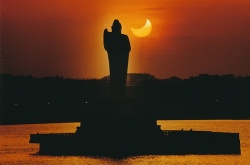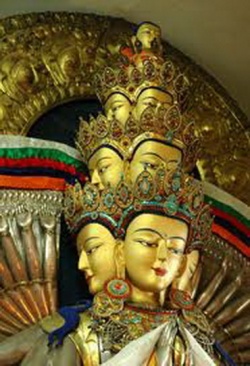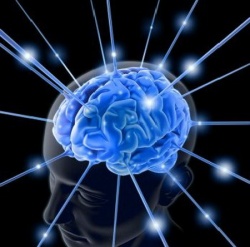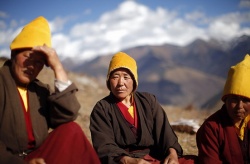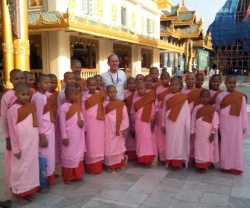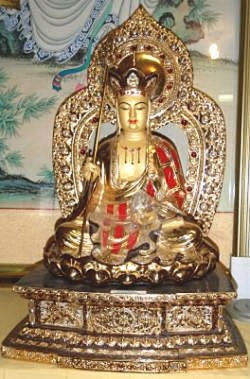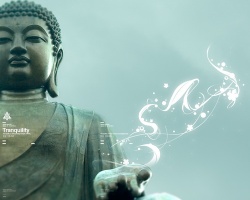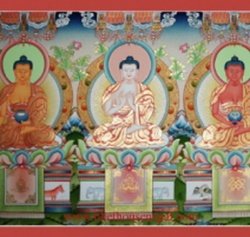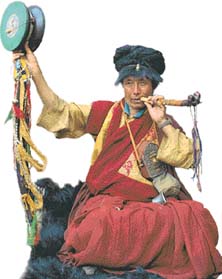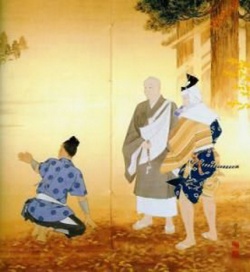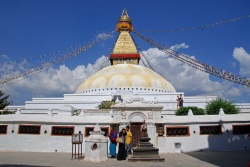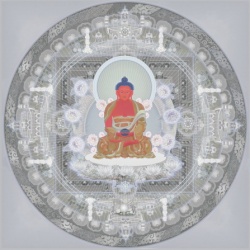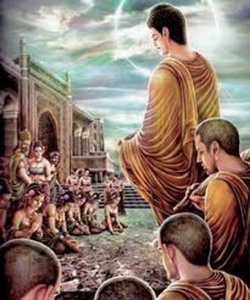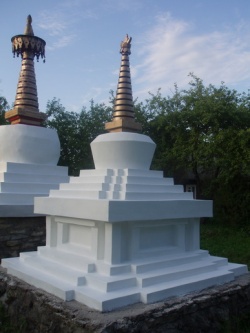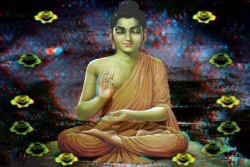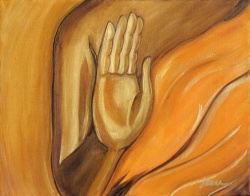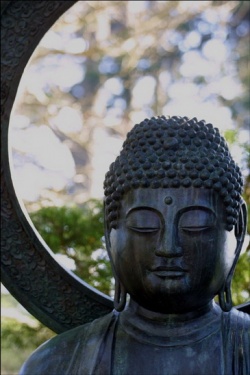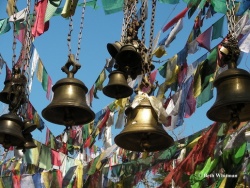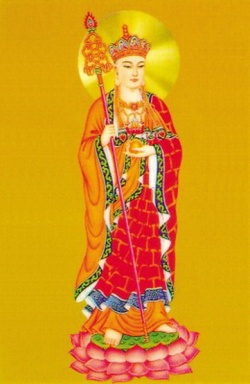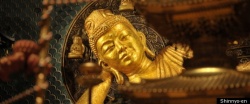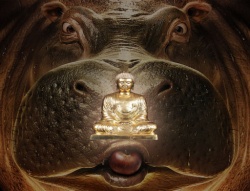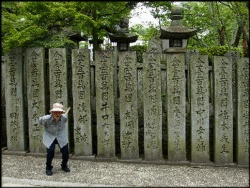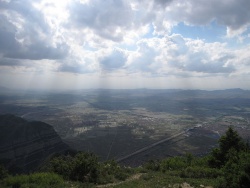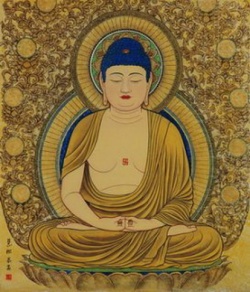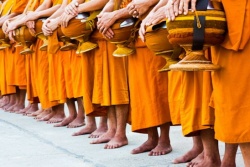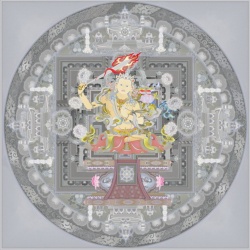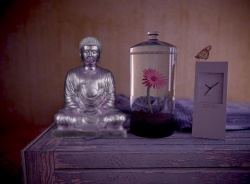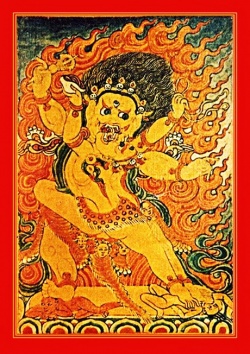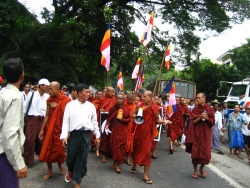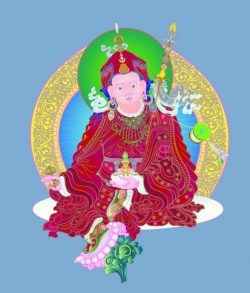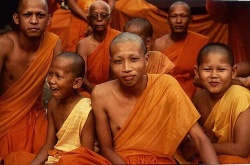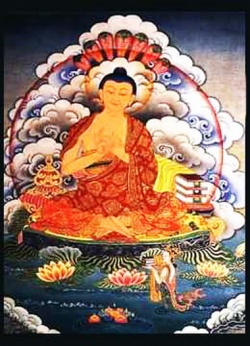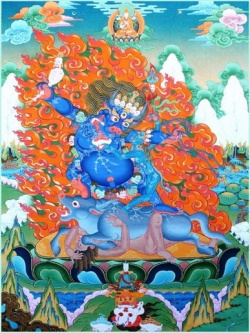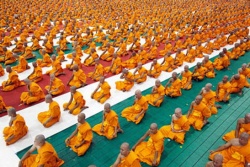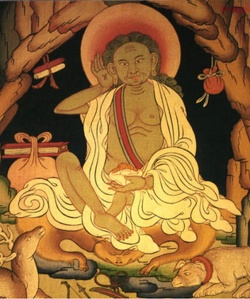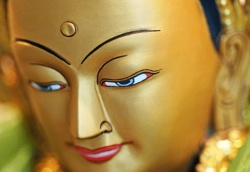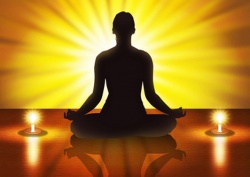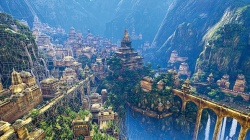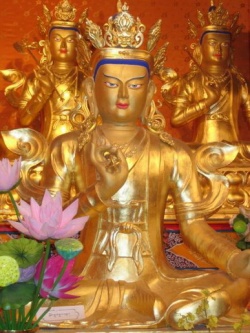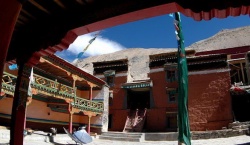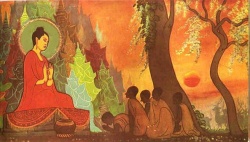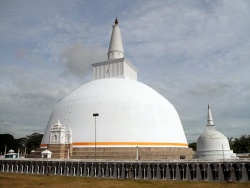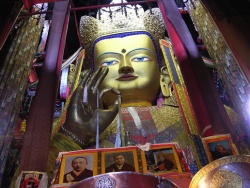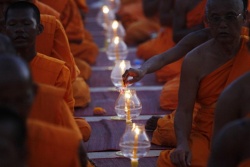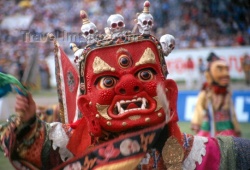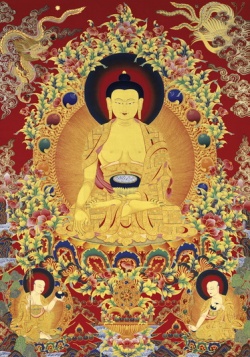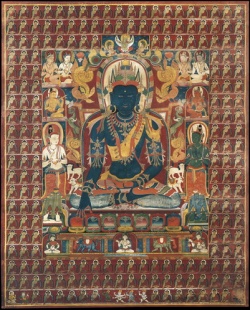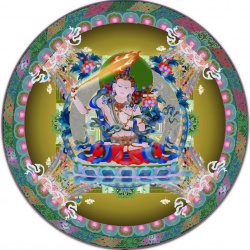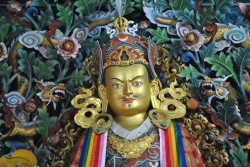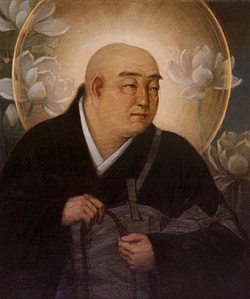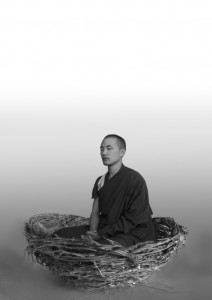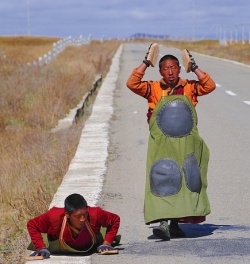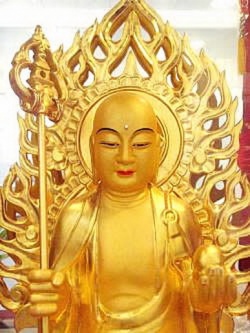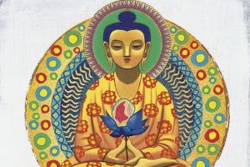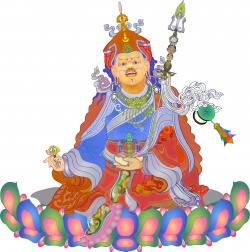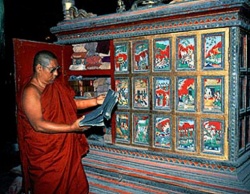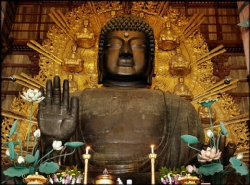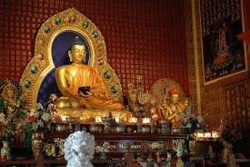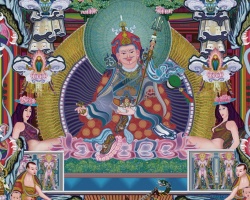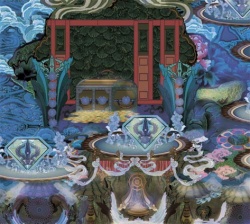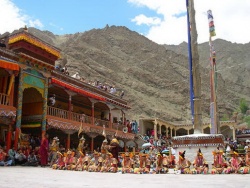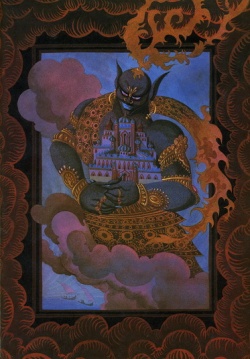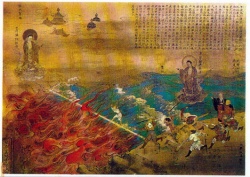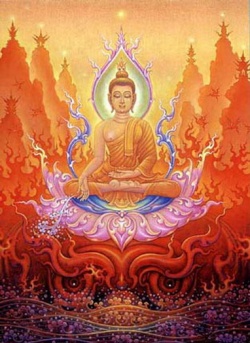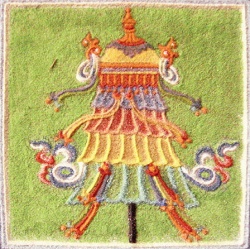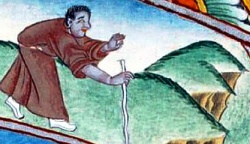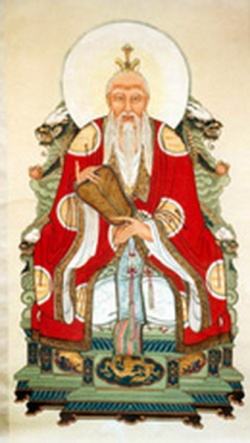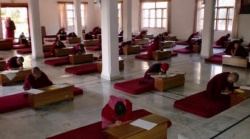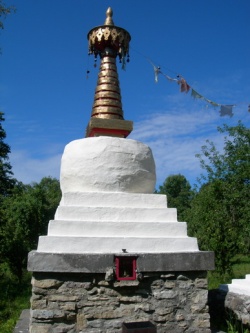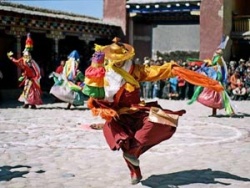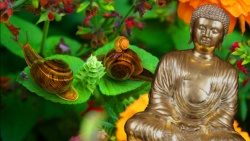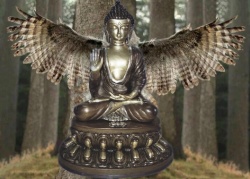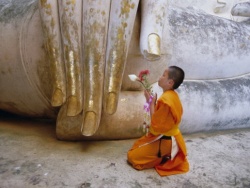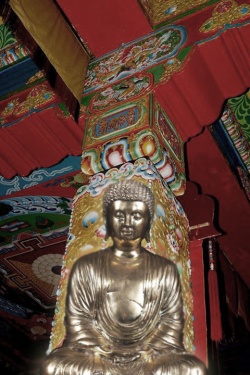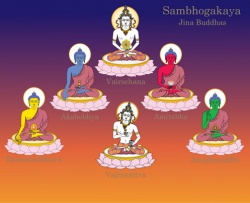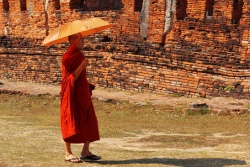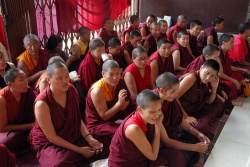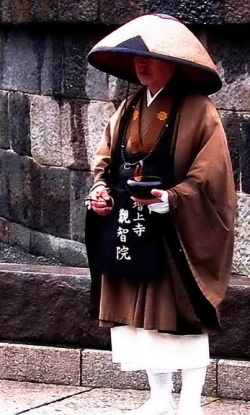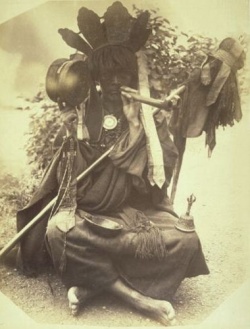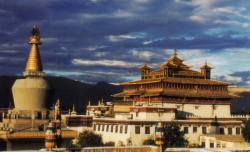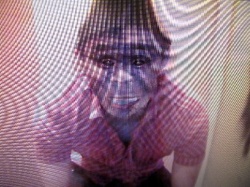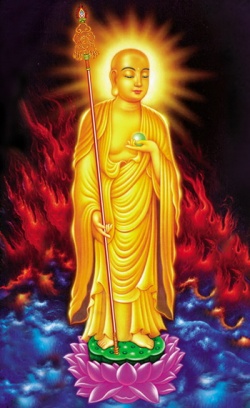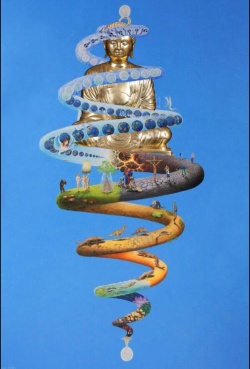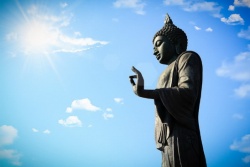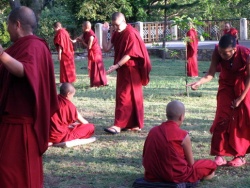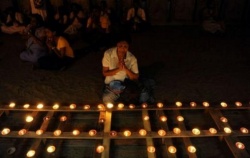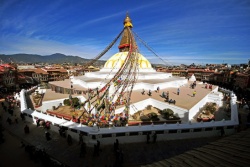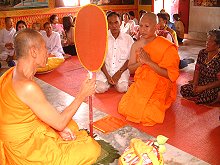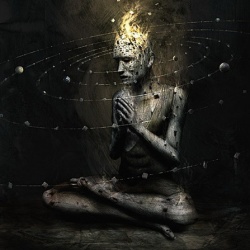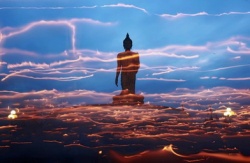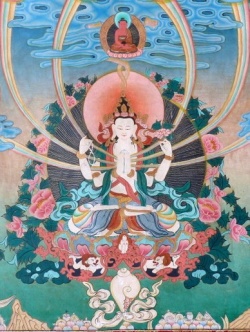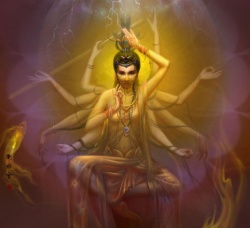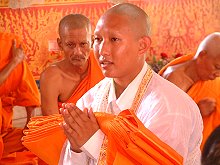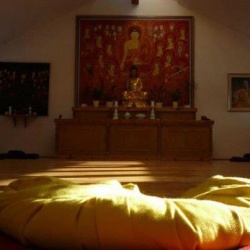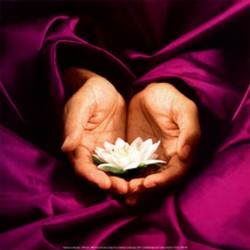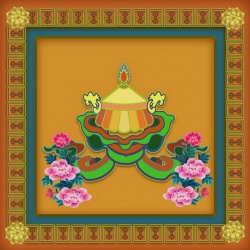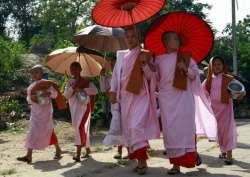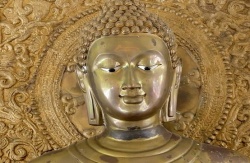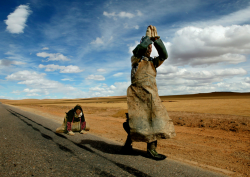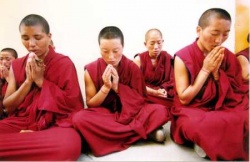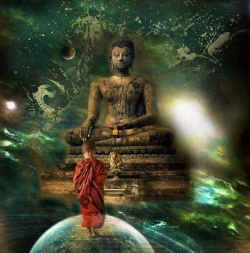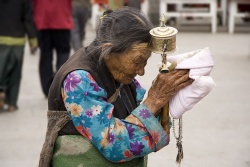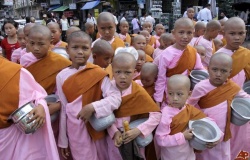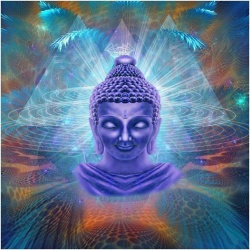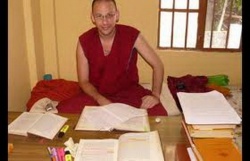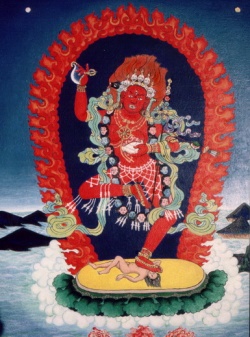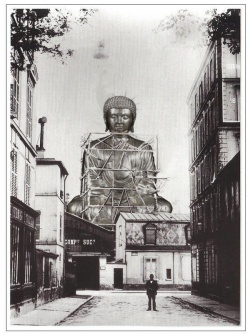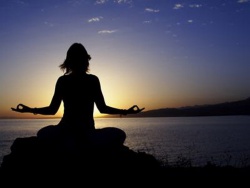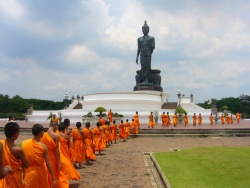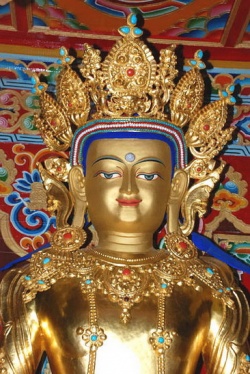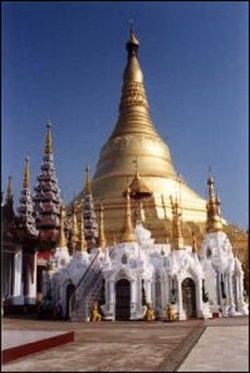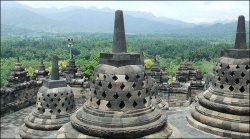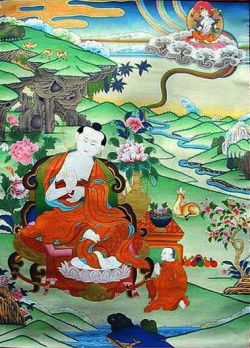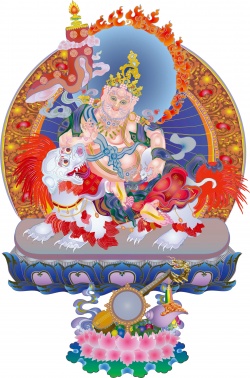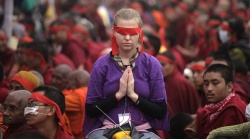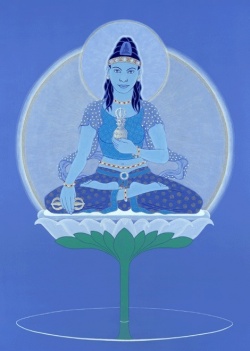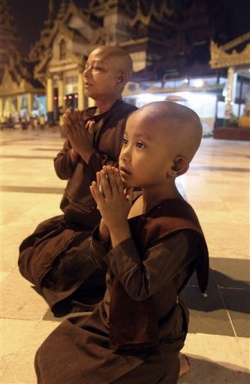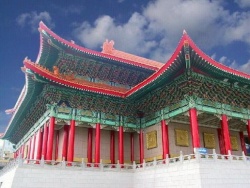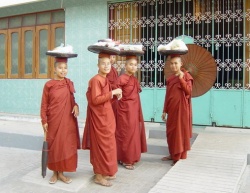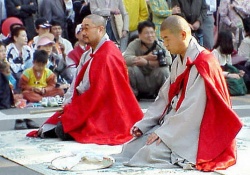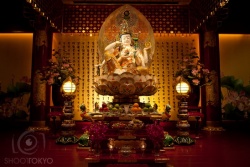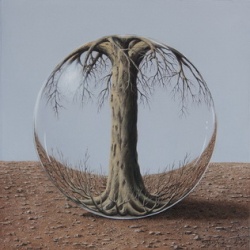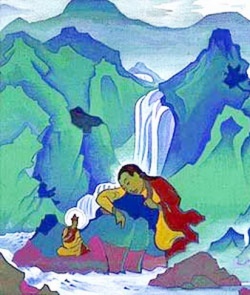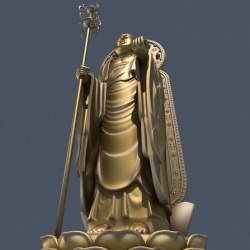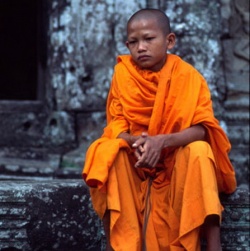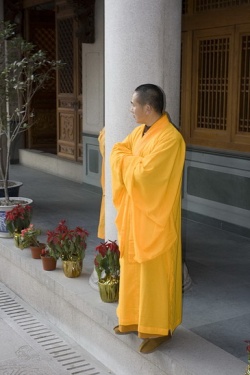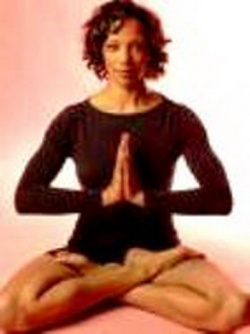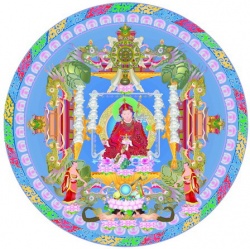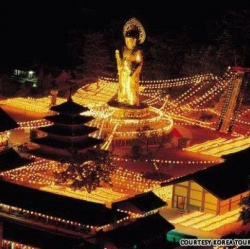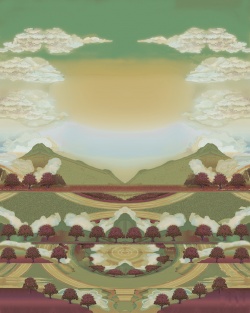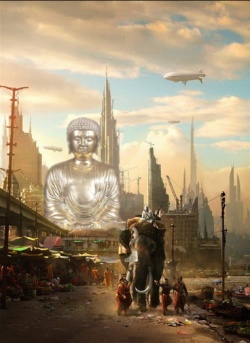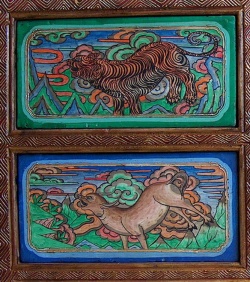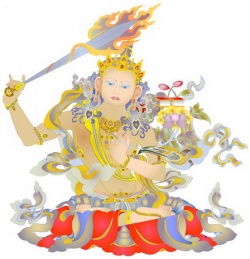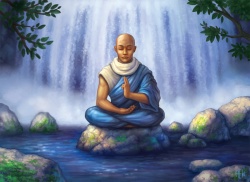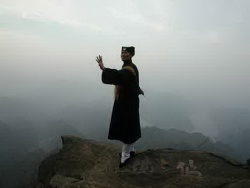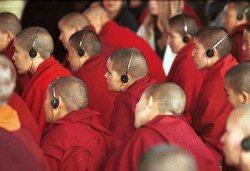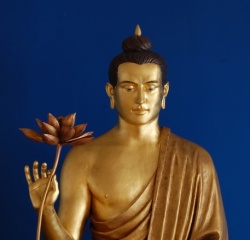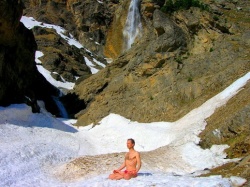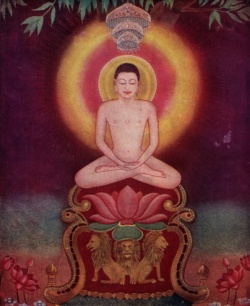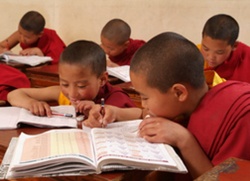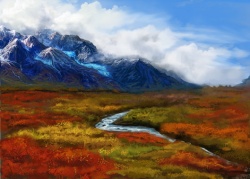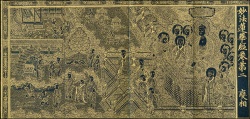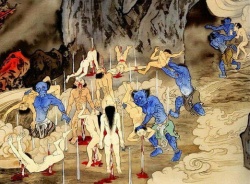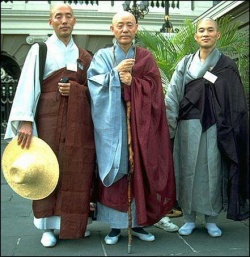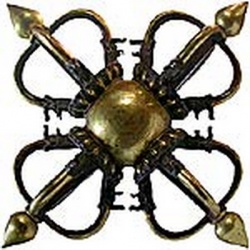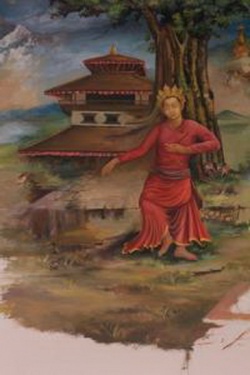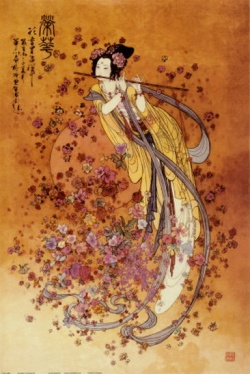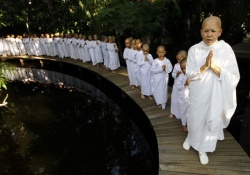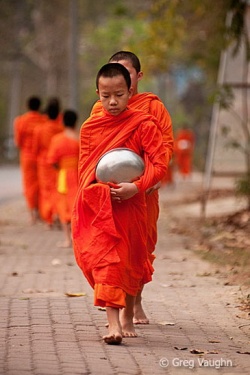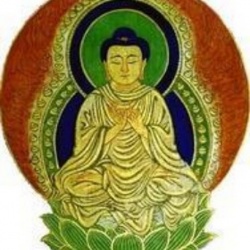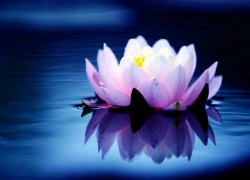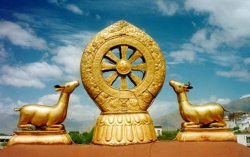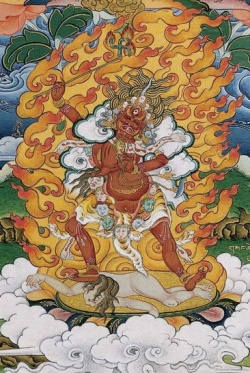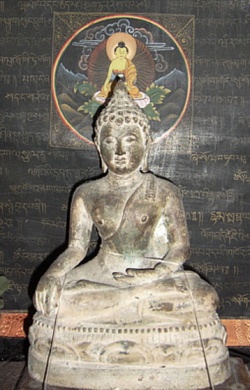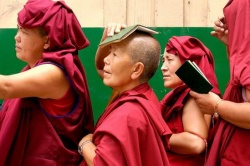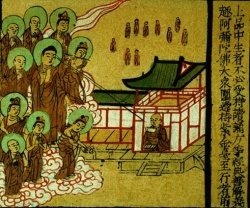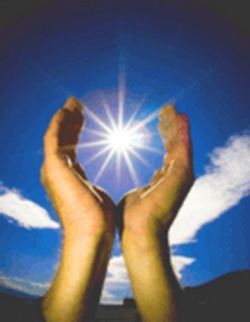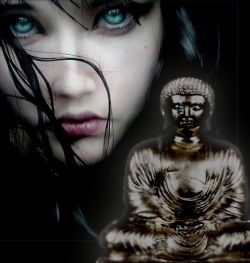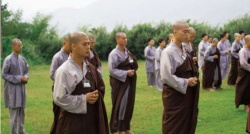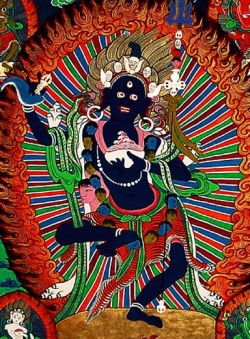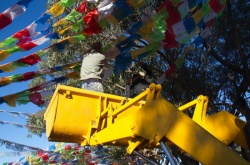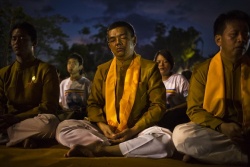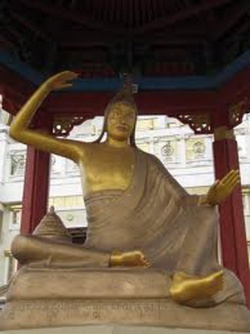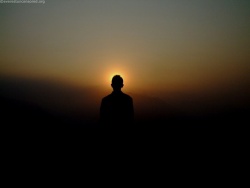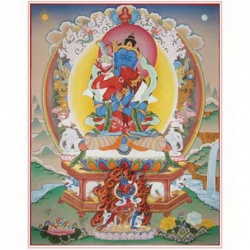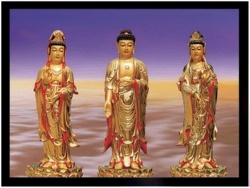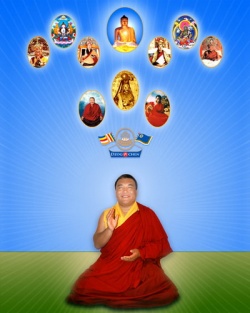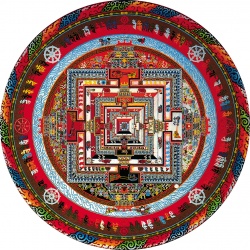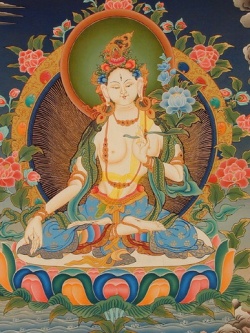The Flower Adornment Sutra: A Commentary by the Venerable Master Hsuan Hua: Chapter Nine
The Flower Adornment Sutra:
A Commentary by the Venerable Master Hsuan Hua
Chapter Nine: Light Enlightenment
Translated in the Tang Dynasty by the Tripitaka Master Srãmana Siksananda of Khotan
- Commentary
The previous chapter was the Four Holy Truths Chapter. This is the ninth chapter. This is the ninth chapter, the Light Enlightenment chapter. “Light” refers to Prajna. “Enlightenment” comes when living beings see this brightness and enlighten to their minds.
At that time, from the wheels on the bottoms of the World Honored One’s feet were released one billion bright lights which illumined the three thousand great thousand worlds. They also illumined a billion Jambudvipas, a billion Purva-Videhas, a billion Apara-Godaniyas, and a billion Uttarakurus. They illumined a billion great oceans, a billion wheel-ringed mountains, a billion Bodhisattvas being born, a billion Bodhisattvas leaving home, a billion Thus Come Ones accomplishing proper enlightenment, a billion Thus Come Ones turning the Dharma wheel, and a billion Thus Come Ones entering Nirvana. Also, a billion Sumeru, kings of mountains, a billion heavens of the Four Kings, a billion heavens of the Thirty-Three, and a billion suyama heavens…
- Commentary
At that time refers to the time when the light Enlightenment chapter was spoken. From the wheels on the bottoms of the World Honored One’s –Shakyamuni Buddha’s – feet were released one billion bright lights. The bottoms of the Buddha’s feet emitted light. The feet are the lowest place on the body. Light was emitted from the wheels on the bottoms of the Buddha’s feet. This represents wisdom that is most balanced; not too high or too low. So, from the soles of the Buddha’s feet was emitted a most precious light, which in turn let off a billion bright lights which illumined the three thousand great thousand worlds. It illumined the great trichiliocosm. What are the three thousand great thousand worlds? One world system is made up of one Mt. Sumeru, the four great continents, one sun, and one moon. A thousand of these world systems makes up a small world system. A thousand small world systems make up a middle world system. A thousand middle world systems make up a great world system. So, if you put together three of these thousand world systems you have the “three thousand great thousand worlds.”
They also illumined a billion Jambudvipas—they illumined the southern continent of Jambudvipa, A billion Purva-Videhas—the continent to the east, A billion Apara-Godaniyas—the continent to the west, and a billion uttarakurus—the northern continent. They illumined a billion great oceans, A billion wheel-ringed mountains, and a billion Bodhisattvas being born. One billion Bodhisattvas descend from the palace of the Tushita Heaven to be born. A billion Bodhisattvas leaving home. One billion Bodhisattvas leave home to cultivate. Also, there are a billion Thus Come Ones accomplishing proper enlightenment, a billion Thus Come Ones turning the Dharma wheel, and a billion Thus Come Ones entering Nirvana. Also, a billion Sumeru, kings of mountains, a billion heavens of the four kings, a billion heavens of the Thirty-Three, and a billion Suyama heavens. This is telling how many there are.
A billion Tushita heavens, a billion Bliss from Transformation heavens, a billion heavens of Comfort Gained from Others’ Transformations, a billion heavens of the Brahma multitudes, a billion Light-Sound heavens, a billion heavens of Pervasive Purity, a billion Vast-Result heavens, and a billion Ultimate Form Heavens. All of these were clearly revealed in this light.
Just as in this place one could see the Buddha, the World Honored One, seated on his lotus flower treasury lion’s throne, with Bodhisattvas as many as fine motes of dust in ten Buddhalands circumambulating him, so too, in each of the billion Jambudvipas, the billion Thus Come Ones were also seated in the same way.
Because of the spiritual power of the Buddha, in each of the ten directions there was a great Bodhisattva, who together with the Bodhisattvas to the number of fine motes of dust in ten buddhalands, came to the Buddha’s place. Their names were Manjushri Bodhisattva, Enlightened Leader Bodhisattva, Wealthy Leader Bodhisattva, Jeweled Leader Bodhisattva, Merit and Virtue Leader Bodhisattva, Vision Leader Bodhisattva, Vigorous Leader Bodhisattva, Dharma Leader Bodhisattva, Wisdom Leader Bodhisattva, and Worthy Leader Bodhisattva.
- Commentary
A billion Tushita heavens, a billion Bliss from Transformation heavens, a billion heavens of Comfort Gained from Others’ Transformations, a billion heavens of the Brahma multitudes, a billion Light-Sound heavens, a billion heavens of Pervasive Purity, a billion Vast-Result heavens, and a billion Ultimate Form heavens. All of these were clearly revealed in this light. In this state, all these heavens were revealed in the light.
Just as in this place one could see the Buddha, the World Honored One, seated on his lotus flower treasury lion’s throne—in the Saha world, the people could see the Buddha seated on his adorned Lotus Flower Treasury Lion’s Throne, with Bodhisattvas as many as fine motes of dust in ten Buddhalands circumambulating him, the Buddha—soo too, in each of the billion Jambudvipas, the billion Thus Come Ones were also seated in the same way.
Because of the spiritual power of the Buddha—They all relied on the Buddha’s awesome spiritual power. In each of the ten directions there was a great Bodhisattva. In every land in the ten directions there is a great Bodhisattva. Those who are lords in the Saha World are companions in the lands of the ten directions. Those who are companions to the Saha World are lords in the lands of the ten directions. Who together with the Bodhisattvas to the number of fine motes of dust in ten Buddhalands—in ten Buddhalands there are Bodhisattvas as many as fine motes of dust, who came to the Buddha’s place. They all arrived at Shakytamuni Buddha’s way place. Their names were Manjushri Bodhisattva, Enlightened Leader Bodhisattva, Wealthy Leader Bodhisattva, Jeweled Leader Bodhisattva, Merit and Virtue Leader Bodhisattva, Vision Leader Bodhisattva, Vigorous Leader Bodhisattva, Dharma Leader Bodhisattva, Wisdom Leader Bodhisattva, and Worthy Leader Bodhisattva.
These Bodhisattvas all came from their own countries, that is to say, the Golden Colored World, the Wonderful Colored World, the Lotus Flower Colored World, the Champaka Flower Colored World, the Utpala Flower Colored World, the Golden Colored World, the Jeweled Colored World, the Vajra Colored World, the Crystal Colored World, and the Equally Colored World. In the presence of the Buddhas, all these Bodhisattvas cultivated Brahma conduct.
- Commentary
These Bodhisattvas all came from their own countries. The great Bodhisattas have come from their own countries and arrived at the Way Place of the Buddha to listen to the Dharma. They made up the Buddha’s influential assembly. Each of them came from his own country, that is to say, the Golden Colored World—in the east the Wonderful Colored World—in the south, the Lotus Colored World—in the west –the Champaka Flower Colored World –in the north, the Utpala Flower Colored World –in the northeast, the Golden Colored World-–in the southeast, the Jeweled Colored World—in t he northwest, the Crystal Colored World—from below, and the Equally Colored World—from above. From all these worlds of the ten directions, the Bodhisattvas have come to the Avatamsaka Dharma Assembly in the Bodhimanda, to listen to the Buddha speak the Dharma.
In the presence of the Buddhas, all these Bodhisattvas cultivated Brahma conduct. “Bodhisattva” here, refers to all the great Bodhisattvas whose names were just mentioned. They are those who from many kalpas past have been cultivating the Bodhisattva Way and benefitting living beings. They’ve been with Buddhas for a long time and they extensively made offerings, respected, and praised all the Thus Come Ones. They very carefully cultivated pure conduct. At all times they returned the light and reversed the illumination to look within themselves. They kept themselves from being lax. They never were casual or ignored the rules.
“Brahma Conduct” refers to the cultivation of pure conduct. In cultivation of pure conduct one cuts off all defilements. When one purely cultivates Brahma Conduct one singlemindedly and sincerely cultivates. One doesn’t allow any confused thoughts to arise.
Cultivating purity is like sweeping the floor. When the house gets dirty you clean it. Or else you use a vacuum cleaner to pick up the dirt. Cultivating purity is also cleaning up the dirt. It’s just getting rid of deviant knowledge and deviant views, taming your crazy and wild mind, and your thoughts that break the rules. Clean them up! You know how to keep your house clean, but in your mind you have dirty false thinking and scattered thoughts which you don’t clean up. If you don’t sweep clean, you’ll never be able to cultivate the Bodhisattva Way.
At all times Bodhisattvas return the light and reverse the illumination. You should always bring forth the thought for enlightenment. If you do, then you’re purely cultivating Brahma conduct.
Specifically, Unmoving Wisdom Buddha, Unobstructed Wisdom Buddha, Liberation Wisdom Buddha, Awesome Deportment Wisdom Buddha, Understanding Marks Wisdom Buddha, Ultimate Wisdom Buddha, Superior Wisdom Buddha, Comfortable Wisdom Buddha, Brahma Wisdom Buddha, and Contemplating and Investigating Wisdom Buddha.
At that time, in the presence of all those Buddhas, the voices of the Manjushri Bodhisattvas in all those places, rang out in unison as they spoke verses:
- Commentary
The Bodhisattva draws near to Buddhas such as unmoving wisdom Buddha. This Buddha, in the Land of Still Eternal Light, is still and unmoving. But although he is still and unmoving, he pervades everywhere. He has proper and all-pervasive wisdom. And so his wisdom is extremely great. All of us are complete with the same unmoving wisdom as Unmoving Wisdom Buddha, but we have forgotten it. It’s as if we’re in a dream. All of our learning is useless. Unmoving Wisdom Buddha causes living beings to remember their own original still and eternal, unmoving wisdom.
Unobstructed wisdom Buddha. This Buddha has wisdom without obstruction, so he’s called Unobstructed Wisdom Buddha. Unobstructed wisdom is within everyone. There isn’t anyone who doesn’t have it. It’s not just this Buddha who has that wisdom. Even living beings have this kind of wisdom, but they don’t know how to use it.
Liberation wisdom Buddha. “Liberation” means not having any obstructions. One is truly free. All living beings also have this liberation wisdom. It’s only because we have attachments and false thinking that we can’t be liberated. We put liberation aside and don’t use it.
Awesome Deportment wisdom Buddha. All Bodhisattvas draw near to Awesome Deportment Wisdom Buddha. This awesomeness puts people in awe. It is deportment that can be emulated. It is a method that can be studied. Walking, standing, sitting, and lying down are the four great awesome deportments.
There’s a proper way to walk, stand, sit, and lie down. You should walk like the wind. Walk like a gentle breeze, not as fast and violent as a tornado. Be a gentle breeze. As it is said:
When a gentle breeze comes,
There’s not even a ripple on the water.
A gentle breeze is very slow, and so when it goes over water it doesn’t even make a ripple. So it says to be like a gentle breeze. Don’t make waves. Don’t make any ripples on the water. Be like a gentle breeze, but not like a tornado so that when you walk you knock everything over.
You should stand like a pine. Stand straight and strong like a pine tree.
You should sit like a bell, don’t sit like the clapper inside the bell and swing back and forth. Instead, you should sit without moving. You want to sit and quiet your mind so that you don’t have false thinking. You don’t want your body moving all over the place. When you sit and stand, your body shouldn’t move.
You should lie down like a bow. This is called the “auspicious lying position”. You lie on your right side and place your right hand under your head. Your left hand is placed on your left leg. When you lie in the “auspicious lying position” then everything is auspicious. Everything is good.
Awesome deportment can be explained in great detail. For example, in Confucianism. The three hundred rituals and three thousand deportments are discussed. In Buddhism we talk about the three thousand awesome deportments and the eighty thousand subtle practices. The eighty thousand subtle practices are the eighty thousand small movements that you can make. You should be careful about them all. When walking you want to be careful. When going in and out of the door and closing it, you want to be careful. You shouldn’t slam the door. Someone might be meditating and to him it’s just like a bomb going off. Such a sound causes meditators’ minds to move. It is said:
You can turn over he waters of a thousand rivers,
But don’t move the mind of one who cultivates the Way.
You can have the nerve to turn over the water in a thousand rivers, but you don’t want to causes the mind of one who cultivates the Way to move. The mind of one who cultivates the Way is like peaceful water that is without any waves. If you cause his mind to move, he might go insane. And if he goes insane it would be very easy for him to fall.
In every single movement you should be in accord with the three thousand awesome deportments and the eighty thousand subtle practices. You shouldn’t obstruct anyone else’s cultivation. This is the Buddha, Awesome Deportment Wisdom.
There is another Buddha called Understanding Marks Wisdom Buddha, and another Buddha called Ultimate Wisdom Buddha. This Buddha has ultimate wisdom—basic wisdom.
There is another Buddha called Superior Wisdom Buddha. This Buddha’s wisdom is outstanding. Another Buddha is called Comfortable wisdom Buddha. He manifests his prajna wisdom with self-mastery. And there is Brahma Wisdom Buddha. This Buddha has pure wisdom. Contemplating and Investigating Wisdom Buddha had Wonderful Contemplating and Investigating Wisdom.
At that time, in the presence of all those Buddhas, the voices of the Manjushri Bodhisattvas in all those places—In all those places” means that Manjushri Bodhisattva is able to pervade all places. He can go before the Buddhas in all the Way Places, so that in absolutely every Way Place Manjushri Bodhisattva is part of the influential assembly. But, you may ask, if his wisdom is already ultimate, why does he still go to the Way Places and become part of the influential assembly? It’s because he wants to cultivate his virtuous practices, to cultivate his blessings and wisdom. Although his wisdom and blessings are endless, he’s still not afraid of more. So, no matter what Way Place it is, he goes and joins the influential assembly. “In the presence of all those Buddhas” means there are numberless and boundless Manjushri Bodhisattvas. In all countries and in every world, in every Buddha’s Way Place, this Bodhisattva is present at each of the Dharma Assemblies. Someone wonders, “There are so many of these Manjushri Bodhisattvas, ultimately how many are there?”
This is a very good question. The text speaks of Manjushri Bodhisattva being in every place. Even so, there is only one Manjushri Bodhisattva. Yet in every Dharma Assembly, Manjushri Bodhisattva manifests a body to act in the influential assembly. Since he manifests in that way, couldn’t you say there were that many Manjushri Bodhisattvas? Yes, you could say that. But you could also say that his original substance is just one, and that his transformation godies are limitless and boundless. It’s not necessary for him to move to create his transformation bodies. It’s just that right in the original place, he’s compleete with all his transformation bodies. His original substance and all his transformation bodies are two and yet not two. Although you see that there are so many, there is really only one. This can be likened to the moonlight, which can stand for the Dharma-body of the Buddha. Every place that has water has the moonlight reflected in it. When we see all these reflections, is it really the case that there are that many moons? No, there is just one. But that one moon can manifest in all different places, and in all places it’s still just one. Bodhisattvas are just like this. The many are just one and one is just the many. There is no difference between them.
Another example would be a room full of mirrors. When you stand in the room, your body is reflected in all the mirrors. Your body gets divided yp and reflected in all the mirrors. Does that mean that your real body doesn’t exist? No. What appears in the mirrors is just a reflection, and the body you have doesn’t disappear. Yet for as many mirrors as there are, a corresponding number of bodies will manifest. This is another way to show how Manjushri Bodhisattva makes wonderful use of his spiritual penetrations to appear everywhere.
In the presence of all those Buddhas, Wonderfully Auspicious Bodhisattvas appear. Their voices rang out in unison as they spoke verses: They all started talking at the same time. They all spoke the following gathas. This kind of state is extremely miraculous!
If someone sees the one of proper enlightenment
As liberated and free from all outflows,
And as not being attached to all worlds,
That person still has not certified to the Way-eye.
- Commentary
All the Manjushri Bodhisattvas, in all the Buddha’s Way Places, speak about the relationship between Bodhi and affliction. Bodhi is the path of enlightenment, and afflictions are living beings’ karmic obstructions. Where do afflictions come from? They come from emotional desire. If you have afflictions, then you will have karmic obstacles.
So, Manjushri Bodhisattva wants to explain Bodhi and affliction to cause us living beings to understand how to cultivate Bodhi, the way of enlightenment, and how to leave afflictions.
If someone sees the one of proper enlightenment. This means one who pereceives the Buddha, the One of Proper Enlightenment. Perhaps this person sees the Buddha as liberated and free from all outflows.
What is liberation? Liberation is attaining true and actual freedom. When you’ve attained true and actual freedom then you’re liberated. Ultimately who is tying us up? There is no one who ties us up. You tie yourself up. How do you do that? You do it by having attachments and false thinking. Because you have false thoughts you have attachments, and because of your attachments you can'’ attain liberation. The Buddha is separated from all outflows. What are outflows? They'’e just people'’ bad habits and faults that they'’e amassed from beginningless time, life after life. That’s what is meant by “all outflows.”
If you like to drink wine, that’s a wine-outflow. If you smoke dope, then you have an outflow of smoking dope. People who are greedy for wealth have the outflow of wealth. And those who are greedy for beautiful form have the outflow of beautiful form. Outflows are insatiable. For example, eating is an outflow and wearing clothes is an outflow. When you like to sleep, that’s an outflow. Any state that you go along with and end up getting afflicted by is an outflow. If you have thoughts of desire, then you will have a lot of outflows. Outflows are just all our various bad habits and faults. This includes continually breaking the rules and doing things that are not in accord with the Dharma. That’s what is meant by outflows.
Some people hear this explanation of Dharma and give rise to false thinking. What kind of false thinking? They are opposed to what has just been expressed. They think, “You say that eating is an outflow, and that wearing clothes is an outflow, and that sleeping is an outflow. Then tell me, what isn’t an outflow? Eating is an outflow, but everybody has to eat. Nobody can go without eating. How can we eliminate that outflow? Nobody can go without wearing clothes, so, how can we get rid of that outflow? Nobody can go without sleep. How can we dispense with that outflow? If all those things are outflows, then how can anyone be without outflows? If one doesn’t eat, one dies. If one doesn’t wear clothes, one won’t get away with it. If one doesn’t sleep, one will soon find it’s just as important as eating and wearing clothes. If the outflows we must get rid of are those essential parts of our life, then I definitely object!”
I agree. There isn’t anyone who doesn’t need to eat, sleep, and wear clothes! Outflows means over indulgence in these things.
For instance, if when you eat, if you just eat your fill then that’s okay. You shouldn’t pay any attention to whether the food is good or bad. The important thing is not to have a lot of false thinking about what you eat, and then you won’t have any outflows.
If, on the other hand you eat something and then give rise to a lot of false thinking, then you will have an outflow. You think, “I wonder if what I ate today had any food value. I don’t know if I’ve had enough nourishment or not. Will the things that I’ve eaten help out my body or not?” On the one hand you eat, and on the other hand you have so much false thinking about it that even if you did eat something nourishing, you’d waste it all by false thinking. You may have put the food in your stomach but it all flows back out in your false thinking. If, when you eat, you stop when you’re full and you don’t have any false thinking about whether the food is good or bad, then you’re a person of the Way without any thoughts. “No thoughts” means that you eat and don’t have any false thinking. And if you do it in this way, then the nourishment will be endless and boundless. It’s just because of your false thinking that all the proteins and vitamins disappear.
This can be likened to a bowl with water in it. If there aren’t any cracks in the bowl then when you put water in it, the water won’t run out. It doesn’t have any outflows. But if there are cracks, then the water is going to leak out. People’s false thoughts are just like cracks in a bowl. If you don’t have false thinking, then you don’t leave any cracks for outflows.
Originally, you didn’t have any of these false thoughts. Why do you want to create some and start speculating about what the food tastes like and analyzing every bit of it for its vitamin content? No matter how much false thinking you have about what you ate today, by this time tomorrow when it has passed through your body, you certainly won’t want to eat it, no matter how good it was before.
If you don’t have any false thinking then the nourishment will stay in your body and will not flow out. But the more false thinking you have about it, the more of its energy-value you lose in outflows.
If you wear clothes in order to keep warm, that’s okay. But, if your objective in wearing clothes isn’t to keep warm, but rather to look good and to cause others to notice you, then that’s an outflow. As soon as someone pays attention to you, an outflow takes place. If you worry about whether your clothes are good or not, and keep wanting to change outfits, then there is an outflow. When you wear clothes you should only wear them to keep warm. Don’t have false thinking about them.
What’s the outflow of sleeping like? When it’s time to go to sleep, you lie there but you can’t go to sleep. Once you start false thinking, sleep runs off and you don’t know where to find it. You toss and turn and still you can’t go to sleep. Would you call this an outflow or not? It’s the outflow of sleep. And if you don’t get enough sleep then the next day you won’t have enough energy, because you used it all up false thinking all night.
Not getting enough sleep is an outflow and getting too much sleep is also an outflow. If you get just the right amount of sleep then there is no outflow. So, tell me now, which one isn’t an outflow? Eating? Sleeping? Wearing clothes? So what were you opposing? You basically don’t understand and because you’re so stupid you objected. That is really pitiful.
Not only are eating, wearing clothes, and sleeping outflows, but whatever you like is an outflow. Your temper is also an outflow. Worry, love, hate, and desire are also outflows. The seven emotions of :
are all outflows. But these outflows can be stopped. If you get to the place where you can flow and yet not flow, then you can be said to have no outflows. But having no outflows still does not mean you have really made it home, because if you have "outflows" then you still have something.
Basically there are neither outflows nor non-outflows and that’s the ultimate state.
- Happiness: means you really like something that you shouldn’t like. For instance someone’s death makes you really happy. You say, “ha,ha, that guy died.” You shouldn’t be happy when somebody dies.
- Anger: You see people who are following the rules and you get really angry and say, “Hey you stupid ones, why do you want to follow the rules?’ You shouldn’t get angry but you get angry anyway. You think “Why do you people who study Buddhism have to be so reliable and moral? You’re really stupid.” Scolding them is an outflow.
- Grief: Somebody is getting married and everybody is happy except you who cries instead. You say, “Oh why do you want to get married?” Now you tell me, is that an outflow or not? People really won’t like it if you do things like that. It’s really unsuitable to cry in this kind of circumstance. There’s no reason for you to cry, but you cry anyway. That’s an outflow.
- Fear: Somebody encounters an unfortunate situation and they’re terrified. Instead of comforting them, you say some totally unnecessary thing that is out-of-place. That’s not right.
- Love: One person meets another person and the first thing that they say is “I love you” They haven’t said anything else, and the first thing that they say to each other is “I love you.”
- Hate: Some people meet each other and before they’ve exchanged words they’ve already decided they hate each other. The first thing they say is “I hate you”. What’s the reason for this? There is none and they are wrong to feel this way. That is an outflow.
- Desire: If you conduct yourself in ways that are inappropriate and do things which aren’t in accord with the Dharma then this is an outflow.
If you use these seven emotions incorrectly then they are outflows. But the state that exists before these seven emotions arise is called the Middle Way. If you can be happy when it’s time to be happy, then there’s no outflow. To refrain from anger when the situation incites anger is best. Anger is a big outflow. If you can refrain from anger then you’ll very quickly open enlightenment. Whoever has a big temper will be slow to awaken. Your continual anger will frighten enlightenment away. Enlightenment will say, “Oh, you’re so angry, I can’t stay around here!” The only enlightenment that you’ll open is anger-enlightenment and that is not right. These are all different types of outflows. Now to resume Manjushri’s verses.
And as not being attached to all worlds, “Liberated and free from all outflows” refers to our inner aspect—inside you leave all outflows. “Not being attached to all worlds” refers to the outer aspects. Outside there are all worldly dharmas, and you are not attached to any of them. What are worldly dharmas? They are everything outside the body—all that has form and appearance—that is conditioned. All conditioned dharmas are like a dream and like the dew at dawn. So, the Vajra Sutra says,
All conditioned dharmas are like dreams, illusions, bubbles, shadows.
They’re like having a dream or a transformational state. They are like bubbles on the water and like shadows. They are also like early-morning dew drops or lightning flashes. They are false and not real. Since they’re false and not real then what’s there to be attached to ? So it says in the verse, “and as not being attached to all worlds.”
But even though inside you cut off all outflows, and outside you’re not attached to any conditioned dharmas, these two states are not ultimate. They areen’t ultimate because to cut off implies that one still has something which one has not yet cut off. There isn’t attachment and yet there is. Attachment and non-attachment are still opposing dharmas. You haven’t reached the absolute. To have no separation and no non-separation is the ultimate state. Not being attached and not being unattached is to really understand worldly dharma. To have no attachment and no non-attachment is to leave all marks. When there is no separation and no non-separation, you have to,
Sweep away all dharmas and leave all marks.
In the Buddhas’ states there is no separating or no not separating. They have leapt over all feelings and left all views. They have transcended all common feelings and gotten rid of the views of common people. That’s why their state is called inconceivable. This vstate is the basic substance of all Buddhas. If you say that all Buddhas have already left all outflows, then you still don’t understand the Buddhadharma. If you say that the Buddhas have already relinquished attachment to worldly dharmas, you again don’t understand the Buddhadharma. If a Buddha isn’t attached to worldly dharmas, then why does he dome to this world to teach and transform living beings? And yet if you say that he is attached to worldly dharmas, then why isn’t he as upside down as common people? He isn’t attached and he isn’t not attached.
He sweeps away all dharmas and leaves all marks. The path of words and language is cut off, and the process of the mind is stopped. He leaves all appearance and this is inconceivable.
If you say that he has left something, then you have set up a distinction between that which is left and that which is not left. So, it’s not ultimate. If you say that there is an attachment and a non-attachment you are still talking about opposing dharmas. That’s why the last line of verse says, that person still has not certified to the way-eye. If you see it this way then you have not certified to the ultimate, which is the eye that sees the Way. If you haven’t certified to the Way-eye then you don’t have true and actual wisdom.
If someone knows the Thus Come One’s body and marks do not exist,
And cultivates and attains this understanding,
Then that person will quickly become a Buddha.
- Commentary
If someone knows the Thus Come One’s Body and marks do not exist. “If someone” means let us suppose that there is such a person. Who “knows the Thus Come One’s” means that he knows how the Buddha accomplished Buddhahood. It also means that he knows how the Buddha cultivated, descended from the Tushita Heaven, entered the womb, dwelt in the womb, left the home life, cultivated the way, turned the Dharma Wheel, and entered Nirvana. He knows everything there is to know about how the Thus Come One in the past, cultivated on the causal ground. He knows that the Thus Come One’s “body and marks do not exist.” The Buddha basically doesn’t have any marks or appearance. There is nothing marked and there is nothing unmarked. The Buddha doesn’t have an appearance and yet he is not without an appearance. His substance and characteristics and empty and non-existent, because the Buddha’s body and marks pervade empty space and the Dharma Realm. They are not present anywhere and there is no place where they are not present. Although there is no place where they are, and no place where they are not, nevertheless his body and marks are quiet and still. They are so big that we people can’t see them, so we feel that they don’t exist.
And cultivates and attains this understanding. If you want to know why the Buddha’s body and marks don’t exist, you must cultivate all dharmas, and then you will be able to know that the Buddha’s body and marks do not exist. Even the Buddha had to cultivate to attain the state of non-existence of body and marks. If we want to understand we also have to cultivate, and then we can understand that the Buddha’s body and marks have no existence. But if you only use your mind to try to fathom it and say, “On, I understand,” then that doesn’t count. Your understanding is only superficial and you just have a sketchy idea of it all. You still don’t truly comprehend and understand. If you want to truly understand, then you have to cultivate.
If you’re someone who’s able to cultivate and attain understand then that person will quickly become a Buddha. This kind of person will very quickly accomplish Buddhahood. Why? Because he understands how the Buddha cultivated and accomplished Buddhahood, and so he too will be able to use the Dharma to cultivate. And if you can use the Dharma to cultivate, then it’s for sure you will very quickly accomplish Buddhahood.
If one can look upon this world with a mind that is unmoving,
And see Buddhas and living beings as the same,
Then such a one will accomplish supreme wisdom.
- Commentary
If one can look upon this world If you’re able to see all dharmas of this world with a mind that is unmoving, then right within worldly dharmas you awaken and attain transcendental dharmas.. What is of the world transcends the world. While in the world you transcend the world. It’s not that you leave the world to transcend the world. If transcendental dharmas were apart from this world, then you’d have to be two people to attain them. One person would be a common person and the other would accomplish Buddhahood. You’d have to two people. If you say you can only be one person, then tell me which one you are, the common person or the one who accomplished Buddhahood? You may think that you’re the common person. Well, he’s just a living being. You may think that you’re the person who accomplished Buddhahood. Well, he’s just a living being too. There’s no difference between them. So it says, “with a mind that is unmoving.” There is no discrimination or confusion. There’s no false thinking or attachment.
And see Buddhas and living beings as the same. You are one with the Buddhas of the ten directions and three periods of time. This line can be mistakenly read as “the Buddha’s body”, but that’s not what it means. It means that the Buddha and living beings are the same. It’s just that the Buddha has become enlightened and living beings are still confused. The enlightenment and confusion are different; living beings and the Buddha are the same. The Buddha is replete with great wisdom and living beings are full of ignorance and afflictions. When you look for other things, you won’t find so many, but if you look for afflictions then you’ll find that you have lots of them. Everybody has afflictions and gets angry.
But if you can see the Buddhas and living beings as the same, then such a one will accomplish supreme wisdom. You should know that common living beings and the Buddha are basically the same. It all depends on whether you cultivate or not. Transcendental dharmas and worldly dharmas are the same. If you understand, then worldly dharmas are just transcendental dharmas. If you don’t understand, then transcendental dharmas are worldly dharmas. It’s just in the space of a thought. If you turn yourself around, that is your basic original place. And it’s not to be found outside. One with Supreme Wisdom is one of great enlightenment—one with extremely great understanding. One of Supreme Wisdom is also another name for the Buddha.
If with regard to the Buddha and the Dharma
One’s mind is completely level and equal
And the two thoughts do not manifest,
Then one will realize the position which is hard to conceive of.
- Commentary
“The two thoughts” mentioned here are the thought of the Buddha and the thought of the Dharma, the discrimination between the Buddha and the Dharma. If there were no Dharma, then there wouldn’t be any Buddha; if there were no Buddha, then there wouldn’t be any Dharma. They are completely equal. If there weren’t any Buddha, where could Dharma come from ? If there weren’t any Dharma, then how could you accomplish Buddhahood? If with regard to the Buddha and the dharma . What if there were a person who regarded the Buddha and the Dharma with a mind which is completely level and equal. What does he understand? He understands the Buddha and the Dharma. He understands that they are equal, that they are one. It’s not that there is no Buddha or Dharma. If you said there is no Buddha or Dharma, then what Buddha could we believe in, and what Dharma could we believe in and cultivate? It’s true that when one reaches the state of Buddhahood, there is the Buddha and yet there’s also no Buddha. Basically this person himself is the Buddha, so what other Buddha is there? Since he has accomplished Buddhahood he doesn’t need the Dharma. Basically his theory is true, but you can’t say that until you’ve proved it yourself. When you reach the ultimate state where there is nothing left to cultivate and nothing left to certify to, then you can say, “there is no Buddha or Dharma.” But common people who just begin to cultivate can’t just casually say such things. If you say there is no Buddha or Dharma, then what Buddha and Dharma do you believe in? what do you have belief in? If you have reached that level, fine, but you can’t say that if you haven’t. Here, the text is referring to someone who has truly understood. He knows for himself: “Oh there’s no Buddha and no Dharma. There’s no Dharma and there’s no Buddha. The Buddha and Dharma are level and equal. They’re one. The Buddha is the Dharma, and the Dharma is the Buddha.” But, if you haven’t certified to that level and you say there is no Buddha and no Dharma, then you are one of those of outside ways who believe in dull emptiness. Those of outside ways sit there and think that there isn’t anything at all. They sit there and say, “Look at me.” What are they? They’re ghosts.
And the two thoughts do not manifest, The two thoughts are the Buddha and the Dharma. Thoughts of the Buddha and thoughts of the Dharma. It doesn’t mean that you’re only mindful of one particular Buddha or that you are only mindful of one particular Dharma. It means your thoughts of the Buddha and thoughts of the Dharma don’t appear. Your mind doesn’t discriminate between the Buddha and the Dharma. Without that discrimination than one will realize the position which is hard to conceive of. To “realize” means to travel to that place. I means to go step by step and actually walk to that place. The “position which is hard to conceive of” refers to the Buddha-position.
Question: If it’s the case that one does not create offenses if one explains the Dharma incorrectly, then what about the cultivator who became a fox immortal because he answered a question incorrectly?
Answer: Someone asked him, “Are great cultivators subject to cause and effect?” And he answered, “No”. All he said was no. But because of that, he turned into a fox spirit. It’s because he denied cause and effect. He said great cultivators aren’t subject to cause and effect. He said there was no cause and effect.
Question: Why did he say there wasn’t any cause and effect?
Answer: He gave the wrong answer and so he had to be a fox spirit for five hundred lives. After five hundred years as a fox, he went to listen to Dhyana Master Pai Chang lecture on the Sutras. He manifested as an old man and went to listen to the Dharma. One day after the lecture was over he didn’t leave and Dhyana Master Pai Chang asked him why he didn’t go. He said, “I want to go to your room and talk to you, and I don’t want everybody else to hear me.” Dhyana Master Pai Chang knew what he was all about, so he took the fox spirit to his room.
The fox spirit said, “I’m a fox.”
Pai Chang said, “You don’t have to tell me about yourself, I recognize you.”
The fox spirit said, “I used to be a cultivator. One day a person asked me if great cultivators were subject to cause and effect.”
Pai Chang said, “What did you say?”
He said, “I said they didn’t have to undergo cause and effect. It’s just because of saying that one sentence that I became a fox. I don’t understand what I said wrong. Are great cultivators subject to cause and effect?”
Pai Chang said, “Okay, now you ask me that same question.”
The fox spirit asked, “Please, Superior One, are great cultivators subject to cause and effect?”
Pai Chang said, “Great cultivators aren’t confused by cause and effect. You see, there’s just that little bit of difference in how you say it. You said there was no cause and effect and I said that they aren’t confused by cause and effect.”
When the fox immortal heard this he understood immediately and said, “Ah!” And he got rid of his fox body.
The next day Dhyana Master Pai Chang took the monks up into the mountains and sent the fox spirit off to rebirth.
The reason the fox spirit answered “no” was because he thought for a great cultivator, anything goes. He thought that if a great cultivator want to, he could kill people, start fires, eat people, have false thinking, do whatever he wanted to do, and not undergo any cause and effect. He was completely wrong.
Buddhism came to China during the Han Dynasty. After the Han there was the Chin Dynasty. After the Chin there was thee Sung, Chi, Liang, Chen, Northern Wei, Sui, and Tang Dynasties. During those several hundred years there weree lots of changes.
When Buddhism was transmitted to China, the dharmas of the three robes, bowl, and sitting cloth of a left-home person were all complete. But after a while during the Tang Dynasty things became complicated and messed up. Some left-home people didn’t wear the sash or even the robes. They were destroying the appearance of left-home people. So, at the time of National Master Ching Liang, the left-home people had this left-home-but-not-left-home, lay-but-not-lay appearance. The left-home people didn’t have a special appearance
National Master Ching Liang saw that this situation was not healthy so he made a vow to keep his three robes—the great robe, the seven-piece robe, and the five-piece robe—his eating bowl, and his sitting cloth with him at all times. In order to correct this fault among the Sangha, he made ten vows, the first of which was that he would not reject the appearance of a Sramana, or left-home member of the Sangha. He would adhere to even the supereficial aspects, even the outer appearances.
At that time there were lots of Sanghans-but-not Sanghans, lay-people-but-not-lay-people, who said that people didn’t need to receive the precepts and that people shouldn’t hold them. They said that if you held them in you heart, then that would be enough, so what need would there be to receive them?
They had these kinds of deviant knowledge and deviant views.
Even though they spoke this way they didn’t hold the precepts in their conduct. They didn’t receive the precepts and they didn’t hold the precepts, so basically there weren’t any precepts. Therefore, National Mster Ching Liang made a second vow that his mind would not oppose the precepts of the Thus Come One.
The people who were studying Buddhism at that time were not respectful towards the Sutras. So, his third vow was that he wouldn’t sit with his back to the Sutra of the dharma Realm. When he sat down, if there was an Avatamsaka Sutra around, he would sit facing the Avatamsaka Sutra no matter what time it was or what the circumstances were. He wouldn’t turn his back to the Avatamsaka Sutra. He said that he felt that it would not be respectful to turn his back to the Sutra. He did this in order to correct another fault of that time—that people were not respectful towards the Sutras.
The fourth vow that he made was that his feet wouldn’t tread on the dust of a nunnery. The “dust” spoken of here means that he wouldn’t go inside a Bhikshuni temple and walk on the ground. His feet wouldn’t go inside. But it isn’t because of this that he’s called Ching Liang (Peure Refreshment). His name comes from the place where he lived. Wu Tai Mountain is known as Pure Refreshment Mountain, so he took that as his title. He didn’t use his own name, which originally was Cheng Kuan.
His feet wouldn’t tread upon the soil of a nunnery. Not only would his legs not walk there or his feet not tread there, but his mind wouldn’t strike up false thinking about the place. All of these vows were made in response to the circumstances of his times.
His fifth vow was that his eyes wouldn’t look upon improper things. His eyes wouldn’t look at attractive things. For instance, movies, plays, and strip-tease are improper things. To look at any of these is to break the precepts. “Improper” means anything that is not in accord with the rules. For instance, if you’re a man and a woman goes by and you look the woman over, to check out whether she is beautiful or not, then you’ve violated the precepts. There’s a verse that explains how one should be:
The eye view forms outside, inside there is nothing.
The ears hear mundane sounds, but the mind doesn’t know.
If you’re not moved by external things that’s okay, then you can look and be however you want and there’s no problem. But, if in your mind you still have false thinking, then you shouldn’t look, because if you look, you’ll have even more false thing. This is very important and I’m afraid that a lot of people have forgotten it so I’ve spoken about it again.
If there is someone who sees the Buddha and living beings
As level and equal, and peacefully dwelling,
Yet without dwelling and without a place of entering,
Then that person will become one who is difficult to encounter.
- Commentary
If there is someone who sees the Buddha and living beings as level and equal, and peacefully dwelling, Living beings and the Buddha and the mind are all level and equal, and they dwell peacefully. This means they don’t move. Yet without dwelling and without a place of entering, although they dwell, at the same time they are without a place of entrance. If one can have this kind of view then that person will become one who is difficult to encounter. He will become a rare person, one who is hard to encounter. That person is a Buddha.
Forms and feelings are without number;
Thinking, process and consciousness are also like this.
If one is able to know this
Then one can become a great muni.
If worldly and world transcending views
Are leapt far beyond
And if one is well able to know all Dharmas,
Then such a one will accomplish great brilliance.
- Commentary
The five skandhas (form, feeling, thinking, process, and consciousness) are being referred to here. Form refers to beautiful forms. Feelings means being receptive. Thinking is false thinking. Process occurs when your false thinking doesn’t stop, but carries over into actuality. Consciousness refers to your discriminating mind. You discriminate between good and evil, existence and non-existence. So, if you can turn your consciousness so that it becomes wisdom, then everything will be okay. If you can’t turn your consciousness, then your discriminating mind will make lots of discriminations. That is your consciousness playing tricks. Forms and feelings are without number. The skandhas of form and feeling have no number. There’s no way to count them. Thinking, process and consciousness are also like this. The three skandhas of thinking, process, and consciousness are also like this. There’s no way to count them. There’s no way to represent them with numbers. If one is able to know this. If you’re able to know that forms, feelings, thinking, process, and consciousness are uncountable, then one can become a great muni. In the very near future you’ll become a great Muni, a person who has reached great extinction. Reaching great extinction is accomplishing Buddhahood. If you’re a person with proper knowledge and proper views and you don’t get caught up in forms, feelings, thinking, process, and consciousness, then you can transcend them and illumine and view the five skandhas as empty.
Then you’ll very quickly accomplish Buddhahood. People don’t become Buddhas because they revolve and turn within form, feeling, thinking, process, and consciousness. They don’t illumine and view form, feeling, thinking, process, and consciousness as empty. Knowing that they have no number is to know emptiness. If you can see them as empty, then you’ll very quickly accomplish Buddhahood.
If worldly and world transcending views are leapt far beyond. The Sixth Patriarch said,
The Buddhadharma is here in the world,
Enlightenment is not apart from the world.
To search for Bodhi apart from the world
Is like looking for a hare with horns.
The Buddhadrharma is right within worldly dharmas. If you think that you have to leave worldly dharmas in order to study transcendental dharmas, the dharmas of Bodhi, then you are mistaken. The Buddhadharma is right within the world. If you can open enlightenment without leaving worldly dharmas, then you have correctly understood. To leave worldly dharmas and look for transcendental dharmas is like looking for horns on a rabbit; it’s impossible. One who knows this transcends both worldly and the world transcending dharmas—both are leapt far beyond. The worldly and world transcending dharamas are leapt far beyond. And if one is well able to know all Dharmas. One is well able to understand, practice, and uphold all dharmas. Then such a one will accomplish great brilliance. Not long from now you will accomplish a storehouse of great, bright light—the great brilliance of the world transcending. This great brilliant light ultimately is Buddhahood.
If someone toward all-wisdom produces a mind of transference,
And sees the mind as not being produced,
Then such a one will obtain great renown.
Living beings are without production and also without extinction.
If one is able to obtain this kind of wisdom
Then one will accomplish the Unsurpassed Way.
Within one there are the limitless,
And within the limitless there is one.
If one understands that they mutually arise,
Then one will accomplish fearlessness.
- Commentary
If someone towards all-wisdom. It is necessary for you to be able to understand all Buddhas before you can have All-Wisdom. Produces a mind of transference, What does it mean to bring forth a Bodhisattva’s mind of transference?
- He makes transference from himself to others. He transfers his merit and virtue as a universal gift to all living beings in the Dharma Realm. He dedicates it to all living beings. If you can have All-Wisdom, then you may be able to see the Buddha. But if you have All-Wisdom, you should make a vow to use it to make transference to all living beings so that they too will be able to attain All-Wisdom. You should make transference from yourself to them.
- He makes transference from the cause to the effect. In the future everyone will obtain the fruit of Buddhahood. Now we are cultivating on the cause ground. The aim of this transference is to help living beings throughout the Dharma Realm accomplish the Buddha Way together.
- He makes transference of the specifics to the principle. We want to dedicate all our specific practices to the still, unsurpassed, and pure principle substance of all Buddhas.
- He makes transference from the small to the great. At present, the measure of our minds and thoughts is very small. We must make a vow that our minds will pervade the Dharma Realm, fill empty space, and include the ten thousand things. If we are now cultivating the Dharmas of the Small Vehicle, then we should dedicate our practice to the Great Vehicle. There are all kinds of transferences.
If one brings forth a mind of transference and sees the mind as not being produced. Although you make transference, you should do it as if nothing were going on. You shouldn’t be attached to your transference. When we make transference we do it because that’s what we’re supposed to do. You should look at your mind as not having brought forth the thought of transference. Otherwise, you will become attached. You should smash through the merit and virtue that you get from your transference. If one can be free of such attachments then one will obtain great renown. In the future, it will be possible for one to become a person with great renown.
Living beings are without production. If you understand the true mark of all dharmas, then the Buddha is not produced or destroyed, living beings aren’t produced or destroyed. The Buddha, the mind, and living beings aren’t produced or destroyed. If you’re able to understand this principle, then you’ll be also without extinction. When you’re without production, then you also aren’t destroyed. If one is able to obtain this kind of wisdom. If you’re able to get this kind of wisdom, then you won’t have any attachments. You don’t have any self or anything that belongs to the self. There’s no one cultivating and nothing that is cultivated. Therefore, you’re able to have this kind of wisdom. If one has this kind of wisdom, Then one will accomplish the unsurpassed way. One should be able to accomplish the unsurpassed Buddha fruit.
Within one there are the limitless and within the limitless there is one. One is few; the limitless are many. But the many are not just many and the one is not just one. One spreads out into many and the many return to one. Therefore, the one gives rise to the limitless. So the one is not just one and the limitless are not just limitless. They mutually produce each other, and they are mutually unobstructed. Therefore, within the one are the limitless. Where do the limitless come from? They come from the one. If there is no one, then there can be no limitless. And if there are no limitless, then there can’t be a one. And if there’s no one, then that’s zero. So, within the limitless there is the one. Within the limitless you’ll be able to understand the one. The one produces the limitless and the limitless returns to the one.
If one understands that they mutually arise. You should understand that they mutually arise, that the one produces the limitless and the limitless returns to the one. Then one will accomplish fearlessness. If you understand this principle, then you’ll very quickly accomplish fearlessness. A fearless person at the very least is a great Bodhisattva and ultimately will become a Buddha.
At that time, light passed through this world and everywhere illumined ten Buddhalands in the east. It was also like this in the south, west, north, the four intermediate directions, as well as above and below. Within each of those worlds there were a billion Jambudvipas, reaching up to a billion Ultimate Form heavens. All of these were clearly revealed in this light.
Just as in this place one could see the Buddha, the World Honored One seated on his lotus flower treasury lion’s throne, with Bodhisattvas as many as fine motes of dust in ten Buddhalands circumambulating him, so too, in each of those billions of Jambudvipas there were billions of Thus Come Ones seated in the same way.
Because of the spiritual power of the Buddha, in each of the ten directions there was a great Bodhisattva, who was accompanied by Bodhisattvas to the number of fine motes of dust in ten buddhalands, who came to the Buddha’s place.
Their names were Manjushri and others. They came from countries called Golden Colored World and others and the Buddhas they served were called Unmoving Wisdom Thus Come One and others.
At that time, in the presence of all those Buddhas, the voices of the Manjushri Bodhisattvas in all those places, rang out in unison as they spoke verses:
- Commentary
At that time is the time when Manjushri Bodhisattva finished speaking his verse. Light passed through this world and everywhere illumined ten Buddhalands in the east. The light emitted from the bottom of the Buddha’s feet illumined all worlds. It went beyond this world to ten Buddhalands in the east. In every country there was a Buddha. It was also like this in the south, west, north, the four intermediate directions, as well as above and below. They too were illumined by the Buddha’s light. Within each of those worlds there were a billion Jambudvipas, reaching up to a billion Ultimate Form heavens. All of these were clearly revealed in the light. The light illumined Jambudvipa, reaching up to the Ultimate Form Heaven. That means it passed through lots of heavens. It went through the Suyama Heaven, the Trayastrimsha Heaven, the Heaven of the Four Kings, right up through a billion heavens. They were all revealed in this light.
Just as in this place one could see the Buddha, Thee World Honored One. In the Saha World they saw the Buddha seated on his lotus flower treasury lion’s throne, in full lotus, with Bodhisattvas as many as fine motes of dust in ten Buddhalands circumambulating him. They circumambulated the Buddha. So too, in each of those billions of Jambudvipas there were billions of Thus Come Ones seated in the same way. They were all just like the Buddha in the Saha World. Shakyamuni Buddha was seated in the Saha World, and in all other places it was exactly the same. The Bodhisattvas all saw Shakyamuni Buddha’s Dharma body. What is this state like? It’s like having lots of mirrors. One person can stand in front of the mirror and lots of bodies will be reflected in the mirrors. When the Buddha speaks the Dharma from worlds as many as motes of dust, it’s as if there is a mirror image of him in each world. That is how the Buddha manifests his body. Therefore, all living beings can see him turn the Dharma Wheel.
Because of the spiritual power of the Buddha, in each of the ten directions there was a great Bodhisattva. In every one of the worlds of the ten directions, there was a great Bodhisattva, who was accompanied by Bodhisattvas to the number of fine motes of dust in ten Buddhalands. Each of the great Bodhisattva leaders had with him other great Bodhisattvas to the number of fine motes of dust who came to the Buddha’s place. They all went to Shakyamuni Buddha’s Way place.
Their names were Manjushri and others. They came from countries called Golden Colored World and others. The Bodhisattvas came to those countries to help the Buddhas turn the Dharma Wheel. What were the Buddhas called? The Buddhas they served were called unmoving wisdom Thus Come One and others.
At that time, in the presence of all those Buddhas, the voices of the Manjushri Bodhisattvas in all those places. There was a Manjushri Bodhisattva in each of the Buddha’s Way Place, they rang out in unison as they spoke verses: What comes next will be the verses that they speak.
Living beings without wisdom are injured and poisoned by the thorn of love. To cause those people to seek Bodhi is what the Buddhadharma is for.
- Commentary
What are the causes and conditions that bring us living beings to this Saha World? It’s all because of love. For this reason, it’s said:
If your love weren’t heavy, then you wouldn’t be born in the Saha.
If your karma isn’t emptied, then you won’t be born in the Pure Land.
Even though love facilitates the arisal of all afflictions, beings are fond of love. They don’t object to it at all. Now, it’s not that we are prejudiced and say that love is not good. We approach the subject with a spirit of investigation so we can understand the other side of love. It has harmful aspects. In this verse, Manjushri Bodhisattva uses his great compassionate mind to let flow forth the unsurpassed wonderful flavor of sweet dew and ghee. He uses straightforward wisdom to tell us about this. The first line of the verse refers to living beings without wisdom. Why are living beings so upside down? Why do they do so many confused things? It’s because their ignorance is severe. As soon as we have ignorance we give rise to activity. Then activity conditions consciousness, consciousness conditions name and form, name and form condition the six entrances, the six entrances condition contact, contact conditions feelings, feelings condition love, love conditions grasping, grasping conditions becoming, becoming conditions birth, birth conditions old age and death. These are the twelve causes and conditions. They mutually unite with each other and arise.
The verse refers to the thorn of love. In the Sutra of 42 Sections it says,
Not satisfied with one delicious helping, they lick the honey off the blade of the knife and so cut their tongues.
This is just one of many analogies that can be used in talking about love.
- Love is like an unpaid debt. You are in debt. You owe somebody some money and you don’t pay it back. What does this illustrate? It illustrates how the Sound Hearers and Those Enlightened to Conditions, those of the Two Vehicles, haven’t cut off desire. Habits of desire are our faults that haven’t been cut off. Not having cut off our habits is like not having paid back a debt. So, cultivators must understand how fierce the thorn of love is.
- Love is like a rakshasa ghost-woman. Rakshasa ghosts are really poisonous. When a child is born to her, the Rakshasa ghost-woman eats it. When she finishes eating the Rakshasa child then she eats her husband. This is an example of how love causes people to be born and die. From birth and death you fall into the three evil paths of the hells, hungry ghosts, and animals.
- Love is like a wonderful lotus flower whose roots are hiding a poisonous snake. Someone admires the lotus flower and wants to pick it. But with the poisonous snake there it is possible that he will receive a fatal bite. It’s really fierce! Love is the reason that people can’t avoid the poisonous snake of birth and death. And so it causes them to fall into the three evil paths.
- Love is like a disagreeable food. When one doesn’t like to eat a certain food but forces oneself to eat it anyway, one can sometimes get sick from it, and even die.
- Love is like a prostitute or libertine. These kinds of people can destroy your wholesome dharmas. You are captured by the ghost of impermanence and carried off to death.
- Love is like a Mleccha. A Mleccha causes disruption among common people. He confuses them so they become upside down and end up dying.
- Love is like an infected sore. This is the analogy that pertains to the line of verse quoted above. This thorn of love is like a sore that is infected. If one doesn’t cut away the bad flesh then the sore will become infested with worms. These worms will cause the sore to get worse everyday until it reaches the point that it eats away the wisdom-life of your Dharma body, and you lose your senses. Why don’t you have any wisdom? It’s because of this thorn of love. It’s because you’ve been injured by this thorn of love.
- Love is like a destructive wind. If you pay a lot of attention to love then it’s like a destructive wind. It’s like a hurricane or a typhoon. Every time there’s a hurricane or typhoon they name it Miss so and so. It’s not called Mr. Hurricane so and so. Why is this? It’s because young women’s tempers are really big. Wives’ tempers are also like this. For no reason they get angry. And that’s why hurricanes are named after women. None of them are called Mr. Because most husbands are afraid of their wives. They don’t dare open their mouths. So, these people who want to leave home are probably that way because they are afraid that they will have to get married and have a wife. If it weren’t like that then why would they want to leave home? And the Bhikshunis who leave home are afraid of having husbands and children. This isn’t just a joke. This principle is very true.
- Love is like a comet. This analogy is even fiercer! When a comet comes it causes lots of disasters. It causes people to be poor and have sickness. It causes loss of crops and many people starve to death.
So, love has these nine unbeneficial aspects. Some people hear this and get really angry and think, “This is completely wrong!” Then just act like you didn’t hear it. The verse says that living beings without wisdom are injured and poisoned by the thorn of love. People are harmed by this poisonous thorn of love. To cause those people to seek bodhi is what the Buddhadharma is for. It’s for these kinds of living beings who don’t have any wisdom and who have been poisoned by the thorn of love that the Buddhas speak the Dharma. They speak so living beings will seek the Bodhi mind. All the Dharmas that the Buddhas of the ten directions and the three periods of time speak are for this sole purpose. So, you must cut off desire and get rid of love. To cut off desire is to transform the love and desire in your heart. You don’t have to cut it off. You transform it. What do you transform it into? You transform it into the Bodhi mind. Love and desire are stupidity, and the Bodhi mind is enlightenment. You change your heart so that it becomes enlightened wisdom. The Dharmas that all Buddhas speak to take living beings across are about just this.
Universally observe all Dharmas and renounce the two extremes. The Way accomplished, one never retreats, and turns this unequalled wheel.
- Commentary
Universally observe all Dharmas. “All Dharmas refers to form dharmas, mind dharmas, dharmas pertaining to the mind, non-interactive dharmas, and unconditioned dharmas—all of which should be universally observed. That’s generally speaking. If you were to go into detail it refers to all the 84,000 Dharmadoors. You should universally obtain samadhi and recognize all dharmas.
To recognize all dharmas you must cultivate the Middle Way and renounce the two extremes. The two extremes are emptiness and existence. Don’t fall into emptiness or existence. This is the middle Way. If you lean towards emptiness then you are one-sided. And if you lean towards existence then you are too far to the other side. You don’t want to become attached to the two prejudices of emptiness and existence. Renounce them both.
The Way accomplished, one never retreats. If you’re able to see through to the real mark of all dharmas, then you can cultivate the final meaning of the Middle Way and be certified to the substance and principle of the Middle Way. To accomplish the Way you must never reetreat, and then you’ll never fall. You will certify to the three kinds of non-retreat.
- non-retreat from position
- non-retreat from practice
- non-retreat from mindfulness
Non-retreat from position: If you are cultivating the Bodhisattva Way, then you shouldn’t retreat to the Way of the Two Vehicles. Non-retreat from practice: You’re always vigorous and never rest. You never run back. You always run forward. So, when you cultivate the non-retreat in practice you are courageously vigorous. At all times you are vigorous. You never rest in your cultivation of vigor. Non-retreat in mindfulness: You are mindful of bringing forth the Bodhi mind. You don’t retreat to the Two Vehicles, and become a self-ending Arhat. You want to universally benefit living beings, and turn this unequalled wheel. The Buddha constantly turns the incomparable great Dharma Wheel. It’s an extremely high, unsurpassed Dharma Wheel which can cause people to become Buddhas.
Throughout inconceivable kalpas
vigorously cultivate all practices
in order to cross over all living beings.
This is the great immortal’s strength.
- Commentary
People who study the Buddhadharma don’t have the strength of persevering vigor. Their vigor only lasts about five minutes then they get tired and sloppy. That’s why we keep turning in the six paths—coming and going; going and coming back again. Sometimes people fall into the hells; sometimes they become hungry ghosts; sometimes they aree animals; sometimes they get born in the heavens; sometimes they become asuras; and sometimes they get to be people. But it’s not so easy to become a human being. Once, when Shakyamuni Buddha was in the world, he picked up a handful of earth and asked his disciples: “Tell me, is there more dirt in my hand or on the earth?” His disciples said, “Obviously, the dirt in the Buddha’s hand is much less than the amount on the great earth. It’s perfectly clear.” The Buddha said, “Do you realize that the number of beings who are able to obtain a human body are like the amount of dirt in my hand compared to the amount of dirt everywhere else on the earth. The dirt on the earth represents those beings who have lost a human body.”
We’ve been lazy for an incredible number of kalpas and we haven’t been vigorous when it comes to the Buddhadharma. We harbor doubts and so when we encounter the Proper Dharma we still don’t know that we should cultivate it. But when we encounter a deviant teaching we take a knife and sharpen our heads to a point and drill right into it. We knock ourselves out being vigorous over it. The Buddha wasn’t like that. Throughout inconceivable great kalpas, he would vigorously cultivate all practices. He was vigorous every moment. Throughout the six periods of the day and night he was persistently vigorous in cultivating all Dharma-doors in order to cross over all living beings. The Buddha wanted to save living beings, so he set out and accomplished Buddhahood. After he became a Buddha, he had the power which he needed to teach and transform living beings. This is the great immortal’s strength. The “Great Immortal” refers to the Buddha.
The guiding master subdues the multitudes of demons,
he is courageous, strong, and invincible.
Within the light he proclaims the wonderful meaning.
He is this way because of his kindness and compassion.
- Commentary
The guiding dmaster subdues the multitudes of demons, the “Guiding Master” refers to the Buddha. He is a guide for living beings. He leads those who are deviant back to the proper. He leads those who are evil back to the good. He leads those who are wrong back to the right. He keeps them from going down wrong paths and leads them down the proper path. He leads living beings to end birth and cast out death. He leads living beings to leave to end birth and cast out death. He leads living beings to leave the darkness and return to brightness. He leads living beings to forsake the extremes and cultivate the middle. You could also say that he leads them from the phenomena to the noumenon. All of these are the strengths of the Guiding Master. This Guiding Master is Shakyamuni Buddha.
Before he accomplished Buddhahood, he subdued the multitudes of demons. At the time when the Buddha was accomplishing Buddhahood, the Demon King Papiyan became really afraid. He sai, “Ah, one more person is becoming a Buddha and so the Buddha’s strength is increasing by one and the demon’s strength is decreasing by one.” Papiyan mustered up all of his spiritual penetrations in order to destroy the Buddha’s karma in the Way. He got together all his demonic following. There were demonic citizens, demonic soldiers, demoniic women, and all the others. They surrounded the Bodhimanda and filled up the place. Their aim was to give the Buddha trouble. They wanted to destroy the Buddha’s karma in the Way. But at that time, the Buddha had entered the Unconquerable Compassionate Mind Samadhi, and emitted the white hair-mark light which shone in all directions. And from within the white hair-mark he emitted all kinds of bright light. In all these different kinds of light there manifested transformation Buddhas. The light shone as far up as the Heaven of the Thirty-three and as far down as the Avici hells.
Since the Buddha had entered the Compassionate Mind Samadhi, a great state of concentration, the light from his white hair-mark penetrated the hells. At that time all the demon kings, demon children and grandchildren, the retinues of demons, the demon soldiers, and the demon citizens felt that they couldn’t open their eyes. They couldn’t even lift up their heads, they appeared to be old and haggard, on the verge of death. In that shape they couldn’t fight and so they retreated.
Next, Papiyan sent three demon women who were extremely beautiful and enticing. They were supposed to disturb the Buddha’s concentration, but the Buddha kept emitting light from his white hair-mark and illumining the hells with it. Then the demon women looked at each other and saw that they too had turned into ugly old bags. Impurities were constantly flowing from their nine apertures. Their noses ran with snot, matter was in their eyes—they were filthy. Each was hugging a dead child in her arms and behind them trouped a bunch of demon women, also on the verge of death. When they saw themselves in this way, each brought forth great shame. They wanted to vomit at their own stench and ugliness. How could they have supposed that they could make trouble for the Buddha? Thus, the Buddha subdued the multitude of demons by using all kinds of spiritual penetrations.
He is courageous, strong, and invincible. The Buddha has great wisdom, great patience, and great courage. Within the light he proclaims the wonderful meaning. The Buddha emitted light which flowed from his white hair-mark. His spiritual penetrations and wonderful functions were inconceivable. All of the heavenly demons, those of outside ways, and the demon king Papiyan were subdued by him. He is this way because of his kindness and compassion. The Buddha subdued the demons but he didn’t do it by fighting back. He used the Compassionate Mind Samadhi. He entered this supreme samadhi and subdued the multitudes of demons by following the way of kindness and compassion.
Using the mind of wisdom
to smash all afflictions and obstacles,
in one thought he could see all.
This is the spiritual power of the Buddha.
- Commentary
Using the mind of wisdom, This is referring to the wisdom in the minds of all Buddhas. They use the strength of that wisdom to smash all afflictions and obstacles. Living beings have 84,000 kinds of afflictions, and so the Buddha spoke 84,000 Dharmadoors to counteract them. We should transform the afflictions and obstacles into the mind of wisdom. The Buddhas have that mind of wisdom and so they can smash through living beings’ afflictions and obstacles. When living beings’ obstacles and afflictions are transformed, then they tally with the wisdom of all Buddhas. Why is it that all living beings aren’t Buddhas? It’s because of their obstacles and afflictions. As soon as you can transform your afflictions your wisdom will appear. In one thought he could see all. Just a single thought is replete with 84,000 Dharmadoors, and within a single thought you can transform the 84,000 obstacles and afflictions. Where does the power to do this come from? This is the spiritual power of the Buddha. It’s thee great spiritual powers of the Buddha that are able to help and support you. All you have to do is wish to change from the bad to the good; to turn from what is small and go towards what is great; to cultivate all Dharma doors. Then you can have this kind of response.
He beats the proper Dharma drum
to enlighten those in the lands of the ten directions,
so all are caused to go towards Bodhi.
The power of self-mastery can achieve this.
- Commentary
He beats the proper Dharma drum. This is a metaphor for speaking the Dharma. There is a huge drum in the heaven which can be heard anywhere in the Triple Realm. But the drum referred to here isn’t a real drum. What’s meant is that when the Buddha turns the great Dharma Wheel it’s as if he is beating a big drum. So, the expression “beating the Proper Dharma Drum” refers to turning the great dharma Wheel. Why is the Proper Dharma Drum beaten? In order to enlighten those in the lands of the ten directions. This word “lands” means countries—a sea of lands like dust motes. By beating the Proper Dharma Drum one can enlighten living beings in the lands of the ten directions.
There are lots of different kinds of enlightenments. One enlightenment is that when you eat too much your stomach will really hurt. Another is that if you drink too much wine you will get really confused. Yet another is that if you look at too many things, then after a while you won’t be able to see clearly. To enlighten all living beings in the lands of the ten directions is to cause them not to sleep. Enlighten can mean to wake up. It doesn’t just mean to become a Buddha. You may not have gotten to that level yet. So all are caused to go towards Bodhi. All living beings are caused to bring forth the Bodhi mind. By whose strength does this come about? It comes from self-mastery, and you could say that it means the Buddha’s strength. There is no place where the Buddha is, and no place where he isn’t.
The power of self-mastery can achieve this. The Buddha is able to do this because of the spiritual power of self-mastery. He has the power to enlighten all living beings.
The monastery should be thrifty and save money. If there are ways to do this then we should think of ways to save money. Vegetables are being donated and we should use them all. We shouldn’t say “we won’t use this” and send it back. This is totally not in accord with the Dharma. The person who watches over the kitchen doesn’t have the authority to tell people that we want this or we don’t want that. Whatever is brought we should use. If things are spoiled, then of course you shouldn’t use them, but all the vegetables that are good should be used. If you don’t cook it one way, then you should cook it another. You don’t have to use the lettuce for salad all the time; you can cook it. But you don’t have to cook it for a long time. Just have the water boiling and toss it in and then take it right out. Then it’s really good to eat. One thing that is really nourishing is spinach and it’s very good for vegetarians.
Whenever anyone brings something, no one should say that we don’t want it. The Sangha should receive the offerings of the people no matter where the offerings come from. You can’t say that we don’t want these offerings. Whatever should be eaten we should eat. And whatever is impossible to eat shouldn’t be eaten. If you don’t follow this principle you really don’t understand the Buddhadharma. You haven’t made any progress at all in your cultivation. You must not be that way. It is not at all in accord with the principles of Buddhism.
His state is indestructible and has no boundary,
and he can roam throughout billions of lands
toward existence he has no attachment
and he is comfortable like the Buddha.
- Commentary
His state is indestructible and has no boundary, In this passage, “indestructible” also has the meaning of unmoving. The Buddha’s basic substance doesn’t move and his boundless states are all indestructible. He’s not like us, who can’t be in two places at the same time. The Buddha remains unmoving in the Bodhimanda and yet can completely pervade the Dharma Realm. He doesn’t move from beneath the Bodhi tree, the Way place of his Dharma body. And he can roam throughout billions of lands. Although he doesn’t move from the Bodhimanda—his original substance doesn’t move—he’s able to go to limitless and boundless billions of Buddhalands. He manifests a body and goes to those places. Towards existence he has no attachment. Although the Buddha completely pervades the Dharma Realm, his original substance remains unmoving. It isn’t that in addition to existence there is yet another existence.
Therefore, one shouldn’t become attached to existence or non-existence. True emptiness is being unattached while in existence. And wonderful existence is being unattached to emptiness. So, “no-attachment” means that one doesn’t get attached to emptiness or existence. And he is comfortable like the Buddha. If you can be without attachment to emptiness or existence, then you’ll be able to attain all self-mastery, which is the same level of attainment as the Buddha.
All Buddhas are like empty space, ultimately and eternally pure. By always remembering to bring forth happiness, all of ones vows are completed. </poem>
- Commentary
All Buddhas are like empty space, The Buddha’s Dharma body has no appearance. Although it is said to have no appearance, still an analogy can be made to empty space. Empty space fills all places. In a place that is occupied with some kind of substance, emptiness hasn’t decreased. And in places that aren’t occupied with anything, emptiness doesn’t increase. It is neither deficient nor in excess. “Not deficient” means that it isn’t lacking anything. “Not in excess” means that thedre isn’t too much. It isn’t increased or decreased, not produced or destroyed, not defiled or pure. That’s the kind of state we’re discussing. Empty space has no appearance and the Buddha also has no appearance. Therefore, it’s said:
A person who wishes to know the state of the Buddha
Should purify his heart until it’s like empty space.
If you want to know the state of the Buddha, then you must first purify your own heart until it’s like emptiness. Therefore, the text says, “All Buddhas are like empty space.” This means that all those who have been certified to the fruition of Buddhahood are the same as empty space. They are ultimately and eternally pure. “Ultimately” means they are always pure. There’s a verse that says:
The Buddha is like the clear cool moon,
Which constantly roams throughout emptiness.
If the water in the minds of living beings is pure
Then Bodhi will be reflected within it.
“The Buddha is like the clear cool moon”/The Buddha is the same as the pure cool moon up in empty space. “Which constantly roams throughout emptiness.”/The moon is forever roaming around in empty space. “If the water in the minds of living beings is pure”/ If the water of wisdom in living beings’ minds is pure, “then Bodhi will be reflected within it.”/ Then Bodhi, the enlightened Way, will naturally manifest in it. It is the same as when the moon reflects in a thousand pools. If the water of wisdom in your mind is pure, and if your self-nature is pure, then the Buddha’s light will illumine your mind.
The text continues, by always remembering to bring forth happiness, / “Always remembering” means that there is never a time when one forgets. One’s every thought is of the Buddha, which causes one to be very happy. One is always happy. All of ones vows are completed./ When you remember that the vow power of all Buddhas is already complete, it causes your every thought to bring forth happiness.
Within each hell
one passes through limitless kalpas.
In order to cross over living beings,
one can endure all that suffering.
- Commentary
When the Bodhisattva walks the Bodhisattva Way he doesn what is most difficult. From an ordinary point of view, a Bodhisattva practicing the Bodhisattva Way appears quite stupid. If he were not, then why would he choose to undergo suffering himself in order to come and teach and transform living beings? But no matter what kind of suffering there is, he can endure it. He goes through it. He undergoes intense suffering even to the point of enduring the suffering due living beings. If the Bodhisattva weren’t stupid, then why would he take such a big loss for himself? He doesn’t benefit himself in anything he does. But he doesn’t do this because he’s stupid. A Bodhisattva has great wisdom. Because he has great wisdom, he wants to completely cross overe all living beings, and cause all of them to have wisdom too. Therefore, he wants to forsake himself for the sake of the multitudes. He forsakes his own small self in order to bring living beings’ great selves to accomplishment. When you walk the path of the Bodhisattva, you benefit yourself and benefit others. In doing this you don’t want to fear any kind of suffering. The Bodhisattva receives suffering just as if he were eating candy. He undergoes suffering as if there were no suffering to undergo. Even more, he wants to undergo suffering for the sake of all living beings. This is one kind of suffering that’s worthwhile. Moreover, the Bodhisattva thinks that:
He thinks of it in this way and so he represents living beings and undergoes suffering on their behalf. He transfers all of his bliss to all living beings in the Dharma Realm. The merit from this kind of open and unselfish action has no end. It is completely public spirited and it benefits all living beings.
Think about how so many Bodhisattvas come to teach and transform living beings without being afraid of the suffering involved, even within each hell./ There is extreme suffering in the hells. The hells are one place that nobody wants to go. A certified Bodhisattva can go to the hells. Why does he go to the hells? He doesn’t go because he has committed offenses. The Bodhisattva goes into the hells and manifests a body to speak the Dharma for all the living beings in the hells. For example, Earth Store Bodhisattva has been in the hells for a long time with living beings who undergo extreme suffering because of their offenses. They are all there together. Why did Earth Store Bodhisattva go to the hells? He’s waiting for the opportunity when he’ll be able to cause those living beings to wake up, and cause them to bring forth the Bodhi mind. He doesn’t jst do this for one or two days, or one or two years, and then quit. He isn’t like us, who do something for five minutes and then don’t want to do it any more. We don’t want to endure suffering, but Earth Store bodhisattva passes through limitless kalpas./-- a long period of time—in the hells, in order to cross over living beings, He wants to teach and transform living beings, liberate them, and cause them to leave suffering and attain bliss, so they will end birth and cast off death. One can endure all that suffering. He is able to be patient with the living beings in the hells who have to patiently endure their suffering.
The Bodhisattva teaches and transforms living beings, but he never considers himself high and others low. He doesn’t have false notions about the existence of people or of the self. He uses the four Dharmas of Attraction to gather in and cross over living beings. What are the four Dharmas of Attraction? They are:
- giving
- kind words
- beneficial practices
- same occupation
- Giving : The Bodhisattva forgets himself for the sake of teaching and transforming living beings. He gives all the benefit that he has coming to him to living beings in order to bring them to accomplishment. The Bodhisattva gives both his inner and his outer wealth. Outer wealth includes gold, silver, jewels, countries, cities, wives, and children.
Gold makes everybody happy. Why is it that everybody gets so excited over it? It’s because there isn’t very much of it. Therefore, lots of people get really confused over gold. People also get really greedy over lapis lazuli and crystal, because these stones are also jewels and so they’re really expensive. The seven gems make everybody happy, and so the Bodhisattva gives them away. If there is someone who wants them, then the Bodhisattva gives them to this person. He gives people pearls, diamonds, and all kinds of valuable objects. But when he gives, he doesn’t retain a mark of giving. The substance of the three wheels are empty. What is meant by the substance of the three wheels being empty?
The thought of one who gives is empty.
The thought of one who receives is empty.
The thought of that which is given is empty.
Although you give, you should be apart from the mark of giving. Don’t be attached to it. Once the Bodhisattva gives something then that’s that. He would never say, “Do you know the temple at such and such a place? Well, I built it. Do you see that bridge? Well, I built it. Did you know that?” He’d never advertise for himself. He’d never wear a sandwich-board or put on a campaign. As soon as a Bodhisattva does something then that’s it. It’s over. He doesn’t think about it. He forgets it.
- Kind words: A Bodisattva cultivating the Bodhisattva path would never use rude or cruel words to scold or ridicule people. Nor would he talk about people’s faults. A Bodhisattva isn’t like that. The Bodhisattva, at all times is always kind and protective towards living beings. And so he speaks with kind words. He speaks to living beings in such a way that it causes them to be really happy. But he doesn’t use love, which is emotional and based on desire. It’s not really such a wonderful thing. However, you should use kind words when you speak to people.
- Beneficial practices: You should benefit living beings in their practices.
- Same occupation: This means that you take on the same work as living beings in order to cross them over. If a Bodhisattva wants to cross over a scholar then be becomes a scholar. He does this in order to influence scholars. When the Bodhisattva wants to cross over a business person, then he transforms into a business person in order to cause him to bring forth the Bodhi mind. When he wants to cross over a laborer, then the Bodhisattva manifests as a laborer and works for people. When he works he doesn’t want a lot of money. Just a little food is enough. When a Bodhisattva wants to cross over a farmer then he manifests as a farmer in order to teach him. When the Bodhisattva sees that the causes and conditions of an official are ripe, he manifests as an official in order to teach and transform him.
So, someone thinks, “Does that mean that a Bodhisattva would transform into a dog in order to teach and transform that kind of living being?” Yes, a Bodhisattva would do that. Most people think that dogs are lowly, but the Bodhisattva will become a dog when he wants to teach and transform a dog. After his transformation he teaches and transforms the dog and causes it to bring forth the mind for Bodhi. When he sees that a dog is ready he’ll become a dog to teach him. Take a look at shakyamuni Buddha. In a former life he manifested as a Deer King. If he would transform into a deer why wouldn’t he also transform into a dog? He would even manifest as a mouse or an ant in order to teach and transform them. He also wants to cause ants to bring forth the resolve for Bodhi. Even though honey bees can poison people with their sting, nevertheless, the Bodhisattva manifests as a bee when he wants to teach and transform them. He becomes a bee and tells the other bees that they should be repentant because they sting people. And the other bees say, “Oh, we were wrong in stinging people and causing them so much pain.” After they repent, then the Bodhisattva speaks Dharma to them saying, “Good, you see that you were wrong. Now if you recite ‘Na Mwo Amita Buddha’ and produce good roots. And after they’ve planted good roots then in the future they will have the opportunity to become Buddhas.
Thee Bodhisattva will manifest in the bodies of all living beings in order to teach and transform them. Some people ask, “Aren’t Bodhisattvas really high and lofty?” No, Bodhisattvas aren’t high or low, big or small, or good or bad. A Bodhisattva isn’t anything. Because a Bodhisattva wants to become a Buddha, he doesn’t have a self. He doesn’t have any afflictions, joys, or sorrows. He doesn’t have anything. A Bodhisattva is someone whom you are always able to see. He is also someone whom you can’t see. If you don’t recognize him then even if you see him you won’t know it. But if you recognize him then even if you don’t see him, you do. All you have to do is recognize him.
He has no regard for his body or life,
as he constantly protects all Buddhadharmas.
His mind has no self and so he is compliant.
And so he is able to obtain the Way of the Thus Come One.
- Commentary
This verse refers to how the Buddha gave up his body and life for kalpa after kalpa. In his cultivation, the Buddha gave up his body and life. He had no regard for his body and life in his protection of the Buddhadharma.
People who cultivate should return the light and reverse the illumination and ask themselves, “Do I cultivate the Way like the Buddhas of the past did? Am I willing to take my own body, nature, and life and use them to seek the Unsurpassed Bodhi Way and to protect the Buddhadharma?” There isn’t even a tiny dust mote in this world that isn’t a place where the Buddhas of the past gave up their bodies and lives.
When the Buddha cultivated on the causal ground he gave up his body and life for a half a verse. Would we be willing to give up our bodies and lives in order to protect a Sutra? What were the causes and conditions that led the Buddha to give up his body and life for a half a verse?
When Shakyamuni Buddha was on the causal ground cultivating theWay, he was seeking the Buddhadharma everywhere. He cherished no regard for his body or life in his search for the Buddhadharma. One day, a Rakshasa ghost recited two lines of a verse. But he only recited half of it. What was the verse that he recited?
All activities are impermanent,
Characterized by production and extinction.
Things are continually produced and then destroyed; destroyed and produced.
When Shakyamuni Buddha heard this he said, “Oh that’s Buddhadharma, but you didn’t speak the second half. Would you speak it so I can hear it?”
The Rakshasa said, “So you want to hear the rest? I don’t have any energy left to recite with. I need a person to eat. If you can give me your body to eat, then I’ll speak the rest of the verse for you.”
Shakyamuni Buddha said,”Fine, you recite the verse for me, I’ll carve it on that tree, and then you can eat me. Is that okay?”
The Rakshasa ghost said, “That’s okay. After I recite, then I’ll eat. But why do you want to carve it on a tree?”
Shakyamuni Buddha said, “Because after I listen then I’m going to give you my body to eat. I want to carve it on a tree so that people in the future will be able to see this verse and bring forth the Bodhi mind and cultivate. They’ll be able to use this verse in their cultivation.”
The Rakshasa ghost said, “Okay, you’re really not bad. Now listen while I recite.
When production and extinction are ended,
Tranquil stillness is bliss.
Okay, now hurry and carve it on the tree!”
Shakyamuni Buddha got a knife and carved it into the tree so that people in the future could know of the verse.
All activities are impermanent,
Characterized by production and extinction.
When production and extinction are ended,
Tranquil stillness is bliss.
Then the Rakshasa ghost said, “Okay, can I eat you now?”
But Shakyamuni Buddha said, “No, wait a minute.”
The Rakshasa ghost said, “Wait for what? Is it the case that you aren’t going to let me eat you? You’re backing out.”
Shakyamuni Buddha said, “No, I told you that I’d give you my body to eat. I won’t go back on my word. I’ll give it to you. I said that I wanted to carve the words into a tree, but in time the words will wear away. After a while the wind and rain will cause the verse to disappear. So it’s not permanent. Just wait a minute while I carve the verse into this rock, and then I’ll give you my body to eat. What do you think, is that all right?”
The Rakshasa thought about it for a minute and said, “Fine, do what work you have to do and get it done.”
Then Shakyamuni Buddha carved the verse into the rock, washed his hands and said, “You can eat me now.”
He closed his eyes and waited to be devoured by the ghost. But the Rakshasa ghost wasn’t making a sound. The Buddha opened his eyes and the ghost was gone. He looked up into space and there was the ghost up in empty space. He had turned into his true form, that of a god. The god had just come to test Shakyamuni Buddha to see if he really could give up his body and life.
Shakyamuni Buddha wanted the people of the future to be able to see the verse so he was willing to give up his body and life for the sake of a half a verse. Although he was only being tested by a god, he really would have sacrificed his life for the sake of the dharma. He was willing to go that far to protect the proper Buddhadharma.
So, this verse says, he has no regard for his body or life, All the Buddhas and Bodhisattvas of the past were that way. They had no regard for their bodies, minds, or lives.
We just discussed the giving of outer wealth. There is also the giving of inner wealth: one’s head, eyes, brain, marrow, skin, blood, flesh, muscles, and bones. Inner wealth—all the things that are inside of the body-isn’t easy to give. But a person who practices the Bodhisattva Way,one who truly cultivates the Buddhadharma, is able to give in this way. If someone wants his head he says, “Okay” and gives it to them. If someone wants his eyes, he gives them to them. And if someone wants his brain he gives it to them. If someone wants his marrow he gives it to them. Those who cultivate the Bodhisattva Way and all the Buddhas use these kinds of awesome bitter practices in their cultivation.
As he constantly protects all Buddhadharmas. Bodhisattvas who practice the Bodhisattva Way constantly protect the Dharma spoken by the Buddhas. Protecting the Dharma is an important as protecting your own body and life. His mind has no self and so he is compliant. Bodhisattvas who practice the Bodhisattva Way have no mark of a self. They have no things that belong to a self. “Compliant” means that they have no afflictions, and are not obstinate. They always have good hopes for everyone. And so he is able to obtain the Way of the Thus Come One. By being that way, devoid of a self and compliant in mind, one can certify to the Way of all Buddhas.
At that time, light passed through ten worlds and everywhere illumined one hundred worlds in the east. It was also like this in the south, west, north, the four intermediate directions, as well as above and below. Within each of those worlds there were a billion Jambudvipas, reaching up to a billion Ultimate Form heavens. All of these were clearly revealed in this light.
Just as in this place one could see the Thus Come One seated on his lotus flower treasury lion’s throne, with Bodhisattvas as many as fine motes of dust in ten Buddhalands circumambulating him, so too, billions of Thus Come Ones seated in the same way.
Because of the spiritual power of the Buddha, in each of the ten directions there was a great Bodhisattva, who was accompanied by Bodhisattvas to the number of fine motes of dust in ten Buddhalands, who came to the Buddha’s place.
Their names were Manjushri and others. They came from countries called Golden Colored world and others and the Buddhas they served were called Unmoving Wisdom Thus Come One and others.
At that time, in the presence of all those Buddhas, the voices of the Manjushri Bodhisattvas in all those places, rang out in unison as they spoke verses:
- Commentary
At that time, when the Buddha had finished the above verses, the light from the bottoms of the Buddha’s feet passed through this world and everywhere illumined one hundred worlds in the east. The light from the bottom of the Buddha’s feet shone upon a hundred worlds in the east. It was also like this in the south, west, north, as well as the four intermediate directions—southeast, southwest, northeast, and northwest—as well as above and below. The Buddha’s light also passed through these worlds and illumined them. Within each of those worlds there were a billion Jambudvipas. Within all the lands of the ten directions there were a billion Southern Jambudvipas. Reaching up to a billion Ultimate Form heavens. This means from the Heaven of the Four Kings, the Trayastrimsha Heaven, the Suyama Heaven, the Tushita Heaven, the Transformation of Bliss Heaven, the Heaven of Comfort Gained Through Transformation of Others’ bliss, and on up. All of these were clearly revealed in this light. The Buddha’s light illumined so many worlds. The light shone in all those worlds.
Just as in this place, in all the Jambudvipas in all those worlds, one could see the Thus Come One, Shakyamuni Buddha, seated on his lotus flower treasury lion’s trone, with Bodhisattvas as many as fine motes of dust in ten Buddhalands circumambulating him, soo too, in each of those billions of Jambudvipas there were billions of Thus Come Ones seated in the same way.
Because of the spiritual power of the Buddha, in each of the ten directions there was a great Bodhisattvas. How is it that they could do all this? It’s because the Buddha used his great spiritual power to manifest this state. Each great Bodhisattva was accompanied by Bodhisattvas to the number of fine motes of dust in ten Buddhalands, who came to the Buddha’s place. Each great Bodhisattva had Bodhisattvas to the number of fine motes of dust in ten Buddhalands who came with him to Shakyamuni Buddha’s bodhi seat.
Their names were Manjushri and others. They came from countries called Golden Colored World and others. They each came from their own countries in the worlds of the ten directions. And the Buddhas they served were called Unmoving Wisdom Thus Come One and others.
At that time, in all the worlds of the ten directions, in all the Buddha Way-Places, in the presence of all those Buddhas, the voices of Manjushri Bodhisattva—Wonderfully Auspicious Bodhisattva—in all those places, rang out in unison as they spoke verses: Every Manjushri Bodhisattva in all the Buddhas’ way-places in the worlds of the ten directions, at the same time produced an identical sound and spoke the following verses.
The Buddhas understand that dharmas are like an illusion,
and have penetrated them without obstruction.
Their minds are pure, apart from the multitude of attachments,
and they are able to subdue all beings.
- Commentary
“The Buddhas” refers to all the Buddhas of the ten directions and three periods of time, including Shakyamuni Buddha. They understand that all dharmas are like an illusion or a transformation. They have no real substance. The purpose of Dharma is to counteract living beings’ bad habits. If living beings didn’t have any bad habits, then there would be no use for the Dharma. The Dharma is like medicine. If living beings are ill they take medicine and then the sickness is cured. One the sickness is cured, then there is no more use for the medicine. The Buddhas understand that Dharmas are like an illusion, They aren’t empty and yet they aren’t there. And have penetrated them without obstruction. One has to have wisdom to be able to penetrate. When one is stupid one has obstructions. If you have the virtue of wisdom you can penetrate. “Without obstruction” is the virtue of cutting off. You cut off all afflictions. Penetration is wisdom and cutting off afflictions is the virtue of cutting off. You want to subdue all afflictions and have no obstructions. With no obstructions then there are no attachments. Even a person with wisdom will have an attachment to knowledge if he hasn’t understood that all dharma are like an illusion. That attachment to knowledge is an example of attachment to dharmas. If one hasn’t understood what it means to be without obstructions, that is, if one still has obstructions, then one has confused attachment.
Their minds are pure, apart from the multitude of attachments, if you want your mind to be pure, then you have to leave behind the attachments to knowledge, and all other confused attachments, and be without the attachment to a self or dharmas. You want to leave all attachments. The Buddha said it very clearly.
All living beings have the wisdom and virtuous appearance of the Thus Come One.
It’s only because of false thinking and attachments that they’re not able to attain it.
If you don’t give rise to ignorance in your mind, then your mind is pure. Purity is to be without attachments.
And they are able to subdue all beings. This is the virtue of kindness. The Buddha has three virtues:
“All beings” means all the living beings in the nine Dharmarealms. He can subdue them and cause those who are stubborn not to be stubborn, and those who are stupid not to be stupid. Those who are stubborn will become gentle and compliant and those who are stupid will obtain wisdom.
Perhaps someone sees him first being born, His wonderful form like a golden mountain. Dwelling in his final body, He eternally acts as a moon among people.
- Commentary
Perhaps someone sees him first being born, Perhaps there’s a person who sees the Buddha being born. This refers to the events of the Buddha’s eight marks of accomplishing the Way. His wonderful form like a golden mountain. When the Buddha was born his body had a majectic and inconceivably wonderful color. The Buddha’s body is adorned with the color of gold. Dwelling in his final body, The life in which the Buddha accomplished Buddhahood was when he was born for the very last time. He eternally acts as a moon among people. The moon universally illumines all waters and the Buddha’s light universally illumines the minds of all living beings. There’s a verse which explains this principle very well:
- The Buddha is like the clear, cool moon
- Which always roams in empty space;
- When the waters in the minds of living beings are pure,
- Bodhi manifests within them.
Perhaps someone sees the Buddha walking,
Replete with limitless merit and virtue.
His mindfulness and wisdom are wholesome and skillful,
As he steps like a heroic lion.
Perhaps someone sees his purple-blue eyes
Which contemplate the ten directions.
Sometimes they appear as laughing
In order to accord with living beings’ desires.
Perhaps someone sees him emitting the lion’s roar,
As he, in his supreme and incomparable body,
Manifests his final birth.
That which he proclaims is actual.
- Commentary
At the time when the Buddha was born, he stood up and pointed one hand to the heavens and the other to the earth and said, “Below heaven and above the earth, only I am honored.” “Below heaven and above the earth” refers to the gods and humans. “Only I am honored” means that only the Buddha is honored.
Perhaps someone sees the Buddha walking, Just after he was born he stood up and walked down the path. Replete with limitless merit and virtue. His blessings and wisdom are both perfect. His mindfulness and wisdom are wholesome and skillful, “His mindfulness” means that inside his mind there is great wisdom. Therefore, when he speaks the Dharma to teach and transform living beings, he uses wholesome and clever expedient Dharmadoors. As he steps like a heroic lion.
When the Buddha walks down the road he walks like a great hero. And his tread is like that of a lion.
Perhaps someone sees his purple-blue eyes. Maybe some living being sees the Buddha’s purple-blue eyes which contemplate the ten directions. He contemplates everything and everywhere. He expands his vision so that he can see everywhere throughout empty space and the Dharma Realm. Sometime they appear as laughing The Buddha is basically always in samadhi and he is never happy of worried. He is “thus, thus unmoving and constantly bright.” But there are times when the Buddha has to smile. He breaks into a subtle smile. Why? In order to accord with living beings’ desires. He constantly accords with what living beings hope for and want to see. To teach and transform living beings he causes them to be happy. He causes them to like him. He doesn’t want to cause living beings to be afraid of him.
So, he is always happy, no matter who is looking at him. No one ever sees the Buddha getting angry.
Perhaps someone sees him emitting the lion’s roar, Maybe they see the Buddha turning the Dharma Wheel, teaching and transforming living beings, using his great lion’s roar.
The roar of the lion is fearless speaking.
When the wild beasts hear it their heads split open.
Elephants run wild and lose their awesome bearing,
But gods and dragons listen attentively and delight in body and mind.
“The roar of the lion is fearless speaking.” As soon as the lion roars the hundred beasts are horrified. When the Buddha speaks the Dharma his voice is just like a lion roaring. All the heavenly demons and adherents outside the way hear and lose their guts, it scares them so bad. “When the wild beasts hear it their heads split open.” When all the kinds of beasts hear the lion roar, it makes their heads ache. “Elephants run wild and lose their awesome bearing.” All the gigantic elephants who have such an awesome manner are not afraid of any other sound, but when the lion roars, they are quelled. They lose their awesome air. “But gods and dragons listen attentively and delight in body and mind.” Gods, dragons, and the rest of the eight-fold division are extremely happy when they hear the sound of the lion’s roar.
As he, in his supreme and incomparable body, the Buddha has thirty-two marks and eighty minor characteristics and they are particularly sublime. And there is nothing that can compare to his body, which is that of a great hero. Manifests his final birth. The life during which the Buddha accomplished Buddhahood is also the last time he manifests receiving birth. That which he proclaims is actual. At all times he speaks the Dharma of the Actual Teaching. What he says is true, actual, and not false. Therefore, all the Dharma that he speaks always accords with the potentials of living beings, and he always uses the truest principles.
Perhaps someone sees him leaving home, Becoming liberated from all bonds, Cultivating and regulating all Buddhas’ practices, And always delighting in contemplating still quiescence.
- Commentary
Perhaps someone sees him leaving home, Maybe there was a living being who saw the Buddha leave home. Why did he leave home? When Shakyamuni Buddha was in the royal palace, he was a prince—the King’s son—and heir to the throne of the country. You say, “Was it necessary for him to leave home? Wouldn’t he have been better off if he had stayed at home and still cultivated? He gave up his wife and country. He gave the glory of his country away. And he didn’t even want his wife who was so beautiful.” It’s not easy to cultivate when you have wealth and honor. So he wanted to leave home. He left the home of:
- ignorance
- afflictions
- the triple world
To leave the home of afflictions is to leave the home of worldliness. Prince Siddartha had afflictions and so he wanted to leave them. All people have ignorance and it’s not easy to put your ignorance down. But the Buddha wanted to transcend ignorance and get out of the home of ignorance. He also wanted to get out of the home of the Triple Realm. The three realms are:
- the desire realm
- the form realm
- the formless realm
They are all on the wheel of the six paths of rebirth. So, he wanted to get out of the Triple Realm, becoming liberated from all bonds. Your not wanting to leave home shows that you’re bound up. When you’re bound up you have no freedom. And when you don’t have any freedom then you can’t have self-mastery. And when you don’t have self-mastery, you have afflictions. Cultivating and to teach and transform all living beings by turning the wonderful dharma wheel. He constantly turns the subtle and wonderful, inconceivable Dharma Wheel, crossing over limitless living beings. How many living beings does the Buddha cross over? He crosses over limitless and boundless numbers of them. Nobody could calculate how many living beings he crosses over.
Regulating all Buddhas’ practices. After the Buddha left home, he cultivated all the Dharmadoors that all Buddhas cultivated. And always delighting in contemplating still quiescence. “Contemplating still quiescence” means he constantly sat in Ch’an meditation and used the skill of stillness. He attained the happiness of still quiescence. So it says that he is “always delighting in contemplating still quiescence.”
Perhaps someone sees him as a victorious hero,
Replete with a mind of great compassion,
Turning the wonderful Dharma wheel,
Crossing over limitless living beings.
- Commentary
Perhaps someone sees him as a victorious hero. Maybe there is a living being who sees the Buddha manifesting the appearance of a great hero. That is, having the thirty-two marks and eighty minor characteristics. Replete with a mind of great compassion, he uses a mind of great compassion to benefit all living beings. The Buddha sees all living beings as being the same as his own sons and daughters. He uses the great compassion mind .
</poem> Perhaps someone sees him sitting in the way place, Enlightening to and knowing all dharmas. Arriving at the other shore of merit and virtue. He exhausts the darkness of stupidity and afflictions. </poem>
- Commentary
Perhaps someone sees him sitting in the way place, The Buddha left home and accomplished the Buddha Way sitting in the Way-Place. He was sitting beneath the Bodhi Tree, in the Vajra Way-Place, teaching and transforming living beings. Enlightening to and knowing all dharmas. When he opened enlightenment and became a Buddha, he understood all Buddhadharmas. Then he went and spoke the Dharma to all living beings. Arriving at the other shore of merit and virtue, The Buddha is complete with blessings and wisdom and is perfect in merit and virtue. Being perfect in merit and virtue is arriving at the merit and virtue of Nirvana. His merit and virtue were neither in excess of deficient. He exhausts the darkness of stupidity and afflictions. Stupidity is ignorance and ignorance is all afflictions. They were all gone as the Buddha transformed them into Bodhi.
Perhaps someone sees him sounding the lion’s roar.
His awesome brilliance has no peer.
Excelling all in the world.
The power of his spiritual penetrations is unequalled.
Perhaps someone sees that his mind is still and silent,
like a lamp in the world that is forever extinguished.
With all kinds of manifestations of spiritual penetrations,
the one who has ten powers is able to be like this.
- Commentary
Perhaps someone sees him sounding the lion’s roar. Some people see the Buddha speaking the Dharma as being like a lion’s roar. His awesome brilliance has no peer. His great awesome virtue, great, spiritual penetrations, and great wisdom light are unique. They’re very special. Excelling all in the world—they excel all worldly abilities and powers. The power of his spiritual penetrations is unequalled. No one can compare to or equal the wonderful function of the Buddha’s spiritual penetrations and his ten powers.
Perhaps someone sees that his mind is still and silent. Some living beings see the Buddha as always being in still quietude. His mind is always cultivating the Dharma of still quietude. Like a lamp in the world that is forever extinguished. The Dharma of still quietude is the same as “still extinction.” It is like a lamp that has gone out forever. “Forever extinguished” refers to still quietude. With all kinds of manifestations of spiritual penetrations. He manifests all kinds of spiritual penetrations. The one who has ten powers is able to be like this. The Buddha has ten kinds of powers and with them he can make appear all the wonderful functioning of spiritual penetrations described above.
At that time, light passed through one hundred worlds and everywhere illumined a thousand worlds in the east. It was also like this in the south, west, north, the four intermediate directions, as well as above and below. Within each of those worlds there were a billion Jambudvipas, reaching up to a billion ultimate form heavens. All of these were clearly revealed in this light.
Just as in this place one could see the Thus Come One seated on his lotus flower treasury lion’s throne, with Bodhisattvas as many as fine motes of dust in ten Buddhalands circumambulating him, so too, in each of those billions of Jambudvipas there were billions of Thus Come Ones seated in the same way.
Because of the spiritual power of the Buddha, in each of the ten directions there was a great Bodhisattva, who was accompanied by Bodhisattvas to the number of fine motes of dust in ten Buddhalands, who came to the Buddha’s place.
Their names were Manjushri and others. They came from countries called Golden Colored world and others and the Buddhas they served were called Unmoving Wisdom Thus Come One and others.
At that time, in the presence of all those Buddhas, the voices of the Manjushri Bodhisattvas in all those places, rang out in unison as they spoke verses:
- Commentary
At that time, when the previous verse had been spoken, light from the bottom of the Buddha’s feet passed through one hundred worlds and everywhere illumined a thousand worlds in the east. It was also like this in the south, west, north, the four intermediate directions, as well as above and below. Within each of those worlds there were a billion Jambudvipas, reaching up to a billion ultimate form heavens. All of these were clearly revealed in this light. All was clearly manifested within the Buddha’s light.
Just as in this place one could see the Thus Come One, seated on his lotus flower treasury lion’s throne, with Bodhisattvas as many as fine motes of dust in ten Buddhalands circumambulating him, so too, in each of those billions of Jambudvipas there were billions of Thus Come Ones seated in the same way. In all of them, you could see the Buddha seated on his Great Jeweled Lotus Flower Treasury Lion’s Throne.
Because of the spiritual power of the Buddha, in each of the ten directions there was a great Bodhisattva, who was accompanied by Bodhisattvas to the number of fine motes of dust in ten Buddhalands. There was a great Bodhisattva in each world of the ten directions. And every great Bodhisattva brought with him Bodhisattvas to the number of fine motes of dust in ten Buddhalands who came to the Buddha’s place. They came to the Way-Place of the Buddha, beneath his Vajra Jeweled Lion’s throne.
Their names were Manjushri and others. These great Bodhisattvas names were Manjushri and others. They came from countries called golden colored world and others. This means the world in the east called Golden Colored World and all of its neighboring worlds. And the Buddhas they served were called unmoving wisdom Thus Come One and others. The Buddhas which each of the great Bodhisattvas originally drew near to and respectfully made offerings to were called Unmoving Wisdom Thus Come One and others.
At that time, in the presence of all those Buddhas, the voices of the Manjushri Bodhisattvas in all those places, rang out in unison as they spoke verses. There was a Manjushri Bodhisattva in each of the Buddha’s Bodhimandas, who spoke in unison these following verses.
The Buddha has penetrated the most profound Dharmas.
No one can equal him.
Living beings are not able to understand it,
and so in sequence he explains it for them.
- Commentary
The Buddha has penetrated the most profound Dharmas. When Shakyamuni Buddha became enlightened and became a Buddha, he completely penetrated all of the extremely profound and subtly wonderful 84,000 Dharmadoors. No one can equal him. The Buddha has great wisdom and none of the beings in the nine realms can compare to him. The nine Dharma Realms are:
- The Dharma Realm of the Bodhisattvas
- The Dharma Realm of the Sound-Hearers
- The Dharma Realm of the Conditionally Enlightened Ones
- The Dharma Realm of the gods
- The Dharma Realm of the asuras
- The Dharma Realm of humans
- The Dharma Realm of animals
- The Dharma Realm of hungry ghosts
- The Dharma Realm of the hell-beings
In the nine Dharma Realms no living beings can compare to the wisdom of the Buddha. Living beings aren’t able to understand it. Living beings aren’t able to understand that kind of Buddhadharma, and so in sequence he explains it for them. The Buddha has a sequence in which he clearly speaks the Buddhadharma for living beings, step by step. After he became a Buddha he first spoke the great Avatamsaka Sutra. The great Avatamsaka Sutra was spoken for the Great Knight of the Dharma body. After he spoke that, he spoke the Agama Sutras. The Avatamsaka Sutra teaches Bodhisattvas and the Agama Sutras teach those of the Two Vehicles—the Sound-Hearers and Those Enlightened to Conditions. Then he spoke the Vaipulya Sutras. After the Vaipulya Sutras he spoke the Prajna Sutras. And after he spoke the Prajna Sutras he spoke the Dharma Flower and Nirvana Sutras. This is what is meant by “in sequence”. It is opening up, explaining, and making clear all dharmas for all living beings.
The nature of the self does not exists,
and that which belongs to the self is also empty and still.
How then do all Thus Come Ones obtain their bodies?
- Commentary
The Buddha doesn’t have a self. The nature of the self is the substance of the body. The Buddha doesn’t think of himself and so he doesn’t have an attachment to a self. So the text says: The nature of the self does not exist, Even his nature doesn’t exist, so how could there be a self? And that which belongs to the self is also empty and still. With no self, that which belongs to the self is also empty and still. If you didn’t have a self, how could you have anything that belonged to the self? That which belongs to a self is an attachment to dharmas. “self” is the attachment to a self, and “that which belongs to the self” is the attachment to dharmas. With no self then the attachment to dharmas is empty and still. You no longer have an attachment to dharmas. With no self and no dharmas how then do all Thus Come Ones obtain their bodies? Is it correct to say that all Buddhas have a mark of a body? It isn’t. The Buddha is:
Without form and without appearance, he is present and not present.
He is not empty or existent and so he pervades all places.
Because the Buddha pervades all places, he himself basically doesn’t have a body. There is no form and appearance that you can see.
The ones of liberation and clear conduct are uncountable and incomparable.
Using all kinds of logic and knowledge of the world,
one seeks but cannot fathom them.
- Commentary
The ones of liberation and clear conduct. “Liberation” means to leave all attachments. Not having any attachments is liberation. One of clear conduct has wisdom, blessings, and virtue that are complete. To have wisdom that is complete means that you understand. When your blessings and virtue are complete your cultivation is accomplished. This accomplishment is Buddhahood. When you’ve become adorned with blessings and wisdom, then you’re a Buddha. These Liberated Ones are uncountable and incomparable. The Buddha is beyond all numbers and no living being can compare to him. Using all kinds of logic and knowledge of the world, No one can come to know them through the use of worldly logic or knowledge.
There are three modes of knowledge in dealing with the world.
In the study of logic one learns about direct perception, inference, and also the authority of Sages.
- Direct perception is the extent of our knowledge which can be measured.
- Inference is when a comparison is made.
- The authority of Sages includes all Sutras spoken by the Buddha and Sages. All the Sutras, Shastras, and the Vinaya are included in this. One can use the authority of the sages to know the doctrines spoken by those of outside ways. Since these three modes of knowledge—direct perception, inference, and the authority of the Sages—are of the world, one seeks but cannot fathom them. If you use these three to try to know what can’t be known, you won’t succeed. There’s no way you can use the three modes of knowledge to know the state of the Buddha. You can try to look for his flaws but you won’t find any.
The Buddha is not the worldly skandhas,
nor the realms, the places, or dharmas of birth and death.
He does not fall within the dharmas of reckoning,
and so he is called the Lion among People.
- Commentary
The Buddha is not the worldly skandhas, This refers to the five skandhas of:
When one become a Buddha the five worldly skandhas are already empty. So it isn’t within the dharma of the five skandhas that we investigate the Buddha. Nor the realms, the places, or dharmas of birth and death. The Buddha has transcended not only the five skandhas, but also the six sense organs, and the six sense objects which together are called the twelve places. Adding to that the six consciousnesses, we get the eighteen realms, which he has also transcended. The five skandhas, twelve places, and eighteen realms are the dharmas of birth and death. One cannot use them to understand the Buddha. He does not fall within the dharmas of reckoning, you can’t use the dharmas that can be numbered or calculated to understand the state of the Buddha. And so he is called the Lion among People. He is an outstanding individual and is beyond the experiences of the beings in the nine realms.
His nature is basically empty and still;
inside and out he is completely liberated.
Apart from all false thoughts,
the unequalled Dharma is also like this.
His substance and nature are constantly unmoving,
he is without a self and without a coming or going.
He is able to enlighten the world
so that all its boundless beings are completely subdued.
Commentary
His nature is basically empty and still: The Buddha’s nature is fundamentally empty and still. Inside and out he is completely liberated. Inside there is no mind and outside there is no body. Inside and out there are no attachments. There are also no attachments to dharmas or to a view of self. Inside you contemplate the mind as no mind and outside you contemplate the states as no states. If you contemplate the mind as no mind, then the mind will obtain liberation. And if you contemplate states as no states, then you’ll certainly attain liberation from those states. Apart from all false thoughts, The Buddha is apart from all false thinking and from all reckoning. Living beings take what is false as true, but Buddhas have no concept of false or true. Thus, he is said to be apart from all false thoughts. To be apart from all false thoughts is to be apart from the path of language. The place of the mind’s activities is cut off. The unequalled dharma is also like this. The Buddha attained the incomparable Dharma. His substance and nature are constantly unmoving, The Buddha basic substance is ‘thus, thus unmoving’ because he ‘constantly still and bright.’ He is empty, still, and unmoving. He is without a self and without a coming or going. The Buddha basically doesn’t have a view of self. He has no sense of a self and no going or coming. There’s no big, small, inside, or out. He doesn’t come or go. He doesn’t increase or decrease. He’s not produced or destroyed and he’s not defiled or pure. He is able to enlighten the world. The Buddha uses all unconditioned dharmas, the ultimate dharma, to cause the world to wake up. And he causes all living beings in the world who are as if dreaming, to wake up. So that all its boundless beings are completely subdued. All the limitless and boundless living beings are completely tamed and caused to bring forth the Bodhi Mind, and in the future will realize the unsurpassed Way.
He is constantly happy contemplating still quiescence
characterized by one mark and non-duality.
His mind does not increase or decrease,
while he manifests spiritual powers.
He does not engage in living beings’
karmic retributions, practices, and causes and conditions,
and yet is able to understand them without obstructions.
The Dharma of the Well Gone One is just like this.
Each and every living being
drifts and turns in the ten directions.
The Thus Come One makes no discriminations
As he crosses over and rescues the boundless kinds of species.
The Buddha’s true golden color
Does not exist and yet pervades all existence.
According to that which living beings like, he makes them happy,
by speaking for them the Dharma of still quiescence.
- Commentary
He is constantly happy contemplating still quiescence. The Buddha is always happy contemplating still quiescence. Characterized by one mark and non-duality. His mark of still quiescence can’t be expressed with words; it is non-dual. His mind does not increase or decrease, while he manifests spiritual powers. In this state of still quiescence which neither increases nor decreases, the Buddha manifests limitless and boundless spiritual penetrations.
He does not engage in living beings’ karmic retributions, practices, and causes and conditions. The Buddha isn’t like living beings who have to undergo karmic retribution and who have all kinds of causes and conditions. And yet is able to understand them without obstruction. The Buddha isn’t involved in this situation of karmic retribution and causal conditions, and yet he thoroughly understands the states of karmic retribution and causal conditions. The dharma of the well gone one is just like this. The Dharma of the Well Gone One, the Buddha, is like this. Not moving from the Bodhimanda, he pervades the Dharma Realm. He can contemplate the karmic results and retributive effects of living beings and then go and teach and transform them.
Each and every living being—All the different kinds of living beings—drifts and turns in the ten directions. They’reborn and then die, die and are then reborn. They whirl within the revolving wheel. They revolve in the six paths throughout the worlds of the ten directions. The Thus Come One makes no discrimination. The Thus Come One doesn’t make discriminations and say, “I’ll cross over those with whom I have affinities and not the ones with whom I don’t”. He wouldn’t be like that. He doesn’t pay attention to what direction they come from, as he crosses over and rescues the boundless kinds of species. The Buddha uses the Dharma door of expedient means to teach and transform living beings and cause them to bring forth the Bodhi mind.
The Buddha’s true golden color—the golden color which adorns the Buddha’s body—does not exist and yet pervades all existence. His existence isn’t like that of living beings who have shape and form, and yet he pervades all existence. He can pervade the three realms and twenty-five existences. He can go to any realm to teach and transform living beings. He uses the state of “not existing and yet making appearing to exist”, and according to that which living beings like, he makes them happy, by speaking for them the Dharma of still quiescence. He speaks the pure, unconditioned Dharma of still quiescence which is the Dharma of permanence, bliss, true self, and purity.
At that time, light passed through a thousand worlds and everywhere illumined ten thousand worlds in the east. It was also like this in the south, west, north, the four intermediate directions, as well as above and below. Within each of those worlds there were a billion Jambudvipas, reaching up to a billion Ultimate Form heavens. All of these were clearly revealed in this light.
Just as in this place one could see the Thus Come One seated on his lotus flower treasury lion’s throne, with Bodhisattvas as many as fine motes of dust in ten Buddhalands circumambulating him, so too, in each of those billions of Jambudvipas there were billions of Thus Come Ones seated in the same way.
Because of the spiritual power of the Buddha, in each of the ten directions there was a great Bodhisattva, who was accompanied by Bodhisattvas to the number of fine motes of dust in ten Buddhalands, who came to the Buddha’s place.
Their names were Manjushri and others. They came from countries called Golden Colored World and others, and the Buddhas they served were called Unmoving Wisdom Thus Come One and others.
At that time, in the presence of all those Buddhas, the voices of the Manjushri Bodhisattvas in all those places, rang out in unison as they spoke verses:
- Commentary
At that time. Light passed through a thousand worlds. At that time, the light that was emitted from the soles of the Buddha’s feet went to the east across a thousand worlds and everywhere illumined ten thousand worlds in the east. It illumined that many countries. It was also like this in the south, west, north, the four intermediate directions, as well as above and below. Within each of those worlds there were a billion Jambudvipas, reaching up to a billion Ultimate Form heavens. All of these were clearly revealed in this light. They manifested before Shakyamuni Buddha sitting beneath the Bodhi tree in the Way Place.
Just as in this place one could see the Thus Come One, seated on his lotus flower treasury lion’s throne, with Bodhisattvas as many as fine motes of dust in ten Buddhalands circumambulating him, soo too, in each of those billions of Jambudvipas there were billions of Thus Come One seated in the same way.
Because of the spiritual power of the Buddha, in each of the ten directions there was a great bodhisattva. Each one of the ten directions had its own great Bodhisattva, who was accompanied by Bodhisattvas to the number of fine motes of dust in ten buddhalands, who came to the Buddha’s place. They all arrived at Shakyamuni Buddha’s way place.
Their names were Manjushri and others. They came from countries called golden colored world and others, and the Buddhas they served were called unmoving wisdom Thus Come One and others. Each Bodhisattva had a Buddha that they originally served, and they were called Unmoving Wisdom Buddha and many others.
At that time, in the presence of all those Buddhas, the voices of the Manjushri Bodhisattvas in all those places, rangout in unison as they spoke verses. In each of the Buddha’s way places, Manjushri Bodhisattva’s division bodies each spoke in unison the following verses.
Produce a mind of great compassion
to save and protect all living beings,
and to forever leave the multitudes of people and gods:
This is the karma that should be done,
with thoughts of constant faith and joy in the Buddha,
and a mind that never retreats,
one draws near to all Thus Come Ones:
This is the karma that should be done.
- Commentary
Produce a mind of great compassion. What is meant by “a mind of great compassion?”
Compassion is able to bestow happiness,
And kindness is able to pull beings out of suffering.
To “produce a mind of great compassion” means that one gives all kinds of happiness to living beings, and one pulls them out of sufferings. It’s not easy to do this kind of thing, but we should all produce a mind of great compassion. To “produce” means that before it wasn’t there, but now it is brought forth. You should:
Give rise to great kindness towards those with whom you have no affinities,
And great compassion for those of the same substance.
You don’t discriminate between self and others. Many times I have spoken the verse about producing the mind of great compassion.
“Truly recognize your own mistakes;” One should constantly and truly recognize one’s own errors. “Don’t discuss others’ faults.” If one has a mind of great compassion, then one won’t always run around discussing whether others are right or wrong. Don’t talk about what’s wrong with others, or the faults of others. “Others’ faults are my own;” Why shouldn’t you talk about other people’s faults? Because you should look at other people’s faults as being the same as your own. If one can see one’s own faults, then one will produce a mind of great shame and then very sincerely and frankly repent of one’s errors. And so the verse says, “Others’ faults are my own.” Others’ faults and my own are just the same. “To be one with all beings is great compassion.” The mind of great compassion is being able to see all other living beings as being of the same substance as oneself. This verse should be recited and remembered by everyone. To truly and actually practice it will greatly aid your cultivation.
To save and protect all living beings, If one is able to see oneself as being of the same substance as all living beings, then one will certainly be able to save and protect all living beings. And to forever leave the multitudes of people and gods: One forever leaves behind the three realms:
- the desire realm
- the form realm
- the formless realm
This is the karma that should be done. The principles just mentioned should be practiced. This kind of virtuous activity should be carried out. This kind of Way karma should be done.
With thoughts of constant faith and joy in the Buddha, In you mind you should have constant faith and joy in the Buddha, and a mind that never retreats, At no time in your cultivation of the Way should you retreat. Just look at us now cultivating the Buddhadharma. We cultivate for several years and everyday we hear the Dharma, and still we have thoughts of retreat. If you’re this way then you haven’t got a vigorous mind. People who cultivate the Bodhisattva Way, people who have faith and joy in the Buddhadharma, never turn back. One draws near to all Thus Come Ones: One draws near to past, present, and future Buddhas. One draws near to all Buddhas of the ten directions and three periods of time. This is the karma that should be done. One should always maintain this virtuous practice, and carry out these beneficial activities. It should be done in this way.
With a will that rejoices in the Buddha’s merit and virtue,
and a mind that never retreats,
one dwells in pure, cool wisdom:
this is the karma that should be done.
- Commentary
With a will that rejoices in the Buddha’s merit and virtue, Living beings can be Sages if they want to be Sages. Or they can be outstanding heroes if they want to be. You just have to have the ambition, the determination to do it, and then in the future you will certainly attain your goal. Now, we have a resolve to rejoice in the Buddha’s merit and virtue, and in the future we too can come to possess the merit and virtue of the Buddha.
What is the Buddha’s merit and virtue? The Buddha’s merit and virtue is beneffiting oneself and benefitting others, enlightening oneself and enlightening others. When one’s own benefit is perfected there is wisdom. When one’s enlightening of others is perfected there is blessings and virtue. When one’s blessings and virtue is perfected one’s merit and virtue is accomplished. Therefore, if we are resolute in the merit and virtue practiced by the Buddhas and Bodhisattvas, and rely on the various practices that they cultivated while on the causal ground, and then cultivate them, we’ll be ale to accomplish the Buddha’s merit and virtue.
And a mind that never retreats, The most important thing for a student of the Buddhadharma is to have a mind that never retreats. If today you’re vigorous and tomorrow you retreat and the day after that you retreat even more, then what you obtain doesn’t make up for what you lose. You retreat for a while and then are vigorous for a while. For instance, today you bow to the Buddha three hundred times, and then you go outside and scold three hundred people. ‘Whoever you see you scold. But this is of no use. By doing this you are retreating. While in the monastery you’re an old cultivator, but when you leave the monastery you act like a thief or stare at things with big ox eyes, looking at things that are against the rules. By acting this way you are also retreating. Therefore, “a mind that never retreats” means that at all times and in all places you should cultivate the Dharmadoors and never retreat. Don’t say that you’ll bow while you’re in the monastery, but when you leave you will retreat. When you leave you should have the same mind of bowing to the Buddhas as when you were inside the monastery. You should have the same mind of cultivation. When you go outside, don’t look at things that aren’t in accord with propriety. Don’t listen to, look at, say, or do things that aren’t in accord with propriety. If you can be that way then you are one with a mind that never retreats. At such a time one dwells in pure, cool wisdom: At all times you should abide in pure, cool wisdom. To have “no heat” means that you don’t have any afflictions. And without any afflictions you can attain pure, cool wisdom. This is the karma that should be done. “I must do this kind of activity. I can’t be sloppy, and I can’t be negligent. I can’t casually neglect my responsibility. I can’t slop my way through. I will responsibly go and do it.”
Within all awesome deportments
one is constantly mindful of the Buddha’s merit and virtue,
ceaselessly throughout the day and night:
this is the karma that should be done.
- Commentary
Within all awesome deportments, The four awesome deportments are walking, standing, sitting and lying down. While one is walking, standing, sitting, and lying down, there are rules that must be followed. One should walk like the wind, sit like a bell, stand like a pine, and lie down like a bow. When one walks, it should be like a gentle breeze that doesn’t make waves on the water. This breeze isn’t like a tornado. In this country there are lots of tornados. Why are there tornados? It’s because everybody makes his own tornado. So, everyone makes his own tornado and it stirs up the air and makes one big tornado. It blows over houses, people get squashed, trees fall over, and it causes lots of calamities. This is because people don’t have any awesome deportment.
You should sit like a bell. You should sit straight and upright, not like a clapper in a bell which movs back and forth. Stand like a pine, tall and straight, and lie down like a bow. These are the four great awesome deportments. One is constantly mindful of the Buddha’s merit and virtue, Always remember that the Buddha’s merit and virtue came from his cultivation, ceaselessly throughout the day and night: throughout the six periods of the day and night, at no time is there a pause. This is the karma that should be done. This kind of practice is what we should do.
One contemplates the three periods of time which are boundless,
and studies those Buddhas’ merit and virtue
with a mind that is never weary:
this is the karma that should be done.
- Commentary
One contemplates the three periods of time which are boundless, “Contemplate the three periods of time which are boundless” means that one contemplates the unreckonable. “Three periods of time” can be explained in many ways. You could say it means the Buddhas of the ten directions and three periods of time of past kalpas, present kalpas, and future kalpas. That is speaking of the distant. If you want to speak of the near, you could say it means the Buddhas of the ten directions and three periods of time in the past five hundred years, the present five hundred years, and the future five hundred years. But still that has a limit, it’s not boundless. Or you could say past Buddhas, present Buddhas, and future Buddhas. That’s another way of talking about the three periods of time. You could also say all Buddhas of the past thought-after-thought, present thought-after-thought, and future thought-after-thought, in the ten directions and three periods of time. That would be the three periods of time in thought. The “three periods of time” is merely a general term, in actuality, time can’t be counted. So, one “contemplates the three periods of time which are boundless.” In the past the Buddhas have already become Buddhas, in the present they are becoming Buddhas, and in the future they will become Buddhas.
How did the Buddha become a Buddha? He didn’t do any evil and offered up all good conduct. By not doing any evil, he thereby gained merit and virtue. And by offering up all good conduct, he developed wisdom. When his merit, virtue, and wisdom were complete then he accomplished Buddhahood. And studies those Buddhas’ merit and virtue. You pervasively contemplate the Buddhas of the ten directions and the three periods of time to see how they come to accomplishment. They cultivated and then they accomplished Buddhahood. If the Buddha hadn’t cultivated, then he’d be the same as you and me and all living beings. He’d still be a common person. Why did the Buddha accomplish Buddhahood? It’s because he cultivated. He was vigorous and he never rested throughout the day and night. So it says,
“For three asamkhyeyas he cultivated blessings and wisdom,
And for one hundred kalpas he perfected the fine marks.”
For three asamkhyeyas, the Buddha cultivated blessings and wisdom. For a hundred great kalpas he walked the Bodhisattva Way, benefitting himself and benefitting others, enlightening himself and enlightening others, and crossing over himself and crossing over others. For the sake of the Dharma he forgot about himself. In his seeking for the Buddhadharma he gave his body, mind, nature, and life. The Buddha wouldn’t do the smallest bit of evil, and he did every good deed that there was to do, no matter how small it was. Because he didn’t neglect to do small good deeds, they accumulated into great good deeds. And because he wouldn’t do the smallest evil thing, his evil karma is empty. Therefore the Buddha’s merit and virtue is limitless and boundless. We who believe in the Buddha should imitate him in his past cultivation of the Bodhisattva Way, not fearing any suffering, but instead, being able to endure all suffering. Why wasn’t he afraid of suffering and able to endure suffering? It’s because he knew that:
If you can endure suffering then it will end. He understood this principle and so he was courageously vigorous in the six periods of the day and night. He was constantly vigorous. What was difficult to practice, he could practice. He could endure what was difficult to endure. He could endure those difficult situations that most people couldn’t endure. He could cultivate what was difficult for people to cultivate. He could cultivate the bitter practices. He could yield when it was difficult to yield. He could give up those things that a person just couldn’t give up. He could bear all the things that can’t be born. He could give the things that people couldn’t give, and he could do the things that people couldn’t do. The Buddha could do what others couldn’t do.
The things that the Buddha did were to benefit others. He would slight himself in order to benefit others. He never kept any of the good things for himself. He always gave them to others. He forgot himself in order to benefit others, by doing what others couldn’t do. He could eat what others couldn’t eat. He could bear the affairs that other people couldn’t bear. Because he was that way, he accomplished Buddhahood. He cultivated the Six Paramitas and the ten thousand practices, and various Dharmadoors. We should study the Buddha’s particularly strong ability to be patient. With a mind that is never weary: “Never” means that at all times, he was without a second’s worth of weariness. At all times we should cultivate the Dharmas of cultivation set down by the Buddha, and not rest or grow weary even for a second. For instance, some people cultivate for two and a half days and then say that they are tired of Buddhism. If you get tired of studying the Buddhadharma, then you’ll never be able to transcend the three realms. If you want to end birth and cast off death, and leap off the turning wheel of the six paths, you must diligently cultivate precepts, samadhi, and wisdom and get rid of greed, hatred, and stupidity. You should never become weary. If you are able to study the Buddhadharma without getting weary, you will make progress and eventually open enlightenment. But, if you become tired even one second before you’re going to get enlightened, then you won’t bevcome enlightened. Why won’t you become enlightened? It’s because you’ve lost the opportunity. You were just off by a little bit, just by a hair, off by one second. If you hadn’t grown weary, then you could have had some accomplishment. It was just in that one second, in the space of a thought, that you mind retreated and lost all the work that you had previously done. There is a saying which goes:
Everything’s a test to see what you will do;
If you don’t recognize what’s before your face you’ll have to start anew.
That’s what is meant by being off by a hair. It means the difference between becoming enlightened and blowing it, between gaining wisdom or stupidity. Why? Because in that one second you became tired and so you retreated.
This is the karma that should be done. This is the kind of virtuous Way karma, the kind of cultivation, that we should very dependably and reliably do. Don’t be like a gambler looking for an easy way to win. In one kind of gambling there are two or four possibilities on which you can bet. You put one hundred dollars on one door and you may win ten thousand dollars. But, in cultivation one has to cultivate reliably and dependably. Don’t cheat yourself while you’re cultivating. Don’t look for a bargain. Don’t look for things that will bring more benefit to yourself and not do things that won’t bring benefit to you. That’s not right.
Contemplate the body as the real mark
where everything is still and quiet.
Be apart from the attachment to self and no self:
this is the karma that should be done.
- Commentary
Contemplate the body as the real mark. When you contemplate the Buddha’s body you can’t seek it through form. You can’t use conditioned dharmas to fathom it. You should contemplate the Buddha’s body as the real mark. What is the real mark? The real mark is no mark. Although it is said to be unmarked there is nothing that is not marked. The entire world and all the myriad appearance in it are manifestations of the real mark. Although there are these manifestations of the real mark, you won’t be able to find the basic substance of the real mark by looking for it. Why won’t you be able to find it? It’s because it is unmarked. Unmarked means that there is nothing produced or destroyed, nothing defiled or pure, and nothing which increases or decreases. It:
Sweeps away all dharmas
And separates from all marks.
Therefore, the real mark is unmarked but there is nothing that is not marked. If you contemplate your own body, it is also like the real mark: there is no mark. Contemplating the Buddha’s body is the same way. Where everything is still and quiet. The real mark is unmarked and so every thought is characterized by still quiescence. Still quiescence has no form or appearance.
Be apart from the attachment to self and no self: Still quiescence is separate from the four great elements that falsely bind together to make what we know of as a self. Our bodies are made up of the four great elements—earth, water, fire, and wind. The temperature in our bodies belongs to the element of fire, the moisture belongs to the element water, the circulation belongs to the element wind, and our skin, flesh, muscles, and bones belong to the element earth. The four elements combine to create the body, but they can’t do it on their own. They still need to combine with the causes and conditions of the father and mother before they can come together to create a body. The body is basically empty and still. Ultimately there isn’t anything there. In contemplating, you want to separate from the attachment of a self, and be without an attachment to dharmas. The attachment to self is emptied and the attachment to dharmas is also emptied. That is the principle of still quiescence. This is the karma that should be done. We should practice this kind of principle, this kind of cultivation of way karma.
Contemplate equally the minds of living beings
without giving rise to discriminations.
Enter into this true and actual state:
This is the karma that should be done.
- Commentary
Contemplate equally the minds of living beings. You should regard all living beings in the same way and look on them compassionately without giving rise to discriminations. When you’re together with other living beings you shouldn’t produce a lot of discriminations. Enter into this true and actual state: If you can be that way, without a mark of self, a mark of others, a mark of living beings, or a mark of a lifespan, you will see all living beings as equal and everything will be happy. Then you are a person who doesn’t give rise to discriminations. This is the karma that should be done. You should at all times cultivate this kind of Way karma.
Behold the boundless realms,
and drink up all the seas,
with spiritual penetrations and the power of great wisdom:
This is the karma that should be done.
Reflecting upon all countries--
those with and without form and appearances--
one knows them all completely:
this is the karma that should be done.
In the lands of the ten directions,
in each dust mote there is a Buddha,
and yet one is fully able to know their number:
this is the karma that should be done.
- Commentary
Behold the boundless realms, Completely observe the boundless, limitless, uncountable worlds, and drink up all the seas, You can drink all the seas dry with spiritual penetrations and the power of great wisdom: You’re able to do all of this because you have great spiritual penetrations and great wisdom. This is the karma that should be done. This is the kind of Way karma that you should do, and the spiritual penetrations that you should develop.
Reflecting upon all countries—You should think about all the different countries—Those with and without form and appearances—Some of the countries have forms and others don’t. Those with shape and form are conditioned in appearance and have marks, and those without shape and form are unconditioned, without an appearance and are markless. One knows them all completely: There are a lot of worlds and they are very complicated, but you know them all. This is the karma that should be done. This is the kind of Way karma that you should cultivate.
In the lands of the ten directions, in each dust mote there is a Buddha. Each dust-mote like world has a Buddha and they’re in there teaching and transforming living beings. And yet one is fully able to know their number: You can completely know how many there are. This is the karma that should be done. You should cultivate and accomplish this kind of Way karma.
At that time, light passed through ten thousand worlds and everywhere illumined a hundred thousand worlds in the east. It was also like this in the south, west, north, the four intermediate directions, as well as above and below. Within each of those worlds there were a billion Jambudvipas, reaching up to a billion Ultimate Form heavens. All of these were clearly revealed in this light.
Just as in this place one could see the Thus Come One seated on his lotus flower treasury lion’s throne, with Bodhisattvas as many as fine motes of dust in ten Buddhalands circumambulating him, so too, in each of those billions of Jambudvipas there were billions of Thus Come Ones seated in the same way.
Because of the spiritual power of the Buddha, in each of the ten directions there was a great Bodhisattva, who was accompanied by Bodhisattvas to the number of fine motes of dust in ten Buddhalands, who came to the Buddha’s place.
Their names were Manjushri and others. They came from countries called golden colored world and others, and the Buddhas they served were called Unmoving Wisdom Thus Come One and others.
At that time, in the presence of all those Buddhas, the voices of the Manjushri Bodhisattvas in all those places, rang out in unison as they spoke verses:
- Commentary
At that time, Shakyamuni Buddha emitted light from the soles of his feet which passed through ten thousand worlds and everywhere illumined a hundred thousand worlds in the east. The light illumined a hundred thousand worlds to the east. It was like this in the south, west, north, the four intermediate directions—southeast, southwest, northeast, northwest—as well as above and below. Within each of those worlds—inside every one of those worlds—There were a billion Jambudvipas, reaching up to a billion Ultimate Form heavens. All of these were clearly revealed in this light. In all those worlds this light manifested. The Buddha’s light made all of this appear clearly.
Just as in this place one could see the Thus Come One seated on his lotus flower treasury lion’s throne. Within every Jambudvipa they could see Shakyamuni Buddha sitting on his Great Jeweled Lotus Flower Treasury Lion’s Throne, with Bodhisattvas as many as fine motes of dust in ten Buddhalands circumambulating him, so too, in each of those billions of Jambudvipas there were billions of Thus Come Ones seated in the same way. There were Bodhisattvas like the dust motes in ten Buddhalands who were circumambulating Shakyamuni Buddha.
Because of the spiritual power of the Buddha, in each of the ten directions there was a great Bodhisattva. In every world in the ten directions there was a great Bodhisattva who was accompanied by Bodhisattvas to the number of fine motes of dust in ten Buddhalands, who came to the Buddha’s place. Every great Bodhisattva brought with him Bodhisattvas to the number of fine motes of dust in ten Buddhalands and they all went to where the Buddha was. They went to the Way Place of Shakyamuni Buddha which was at the base of the Bodhi tree.
Their names were Manjushri and others. They came from countries called Golden Colored World and others, and the Buddhas they served were called Unmoving Wisdom Thus Come One and others. They served the Buddhas of the ten directions.
At that time, in the presence of all those Buddhas, the voices of the Manjushri Bodhisattvas in all those places. Within every one of the Buddha’s Way Places, the division bodies of Manjushri Bodhisattva rang out in unison as they spoke verses: Inside all those Buddha’s Way Places they all spoke at the same time. They spoke the following verses.
In the future, when a lot of people come to the Monastery, the people in the front should move up and fill in the empty places at the bowing cushions. Often the people in the back don’t have any place to bow, but in front there are lots of empty bowing cushions. At such times the people in front should quickly move forward and fill in the spaces.
People who live in the Way Place shouldn’t act like logs and not pay attention to anything. Those who have been here a long time should know about these things. There are four bowing cushions in every row so there should be enough room. Today there weren’t too many people, but the people in the back didn’t have any place to bow, while there were a lot of empty places in the front. If you pay more attention during such occasions and enforce a little bit of organization then things won’t be so messed up, without any rules at all.
If one uses awesome virtue, form, or race,
to look for the taming and regulating master of peoples,
this is like a disease of the eyes which causes one’s seeing to be distorted.
Such a one cannot know the most supreme Dharma.
- Commentary
If one uses awesome virtue, form, or race, “If” means hypothetically. It’s not happening now, but it may happen. It means that it isn’t a real situation. “Awesome virtue” here refers to the Buddha’s great awesome virtue, great spiritual penetration, and great powers. “Form” means that maybe you try to see the Buddha by means of marks. Physical marks refers to the Buddha’s 32 marks and 80 minor characteristics. Perhaps you try to understand the Buddha’s basic substance through his marks. “Race” or “clan” refers to divisions among people such as were found in India where there were Brahmans, and Chandalas. Chandalas are the lowest and Brahmans are the most honorable. There were also Kshatriyas who belong to the royal class. Shakyamuni Buddha was of the royal class. There are many different races. We are all people but we belong to different races.
Some try to use awesome virtue, form, or race to look for the taming and regulating master of people, “Taming” means to subdue and “regulate” means to control or drive. What do you tame? You tame the afflictions of the three realms and certify to proper Bodhi of the One Vehicle. You want to tame your afflictions so that they turn into Bodhi. For instance, consider the vegetables that we ate today. The five flavors of sour, sweet, bitter, not and salty were mixed into the vegetables and each did its own thing. They mixed together and came out as good food. In fact they were so appetizing that everyone ate a lot. We made enough food for 120 people but there wasn’t enough to go around. The flavors were so well blended that the food tasted delicious and so everyone developed an appetite and ate a lot. So, we didn’t have any left-overs to eat.
The Buddha mizes the tastes of living beings and is able to quell their afflictions and tame and subdue them. And he causes them to bring forth the sprouts for Bodhi and in the future to certify to the fruit of Bodhi.
“Regulate” means to control or drive. It’s like driving a car. Nowadays there aren’t horse-drawn carriages, but in the past that’s what everyone used. They needed to have a driver to steer them. In Confucianism, there are six abilities which a student had to master. What were they?
- propriety
- music
- archery
- driving
- calligraphy
- mathematics
Propriety is all the different kinds of etiquette and manners. There are “three hundred kinds of propriety and three thousand kinds of awesome deportment.” If you don’t understand what these are, then you’re not a scholar. What are manners? For example, when you see someone, you have to speak to them. If you see them in the morning then you say, “Good morning.” That’s manners. If instead, when you see someone you say to them, “Today you’re going to have an accident!” then you’ll certainly cause that person to be unhappy. Or, if you see someone and say, “You’re going to Asia today? The plane’s going to crash and you won’t survive.” They’ll be really unhappy with you because you don’t understand manners. You say only unlucky things. If you understand manners then you’ll say “good morning”, or else nod your head. For instance, if you’re a child and you don’t understand manners, then you just sit anywhere. But if as a child you understand manners, then you sit in the corner where kids are supposed to sit. If you don’t understand propriety then you won’t be in accord with the proper etiquette and people will say that you don’t have any knowledge.
Music is something else that students should understand. Students shouldn’t just study books, but should understand music too. For a student to be considered perfect and complete, he must know propriety, calligraphy, and music. Listening to music can change a person’s mood. For instance, when someone is sad and he hears music, then he can become happy. Or when someone is too happy and he hears music, it can calm him down so that he isn’t so excited. That is how music can change people’s moods.
Archery is another skill that students should study. You learn to shoot very accurately and hit the bull’s eye, so that if you wanted to hit the microphone, you could. You have to be able to hit the bull’s eye from at least a hundred paces before you’re considered to have some skill.
Driving is the art of regulating a carriage.
Calligraphy means writing characters with a fine flourish. When you learn calligraphy you have to know whether to write the head first, the tail first, the top first, or the bottom first. If you write and the letters don’t look good, then you don’t understand how to do calligraphy. Calligraphy is also a kind of study.
Mathematics is knowing how to count.
If you don’t understand these six abilities—propriety, music, driving, calligraphy, and mathematics—then you can’t be considered a perfect student.
“The Taming and Regulating Master” regulates all the living beings in the triple realm, especially stubborn ones. The Buddha tames and subdues the stubborn living beings. This is one of the abilities of the Buddha. But if you try to use awesome virtue, form, race, or honor to see or understand him, then this is like a disease of the eyes which causes one’s seeing to be distorted. If you look at things in this way, it’s as if your eyes have a sickness and what you see is upside down. For example, you look at something that isn’t yellow and say that it is yellow because you eyes are diseased. Or you may see someone as being red color, but they really aren’t. Or you might see people as ghosts. People aren’t really ghosts; the problem lies in your eyes. When you put on a pair of red glasses, then people look red. If you put on yellow glasses then people look yellow. And if you put on sun-glasses then the sun can’t get in your eyes. If your eyes have a sickness then your seeing will be distorted. When your seeing is distorted, then you’re not seeing properly. It’s not the way that you would normally see things. There is a verse which says:
That is what is meant by having a sickness of the eyes. Because of it, you see red flowers in space. You may also see yellow and white flowers, or five-colored lotus flowers. This comes about from having stared too much so that your eyes have become fatigued.
Such a one cannot know the most supreme Dharma. If you have these kinds of upside-down thoughts and views, and use them to see the Buddha, you’ll never understand the most supreme, wonderful Dharma. You won’t have a response from the Dharma and you won’t be able to mesh with the Buddha’s principles, the Buddha’s Way. And if you aren’t able to mesh with the Buddha’s Way, then you won’t be able to accomplish Buddhahood. So, in order to become a Buddha, you must get rid of you upside-down views. Why? Because the Buddha sees himself as being the same as all living beings. He doesn’t think that because he has spiritual penetrations he is better than everyone else. The Buddha’s state isn’t big or small and he doesn’t come or go. There is a saying:
When nothing is high or low, superior or inferior, then you and all living beings are the same. The Buddha accords with the minds of living beings and then manifestss. It’s just like the moon that shine in a thousand rivers.
Everyone should use their own genuine wisdom to investigate the principles that the Buddha spoke. If you have ideas about how the principles in the Sutra text should be explained which are different from my explanations; if you feel that you have a more wonderful explanation, then every day before the lecture it’s okay to bring it up and speak about it for everyone. But it must be lofty and wonderful.
The Thus Come One’s form, appearance, marks, and so on,
cannot be fathomed by anyone in the world.
If throughout ten million nayutas of kalpas, one tried to comprehend them,
still the aspects of forms, marks, and awesome virtue have turning without bounds.
- Commentary
Here at Gold Mountain, anyone can lecture the Sutras and speak the Dharma. We’re different from other places. Anyone can talk here, and it doesn’t matter whether you’re right or wrong. If you know what’s right, then it’s okay to speak; and if you don’t know if you’re right or not, it’s still okay to speak. In the beginning everyone will make mistakes. But don’t think that I’m always right. I sometimes am wrong too. At Gold Mountain Monastery, we want to propagate the Proper-Dharma. We don’t want it to be the Dharma-Ending Age. The Proper Dharma is certainly democratic, and not dictatorial. Everyone is equal. Now I host the Dharma Assembly, but whoever has wisdom can bring it forth. This is not a dictatorship. Everything here is very democratic in all aspects, because this is a free country and everyone is free. If you want to speak then you can speak, and if you don’t want to speak you don’t have to.
We want to change the Dharma-Ending Age into the Proper Dharma. We want everyone to be able to understand, not just one person. If I say that eggs grow on trees you can’t say, “Okay”. You can’t be that way. To be like that is really not good. Why? Because it’s not true. If I don’t tell the truth and you follow me in being false then we are in a dangerous situation.
The Thus Come One’s form, appearance, marks and so on, “Thus Come One” is one of the ten titles of the Buddha. “Form” and “appearance” refers to the Buddha’s 32 marks and 80 minor characteristics. This is what is meant by “marks”. Cannot be fathomed by anyone in the world. The living beings in all the limitless and boundless worlds can’t fathom them. “Cannot be fathomed” means that no one can understand them. There’s no way to understand the Buddha’s form and marks. If throughout ten million Nayutas of kalpas, one tried to comprehend them, “Nayuta” is a Sanskrit word meaning a countless number. It’s like the word “asamkhyeya” which is one of the 14 great numbers in India. Asamkhyeya is a limitless number and nayuta means that it can’t be thought about. No matter how long you think about the Buddha’s marks, still the aspects of forms, marks, and awesome virtue have turnings without bounds. No matter how long you think about it, his form and marks remain limitless and boundless. His awesome virtue revolves without bounds. The more youturn it over in your mind, the less you will understand. There’s just no way that you can understand it. Why?
There’s nothing at all in empty space and yet everything is in it. In true emptiness there is wonderful existence, and in wonderful existence there is true emptiness. True emptiness isn’t empty, so there’s wonderful existence. And wonderful existence is not existent and so it is wonderful existence. True emptiness isn’t empty and wonderful existence isn’t existent. The Buddha’s marks have turnings without limit because they are the same as empty space. That’s the principle being expressed.
The Thus Come One does not take marks as his substance,
and is characterized by markless, still quiescence,
yet he is fully complete with physical marks and awesome deportment.
According to what they like, all in the world get to see him.
- Commentary
This verse is spoken by Manjushri Bodhisattva and he explains for the great Bodhisattvas how the Buddha’s Dharma body is without form or an appearance. The Thus Come One does not take marks as his substance, Don’t use the views and knowledge of common people to deduce what the Buddha’s body is like, because it is unmarked. But, although it is without marks, there is nothing that is not marked. It is not marked and yet not without marks. Therefore, everything in the world—the mountains, rivers, the great earth, rooms, porches, houses, cottages, and all living beings—is a part of the Buddha’s Ddharma body. But you’re not able to locate an exact place where the Buddha’s body is. That’s because there is no place where it is and no place where it isn’t. It pervades all places. You can’t use the common person’s knowledge and views to figure it out.
And is characterized by Markless, still quiescence, The Buddha is constantly still and tranquil. He’s always in the samadhi of still quiescence. As it is said,
The Naga is always in samadhi. There is no time when he is not in samadhi.
So, you can’t see the Buddha through marks or through the markless. The Buddha is the same as empty space. You may say that empty space has a form. Yes, everyone can see emptiness. But can you give me some empty space to look at? You won’t be able to because it can’t be got at. You’ll grasp but won’t get it. So, empty space is characterized by still quiescence and still quiescenceis the same as empty space. Yet he is fully complete with physical marks and awesome deportment. Although he has no marks, nonetheless he is not unmarked, and so he is fully endowed with bodily marks, and awesome deportment which are perfect and complete. According to what they like, all in the world get to see him. Whenever living beings in the world really want to see the Buddhas, and if they have enough sincerity in their wish, then the Buddhas will all manifest bodies before them, and cause their wishes to be fulfilled. If living beings seek for something then the Buddha will certainly respond to their request. And so, “according to what they like, all in the world get to see him.”
If I have lectured incorrectly then you should bring up your opinions and we can investigate them. I will certainly accept any criticism. I am not afraid for people to bring up my faults, no matter what they are . If I have spoken incorrectly then you should bring it up and in the future I won’t make the same mistake.
Everyone knows that within Buddhism, this is the Dharma-Ending Age. When five people from Gold Mountain Monastery went to Taiwan to take the precepts, they came back and said to me, “You’re transmitting the Dharma wrong. In Taiwan everyone causally talks, eats, and are very free to do whatever they want. But here we have so many rules. We eat one meal a day and our stomachs growl at us, and it’s really hard to bear. In Taiwan one is a lot better off.”
Why is it better in Taiwan? Those who came back from taking precepts said, “The people in Taiwan say that since now it is the Dharma-Ending Age, everyone can be sloppy and no one needs to cultivate. So, when we were there and ate once a day they said that it was wrong. We slept sitting up and they said that was wrong too. They said that everything that we did was wrong, so we think that probably what you have taught us is wrong.” Actually everyone here is free to do as they wish, and there’s no pressure on anyone. I didn’t tell anyone to eat once a day or to sleep sitting up. I only introduced it to them. They did these things because they wanted to do them. But when they came back from Taiwan, they no longer wanted to do morning and evening recitation, which we do every day. And they no longer wanted to listen to Sutra lectures. It took them two or three months after they came back to get back to being the way they were before going to Taiwan. This is an example of how,
When one gets near rouge, one turns red.
And when one gets near ink, one turns black.
Why do we want to endure so much bitterness here? It’s because in the past I made a vow, and will do so in every lifetime. I made the vow that in the Dharma-Ending Age I will uphold the Proper Dharma, and that it just won’t do for there not to be the Proper Dharma. So, here at Gold Mountain Monastery, although everyone is very busy and undergoes so much suffering, everyone still manages to do morning and evening recitation, and with a sincere heart listens to the Sutra lectures. Even though we have hundreds of duties to attend to, or perhaps thousands or ten thousands of duties to attend to, we still do the ceremonies and are not the least bit lax. That makes me really happy. We can hope for a bright future for American Buddhism. Although there are still a few who don’t follow the rules, there are more who do follow them than don’t. And after a while those who don’t follow the rules will be able to change.
I hope that if the principles I speak each day are not completely logical or in accord with the meaning in the Sutras that you will tell me. I will certainly accept what you say.
The Buddhadharma is subtle, wonderful, and difficult to measure.
No words or speech is able to reach it.
It is not combined, nor is it uncombined.
In substance and nature it is still and quiet and without any marks.
- Commentary
Everything’s a test to see what you will do.
If you don’t recognize what’s before your eyes, you’ll have to start anew.
The Sixth Patriarch said,
The Buddhadharma is here in the world:
Enlightenment is not apart from the world.
To look for Bodhi apart from the world
Is like looking for a hare with horns.
“The Buddhadharma is here in the world.” He said that the Buddhadharma is right within worldly dharmas. “Enlightenment is not apart from the world.” If wile in the world you’re not awake, then you’re confused by worldly dharmas. But once you’ve awakened, everything is the Buddhadharma. You don’t leave the world to look for enlightenment. When you wake up, everything in the world—all the ten thousand things, all the myriad principles—is clearly understood. “To look for Bodhi apart from the world,”—if you go outside the mundane to search for Bodhi, then it’s as if you were—“Looking for a hare with horns.” If you go looking for a rabbit that has horns, you’ll be looking for a long time and still not find what you want.
This clearly says that the Buddhadharma is in the world. Everything within the world is speaking the Dharma. There’s nothing that’s not speaking the Buddhadharma. If you’re able to understand something then it’s speaking the Buddhadharma. If you don’t understand, then it remains worldly dharma.
If you see affairs and understand them, you transcend the world.
If you see affairs and are confused by them, you fall into the mundance cycle.
If you can understand the things that happen to you, then you’ll be able to transcend the world. But if you’re confused when faced with a situation and it turns you around so that you don’t know which way is north, south, east, or west, then you’ll definitely fall. Everything in this world--the whole-some and the unwholesome, the good and evil, right and wrong-- is speaking the Dharma. It all depends on whether or not you recognize it. Everybody is speaking the Dharma, but you have to be able to recognize it. If you recognize it, then the Buddhadharma is here in the world, and enlightenment is not apart from the world. If you don’t recognize it, then you are looking for Bodhi apart from the world, and that is like looking for a hare with horns. It’s just that way.
The Buddhadharma is subtle, wonderful, and difficult to measure. “Subtle” means very minute, minute to the utmost, and so wonderful that it’s mysterious and inconceivable to the ultimate. And it’s something that’s difficult to measure. You don’t know how to calculate it. You may say that it’s many, but it’s many and yet not many. You may say that it’s few, but it’s few and yet not few. If you say that it is many, then it changes to one: and if you say that it’s one, then it changes to many. The one and the many are non-dual. There’s just no way that you can use quantitative measures to figure it out. There’s no way to fathom it. To what point is the Buddhadharma subtle and wonderful? It extends to the point where,
The path of words and language is cut off,
And the place of the mind’s activity is extinguished.
When “the path of words and language is cut off,” words are gone. That state is removed from all speech and from all discussion and expression. It is apart from terms and expressions, apart from what is thought by the mind, and apart from all marks. You should pay particular attention to this point. To be apart from all marks is what is meant by all dharmas. If you aren’t apart from all dharmas then you don’t understand all dharmas.
When are all dharmas? They are within the world. You don’t want to run off to the heavens to find them. If you look for them in the heavens you won’t find them because you can’t get there. Although it is difficult to go to the heavens, in the future, you might still be able to get there. For instance, we now have rockets that go to the moon. If people can go to the moon why can’t they go to the heavens? In the future it will be possible. Five hundred years from now everyone will be able to go to the heavens, and it will be really easy to do. But you can’t wait for five hundred years and neither can I.
I’m telling you this now, but I think some of you don’t believe it. If five hundred years ago someone had told you that rockets would go to the moon, you would have said they were dreaming. Or if someone told you that people would be able to fly around in space in airplances, you’d have said it was impossible. Or if you were told that there would be such a thing as a television broadcast by satellites, where a person in one country could be heard and seen by people in all other countries, you’d have said, “That’s crazy. It’s out of the question. How could that ever be?” Five hundred years ago, people would have said anyone who talked about such things was nuts. But now all that craziness has manifested and nobody thinks it’s strange. Even children can watch television and learn how to talk by hearing people talk. So you see, the insanity has come to pass, but no one thinks it’s crazy. But if five hundred years ago someone had said that in the future there would be such a thing as telephones, where two people could be ten thousand miles apart and yet talk on the phone and hear each other very clearly, people would have been very skeptical.
Now I am saying that in five hundred years people will be able to go to the heavens, not only go there but live there and become friends with the Four Heavenly Kings. It will be that way, unless humanity is wiped out. If the human race is destroyed then everyone will fall into the hells. If there aren't any people left on the earth then who would be left to go to the heavens? All the people will have turned into ghosts and the ghost mothers will transform and their sons will disperse to become all kinds of ants and bugs flying and crawling everywhere. The world five hundred years from now will be different from our present world.
The path of words and language is cut off and the place of the mind’s activity is extinguished. All the thoughts in your mind are stopped--there aren’t any more. No words or speech are able to reach it. “All words” means all language. Whether you use English, Chinese, Japanese, Burmese, German, or French, you still won’t be able to express the way the Dharma ultimately is. It is not combined, nor is it uncombined. It is still and extinct and so it is not combined. It’s basic substance is still and extinct and is unmoving, which means that it is empty. What is empty does not move. And so what would emptiness combine with? And what would still extinction combine with? Therefore, since its basic substance is still and extinct to begine with, it is not combined.
And yet, althought it’s said not to be combined, it can also be said to be combined. What does that mean? Its leading substance, which is still and extinct, is the Dharma body. In the previous verse it said, “according to what they like, all in the world get to see him.” That is, the Buddha universally responds with the minds of all living beings and appears, and so you can say his substance is combined. If he weren’t combined, how could he accord with the minds of living beings? So, there is combining with the minds of living beings.
The Dharma body is like empty space. Although it is like empty space, that empty stillness has wonderful existence, which was discussed before. Besides the Buddha’s dharma body, there is also his retribution body which arises from conditions and is accomplished through cultivation, and so is able to tally and combine with true and actual wisdom. As such, it is not uncombined. Its basic substance which is still and extinct is not combined, but since it arises from conditions and is accomplished through cultivation and meshes with the principles and substance of the freedom of true suchness, it’s not uncombined.
The Dharma body is like empty space, and the retribution body arises from conditions is accomplished through cultivation, and meshes with the self-nature of true suchness. What is the retribution body like? It’s like when you use gold to make a Buddha image. The entire Buddha image. The entire Buddha image is make of gold. This is an analogy for the Buddha’s retribution body. On the other hand, the conditions of the transformation body are not real conditions. The transformation body is like a shadow. You may say that it exists, but it is without a mark that can be gotten at. You may say that it does not exist, yet it doesn’t have a mark nonetheless. The transformation body responds to everyone through transformation. What has an appearance doesn’t combine with what does not have an appearance. Since the transformation body has no substance or appearance, it is not combined. Therefore, the verse continues to say, in substance and nature it is still and quiet and without any marks. This speaks of how the Buddhadharma’s basic substance is still quiescence.
All dharmas are characterized by still quiescence and cannot be expressed in words.
And that’s why the preceding line of verse reads, “all words and speech are unable to reach it”. No matter what language you use, you won’t be able to describe it. No matter how good your English is, you won’t be able to express this principle, which is why it is said to be ineffably wonderful.
The Buddha’s body is not produced and transcends sophistry,
and is not the collection of skandhas or dharmas of differentiation.
By obtaining the power of self-mastery, one is certain to see him.
His activity is fearless and apart from the path of words.
- Commentary
The Buddha’s body is not produced and transcends sophistry, Common people can’t fathom the Buddha’s body with their common views. The Buddha basically doesn’t have a body. He is not produced and has no extinction. And so the line of text reads, “the Buddha’s body is not produced and transcends sophistry. “Sophistry” refers to speech that isn’t true, like jokes. It refers to speech that is spoken as if it were true, when it is actually false. It seems real but you can’t get to the root of it. It is just idle speculation. And is not the collection of skandhas or dharmas of differentiation. It is not the collection of the five skandhas and it’s also not the six roots, the six dusts, the twelve places, the eighteen realms, the six consciousnesses, or all the different distinctions of dharmas. By obtaining the power of self-mastery, one is certain to see him. If you’re able to attain the power of self-mastery, you can see the Buddha’s Dharma body. The Buddha attained the power of self-mastery, and if you cultivate the Way, you too can attain it and be able to see the Buddha’s Dharma body. His activity is fearless and apart from the path of words. You can attain this state where your practice is fearless, and where you are apart from language. In this state, the path of language is cut off and the place of the mind’s activity is extinguished.
Question: How can people go to the heavens in material vehicles, since the heavens are basically on a different plane?
Answer: Today rockets can go into space and orbit the earth because a lot of research was done and the method for doing it was discovered. The rocket can orbit the earth without running on tracks the way a train does. In space nothing has form or appearance.
His body and mind are level and equal;
inside and out all is liberated.
For an eternity of kalpas he dwells in proper mindfulness,
forever unattached and unfettered.
- Commentary
The “body” refers to the outside and the “mind” refers to the inside. His body and mind are level and equal;
Inside you contemplate the mind as being no mind,
And outside you contemplate forms as having no form.
You contemplate all things attentively and there are no things. Inside there is no mind and outside there is no world. The body and mind are level and equal. They are still and quiet. And so the next line of text reads, inside and out all is liberated. “Liberated” means to be without attachments. If you have no attachments then you will become liberated. If you are able to attain liberation, then you have proper mindfulness. At that time your mindfulness will manifest. But this doesn’t happen just once. It doesn’t manifest for one day, one month, or for one year. How long is it for? For an eternity of kalpas he dwells in proper mindfulness, “An eternity of kalpas” means many great kalpas. For that long one abides in proper mindfulness. “Proper mindfulness” is proper samadhi and proper reception. When proper mindfulness manifests you attain samadhi and the ability to function. Why don’t you attain the ability to function well? It’s because you don’t have any samadhi. And why don’t you have any samadhi? It’s because you don’t have proper mindfulness. Therefore, proper mindfulness is proper samadhi, and proper samadhi is proper reception--proper functioning. Forever unattached and unfettered. When you have proper mindfulness--dproper reception--you have samadhi, and you will be unattached. There won’t be any attachments, impediments, anxiety, or fear. “Unfettered” means not anxious and without fear. What is there to be afraid of? You’re afraid because you can’t put things down. As long as you have fear you won’t be able to do things right, and you won’t be able to attain proper mindfulness. If you don’t have proper mindfulness then you’ll have upside-down dream thinking. And if you attain proper mindfulness then:
To leave upside-down dream thinking is to have proper mindfulness. It is also to have no attachments and no fetters. Return to the root and go back to the source, View the wind and light of your native land, you original home. To be that way is true and actual self-mastery.
He is one who has a pure and bright mind,
and all he does is without defiling attachments.
There is no place that his wisdom-eye does not see
and vast and great is his benefit to living beings.
His one body becomes limitless,
and the limitless return to the one.
Completely understanding all worlds,
he manifests a shape that pervades everywhere.
- Commentary
He is one who has a pure and bright mind, “Pure and bright mind” means that there is no false thinking, no ignorance, no thoughts of sexual desire, no greed, no hatred, and no stupidity. There is a verse which says,
The lone of text reads, “he is one who has a pure and bright mind.” How does one purify one’s mind? When you have cut off all view delusions, thought delusions, and delusions like dust and sand, then your mind will be pure. And when your mind is pure your wisdom and light will manifest. Why are we so stupid? Why don’t we understand things? It’s because we have too many thoughts of sexual desire. when you have too many thoughts of sexual desire, your wisdom will be small. And if you don’t have much wisdom then you won’t be able to recognize states. You will be turned by them and become confused. The more you’re confused by the states, the more you go down a dark road. The farther you go down it, the less light there is. How can there be light? There is a saying that explains it very well.
If the proper is great then the light will be bright.
If the proper isn’t great then there won’t be any light. The light will be small. If the proper is great then there won’t be any deviousness. You will have light. How can you attain proper light? You must first be greatly public-minded and not selfish. You must be just and unbiased. If you’re able to be that way then you won’t have a mark of self, others, living beings, or a life. That’s what is meant by being greatly public-minded and unselfish. People and self are the same substance and everyone in the Dharma Realm is your kin. You should think of yourself as being the same as all the living beings in the Dharma Realm. If you’re able to be greatly public-minded and not selfish then you won’t do anything for yourself. You won’t think, “I’ll get some money and buy some food and some clothes and a place to live. These things are very important. So, I should make lots of money to buy them.” You should know that:
The chicken in the cage gets fed, but it’s very near the soup pot.
The wild crane receives no food, but it roams throughout heaven and earth.
There’s a chicken inside the cage and it gets fed, but the pot the chicken will be cooked in is very near,. On the other hand, let’s look at the wild crane. It is unimpeded and unhindered. It doesn’t have anybody to look over it, and although it may not have anyone to fix food for it, nonetheless it flies around and does whatever it wants to do. Its territory is vast: “heaven and earth are its cottage, and the four great seas are its home.” Left home people shouldn’t be attached to a fixed dwelling; they shouldn’t have attachments. If you have a place then you get hung up on it and it becomes and attachment and a defilement. There’s a saying:
Last year I was poor, but I still had a place for an awl.
This year I’m so poor and I don’t even have an awl.
Now, wouldn’t you say that was being liberated and comfortable? To be able to be like that is wonderful beyond words.
And all he does is without defiling attachments. One who has light--a bright person--doesn’t have any attachments or any defilement in anything he does. The most defiled thing is money. It’s filthy. Another thing that is really defiled is sex. Wealth and sex are really filthy. If you don’t see through wealth then you can’t get out of defilement. And if you can’t put down sex, then you can’t be pure. If you want to be undefiled then you must empty your attachments to wealth and sex. If you can get past these two gates, then your body will pervade the exhaustion of empty space and the Dharma Realm. If you can break through the gates of wealth and sex then you will be without defilement. And if you can break through the gate of sex, but not the gate of wealth, you will also still be defiled. Defilement is right in these places.
Those who hold the precepts should prepare themselves before they use money, by saying to themselves, “Greatly Virtuous Ones with one mind, recollect me. Grant that the unclean thing that I, disciple _______’ hold will become clean.” This recollection just shows that money is an unclean thing. But although it is filthy and defiled, left home people can’t put it down. There’s a saying:
These words should cause people to weep bitter tears. One should bow one’s head in sorrow. Just look:
“Those who’ve left home aren’t greedy for money; but the more the better.” It ruins people--kills people. There are those at Gold Mountain Monastery who know that money is unclean and so they keep the precept against holding money.
There is no place that his wisdom-eye does not see. To the end of empty space and the Dharma Realm there is no place that the wisdom eye does not see. And vast and great is his benefit to living beings. If you’re able to be without attachments and defilement and if your wisdom eye can see to the ends of empty space and the Dharma Realm, then there won’t be a place the size of a dust mote that you won’t be able to pervade. If you’re able to be this way, then your work of benefiting living beings is vast and great, and it will be easy.
His one body becomes limitless. The one body is not your own. It’s the Buddha’s which is limitless. And the limitless return to the one. His limitless bodies will return to the one body. But the Buddha is the Buddha. Can you be like him? You may say, “I can’t.” If you can’t and you only see that the Buddha has that talent and spiritual penetration, then that’s no use. So what should you do? You should study how the Buddha cultivated, until you’re able to have the one become the limitless and the limitless return to the one. The one does not obstruct the many and the many does not obstruct the one.
One is the limitless; one and many are unobstructed.
The limitless are one; many and one are unobstructed.
You want to obtain the unobstructed state of the Avatamsaka.
Completely understanding all worlds, He clearly understands all the thoughts of living beings in all worlds. He manifests a shape that pervades everywhere. If you want to teach and transform the living beings in the nine realms, you can’t be afraid of hardship, difficulty, or weariness. Then you can manifest a shape according to the minds of living beings, and pervade all places.
Now I want to say a little more about money. Why do I say that money is unclean? When most people count money they spit on their fingers and then they count it. The more it gets processed the dirtier it gets. People constantly handle money and who knows how many germs they pass on to it from their hands? People put money in their wallets and nobody knows how many germs are in their wallets. The character for money has two swords and a gold radical. There is a verse that explains this character for money.
Two swords fighting over gold, the killing energy is high.
Because of it people get themselves into a lot of trouble.
If you’re one who is able to use money, you can transcend the triple realm,
But if you don’t know how to use it, you’ll find that it’s hard to escape its sins.
If you can use money to do virtuous things and benefit people then you can transcend the triple realm. But if you don’t know how to use money then you’ll create a lot of offense karma. Why do people create a lot of offense karma? It’s because of money. When you have money you’re not afraid of heaven or earth. You dare to take on emperors and kings, even at the risk of being done in by them. Why? It’s because of money. Why do people leave home to cultivate the Way? It’s because they don’t see money as being very important. They want to cultivate instead of make money. Cultivators should see money and sex as empty. They should watch over their conduct and at all times return the light and reverse the illumination, and look themselves over-taken the precepts ride in an airplane, they shouldn’t watch the movie that’s playing. They shouldn’t stick their necks out two and a half feet, like a white crane, in order to watch the movie.
A novice shouldn’t be watching the movie. How much the less may a Bhikshu, wearing his sash, sit there and strain his neck in order to see the movie! Some even buy ear phones and sit and wathc. But even if you don’t buy ear phones, it’s still not proper to sit and watch the movie. Americans don’t understand the Buddhadharma and so they wouldn’t notice, but a lot of Chinese people, especially on Chinese airlines, know that left home people aren’t supposed to be watching movies. those who act in this way make all left home people lose face. This is especially true for Gold Mountain cultivators, because people know that Gold Mountain people are old cultivators. But if they see things like this they will say, “They hold precepts against holding money and some don’t talk to men, and some don’t talk to women, but it turns out that it’s all a front. They get on a plane and watch the movie, like a hungry ghost. That’s really a joke.”
Both left home and lay people should gather in their minds, in all places and in all actions, in every word and deed. Don’t be so scattered. When walking, don’t look around at everything. What should you do? You should singlemindedly recite the Buddha’s name, or singlemindedly hold a mantra, or singlemindedly recite a Sutra. Walking is a good time to cultivate. Or perhaps you’re standing somewhere. At that time you can also apply your effort by reciting the Buddha’s name or holding a mantra, or ceciting a sutra. You can also cultivate when you’re sitting somewhere. You don’t always have to cultivate at home. You can cultivate while sitting in your car, or on the bus, or in a boat, or on a bicyle. You shouldn’t just sit there and chat aimlessly. You should return the light and illumine within. Be mindful of the Buddha, the Dharma, and the Sangha. When you’re lying down, don’t just lie there and have false thinking. So, in walking, standing, sitting, and lying down you should talk less and recite the Buddha’s name more.
Speak one less sentence and recite the Buddha’s name one extra time.
Recite until your thoughts die and you Dharma body comes to life.
So, cultivators should always watch over themselves. Always remember impermanence and take care not to be lax.
His body does not come from anywhere,
nor does it come about through accumulation.
Because living beings have discriminations,
they see the various bodies of the Buddha.
- Commentary
When everyone has finished lecturing, I ask all of you if the person has lectured correctly or not. If they have lectured incorrectly then the passage can be lectured again. It all goes in accord with what the assembly wishes. Whatever the great assembly agrees to , I agree to. If the great assembly objects, then I too object. And if the great assembly says okay, then I say okay. Everything goes by the majority.
His body does not come from anywhere, The word “body” can be explained as the transformation body or the Dharma body or the retribution body. It’s not fixed. “His body” refers to the Buddha’s body. It “does not come from anywhere” and it has no form or appearance. You can’t use marks to contemplate the Buddha. The Vajra Sutra says:
If one sees me in forms, if one seeks me in sounds,
One practices a deviant way and cannot see the Thus Come One.
The Vajra Sutra also says:
The Thus Come One doesn’t come from anywhere nor does he go anywhere.
Therefore he is called the Thus Come One.
This is the same principle as in the line of verse which says, “his body does not come from anywhere.” Nor does it come about through accumulation. The Buddha’s body is not accomplished through the five skandhas. Before, it said that his body was not the five skandhas, the twelve places, or the eighteen realms. Therefore, it also is not an accumulation. It has no form or appearance. However, if the Buddha’s body has no shape or form, then how can living beings see the Buddha’s form and appearance?
How can they see his thirty-two marks and eighty subtle characteristics?
It’s because living being have discriminations, It’s because he accords with living beings’ discriminating minds that he manifests, the thirty-two marks and eighty subtle characteristics. In general, living beings’ minds discriminate good and bad. Since the Buddha wants to cause them to bring forth the Bodhi mind, he first wants to make them happy. What makes them happy? They like things that look good. Men look for beautiful women, and women look for handsome men. This proves that everyone likes things that look good and they don’t like things that are ugly. You say, “Dharma Master, you’re lecturing the Sutras--how can you talk about that!” Well if I don’t talk about it, then what am I going to talk about!
The way of the superior person starts with the husband and wife. In this world, there are just two people. One man and one woman, and it’s they who make the world. It wasn’t Adam and Eve. You should get this clear. And it wasn’t God who took clay and created man and woman and made the world. That’s just a child’s fairy tale. It wasn’t like that at all. Then ultimately how did it happen? Now there isn’t time to talk about it, but everything in the conditioned world is made from the husband and wife. From the couple there come children and then there are the fathers and sons, brothers and sisters, people and self. In the world there is just male and female--the yin and yang.
If you don’t accord with the principles of yin and yang then you’ll run into trouble. When you cultivate the Way, you return to the root and go back to the source. To do this, men have to go from li, which has a broken line in the middle, and change to ch’ien, which has three unbroken lines. This is the process for men who cultivate the Way. Women have to go from k’an, which has an unbroken line in the middle, and change to k’un, which has three broken lines. Ch’ien represents men and k’un represents women. When you return to the root and go back to the source, men return to pure youths and women return to virgin maidens. Women become like the Dragon Girl and men become like the Pure Youth Good Wealth or Wei T’ou. They are representatives of the principle in discussion. This is what it means to cultivate the Way.
Because living beings have minds that make discriminations between wholesome and unwholesome, good and bad, scoundrel and gentlemen, the Buddha manifests his thirty-two marks and eighty subtle characteristics according to their minds. They see the various bodies of the Buddha. They see that the Buddha has lots of different bodies. These differences result from making transformation bodies to accord with the minds of beings, and they are inexhaustible and boundless. According to the minds of living beings, the Buddha manifests various bodies. Similarly,
In the water of a thousand pools, a thousand moons appear.
Without a cloud for ten thousand miles, there are ten thousand miles of sky.
If you look in a thousand pools of water, the moon will appear in all of them. Although the moon appears in each pool, it’s not the case that the moon is really in the water, because the moon is still up in space. But it is reflected in the water. If the water of wisdom is pure in the minds of living beings, then the Buddha’s Dharma body will manifest within it. This is for sure. If your mind doesn’t have selfish desire or any false thinking then your wisdom will manifest. Why doesn’t your wisdom manifest? It’s because your ignorance is too heavy. Ignorance is darkness and wisdom is brightness. If you have wisdom then you will always manifest light. But if you have ignorance then you’ll always be black. Ignorance (literally “lack of light”) is affliction and affliction is stupidity. Therefore, stupidity is darkness. If you want to see the various bodies of the Buddha you must diligently cultivate precepts, samadhi, and wisdom, and put to rest greed, hatred, and stupidity. Then you’ve got a chance.
The mind discriminates the world
yet the mind has no existence.
The Thus Come One knows the Dharma,
and in this way views the Buddha’s body.
- Commentary
The mind discriminates the world, People’s minds make discriminations and this kind of mind is false. The true mind has no discriminations. The wonderfully bright true mind is empty. So, the text continues, yet the mind has no existence. The mind is not present, nor is it absent. The true mind reveals itself in everything to the ends of empty space and pervades the Dharma Realm. The Thus Come One knows the Dharma, How did the Thus Come One become the Thus Come One? He did it by certifying to the principle of true emptiness, by knowing the Dharma of true emptiness, and by knowing the pure nature and bright substance of the permanently-dwelling true mind. And in this way views the Buddha’s body. Because of this he gets to see the Buddha’s Dharma body. The principles in these verses are very profound, but the time goes by so fast that I can only explain them in general.
We say that the Buddha is only yang, not yin. When women hear that, they get very upset. To say that the Buddha is like the sun and that he is yang is just an analogy. In cultivating the Way, you return to the root and go back to the source, which is the exact opposite of worldly dharmas. So, men who have been married have to cultivate until they are like they were before they were married. And it’s the same with women. In cultivation you return to the root and go back to the source. You have to go back to the way you originally were.
Question: One line of verse says, “Yet the mind has no existence. The Thus Come One knows this dharma.” If there isn’t a mind then how could the Buddha know?
Answer: He knows that there is no mind. He knows that true emptiness is wonderful existence, and that wonderful existence is true emptiness. He knows the principle of true emptiness. He knows the true mind. Do you understand now? You still don’t?
Student who asked the question: I’ll have to keep cultivating precepts, samadhi, and wisdom to know.
Question: I would like to find out whether one can hold money without being defiled. What policies are there about using, spending, and saving money in order to use it purely?
Answer: Money is an unclean thing. But it can still help you to accomplish your pure Dharma body. If you’re able to use money properly then you can be said to be “doing no evil and offering up all good.” You should use money to do good things rather than evil things. Use it to benefit others, rather than just spending it all on yourself. Don’t be selfish. If you can use money properly then you can transcend the Triple Realm. But if you can’t use it properly then your karma will be hard to avoid. The verse I spoke before explained it quite well.
At that time, light passed through a hundred thousand worlds and everywhere illumined a million worlds to the east. It was also like this in the south, west, north, the four intermediate directions, as well as above and below.
- Commentary
At that time, after Manjushri Bodhisattva had finished the above verses, light which was emitted from the soles of Shakyamuni Buddha’s feet passed through a hundred thousand worlds and everywhere illumined a million worlds to the east. It was also like this in the south. There were also a million worlds to the south, a million worlds to the west, and a million worlds to the north. As it was in the east so it was throughout the other main directions. It was also like this in the four intermediate directions, which are the northeast, northwest, southeast, and southwest, as well as above and below. In addition, there were the worlds above and below. There were millions of worlds in the ten directions which received the light from the soles of the Buddha’s feet. The light illuminated all these worlds and caused all living beings to bring forth the Bodhi mind.
Within each of those worlds there were a billion Jambudvipas, reaching up to a billion Ultimate Form heavens. All of these were clearly revealed in this light.
Just as in this place one could see the Thus Come One seated on his lotus flower treasury lion’s throne, with Bodhisattvas as many as fine motes of dust in ten Buddhalands circumambulating him, so too, in each of those billions of Jambudvipas there were billions of Thus Come Ones seated in the same way.
Because of the spiritual power of the Buddha, in each of the ten directions there was a great Bodhisattva, who was accompanied by Bodhisattvas to the number of fine motes of dust in ten Buddhalands, who came to the Buddha’s place.
Their names were Manjushri and others. They came from countries called Golden Colored World and others and the Buddhas they served were called Unmoving Wisdom Thus Come One and others.
At that time, in the presence of all those Buddhas, the voices of the Manjushri Bodhisattvas in all those places, rang out in unison as they spoke verses:
- Commentary
In the east, in the Golden Colored World and within each of those worlds there were a billion Jambudvipas, a billion Apara-godaniyas, a billion Purva-videhas, a billion northern Uttarakurus, reaching up to a billion Ultimate Form heavens. Included in this are a billion Heavens of the Four Kngs, a billion Trayastrimsha Heavens, a billion suyama Heavens, a billion Heavens of the Comfort Gained Through Transformation of Others’ Bliss, reaching up to a billion Ultimate Form Heavens. All of these were clearly revealed in this light. Every world, every Jambudvipa, every Heaven of the Four Kings, every Trayastrimsha Heaven, every Suyama Heaven, every Heaven of the Comfort Gained Through the Transformation of Others’ Bliss, reaching up to every Ultimate Form Heaven, all manifested within this light.
Just as in this place, in southern Jambudvipa and as well as in every eastern Purva-videha, in every western Apara-godaniya, and in every northern Uttarakuru, one could see the Thus Come One--Shakyamuni Buddha--seated on his Lotus Flower Treasury Lion’s Throne, with Bodhisattvas as many as fine motes of dust in ten Buddhalands circumambulating him. There were great Bodhisattvas to the number of fine motes of dust in ten Buddhalands who circumambulated Shakyamuni Buddha seated on his Lion’s Throne. So too, in each of those billions of Jambudvipas there were billions of Thus Come Ones seated in the same way.
Because of the spiritual power of the Buddha. All of this happened because of the awesome spiritual power of the Buddha. In each of the ten directions there was a great Bodhisattva. In each one of those worlds to the number of fine motes of dust in the ten directions, there was a great Bodhisattva who was the leader, who was accompanied by Bodhisattvas to the number of fine motes of dust in ten Buddhalands. Each great Bodhisattva had Bodhisattvas to the number of fine motes of dust in ten Buddhalands who made up his retinue, and who came to the Buddha’s place. Each of them went before Shakyamuni Buddha who was seated in his Way Place.
Their names were Manjushri Bodhisattva and others. Manjushri Bodhisattva was one of the leader of the Bodhisattvas. They came from countries called Golden Colored World and others and the Buddhas they served and paid reverence to and made offerings to were called Unmoving Wisdom Thus Come One and others.
At that time, in the presence of all those Buddhas. In each of the Buddha’s Way Places there was a division body of Manjushri Bodhisattva and the voices of the Manjushri Bodhisattvas in all those places, rang out in unison as they spoke verses: All at the same time they brought forth an identical sound and spoke the following verses.
The Thus Come One is the most sovereign
and he transcends the world and relies on nothing.
He has perfected all merit and virtue,
and crosses over and liberates all realms of existence.
He is without defilement and attachments
and is without thought and dependence.
His substance and nature cannot be measured
and all those who see him speak in praise.
His brilliance is pervasively clear and pure
and he has completely washed away the wearisome dust.
Unmoving, he leaves the two extremes.
This is the wisdom of the Thus Come One.
- Commentary
Does anyone know what is meant by “all realms of existence”? “All realms of existence” refers to the 25 realms of existence, which are:
fourteen of the desire realm: four bad paths:
1. asura
2. animal
3. hungry ghost
4. hell-beings
four great continents:
1. Southern Jambudvipa
2. Northern Uttarakuru
3. Eastern Purva-videha
4. Western Apara-godaniya
six desire heavens
1. the Heaven of the Four Kings
2. the Trayastrimsha Heaven
3. the Suyama Heaven
4. the Tushita Heaven
5. the Transformation of Bliss Heaven
6. the Comfort Gained From the Transformation of Other’s Bliss
seven of the form realm:
1. the Brahma Heaven
2. the Five Pure Dwelling Heavens (also known as the Heavens of No return)
3. the No Thought Heaven
4-7. The four dhyanas
1. 1st dhyana
2. 2nd dhyana
3. 3rd dhyana
4. 4th dhyana
four of the formless realm:
1. the Station of Boundless Emptiness
2. the Station of Boundless Consciousness
3. the Station of Nothing Whatsoever
4. the Station of Neither Thought Nor Non-thought
there is a verse which makes it very easy to remember the 25 realms of existence.
The Four Continents, and Four Evil Destinies,
The six Desire Heavens, and the Brahma Heaven,
The Four Dhyanas, and Four Stations of Emptiness,
The No-Thought Heaven and the Heavens of No return.
We living beings are included within “all realms of existence”. You can’t just speak at random when you’re explaining this and say that all the tables and chairs belong to “all realms of existence”. There is a saying:
One builds a car inside, but the door is too small to get it out.
speaking at random about the meaning of “all realms of existence” is like building a car inside the house without considering the size of the door.
The Thus Come One is the most sovereign. It says here that the Tathagata has the most self-mastery. No common person can be more self-masterful than the Thus Come One. There is no place where the Buddha doesn’t feel at home. Whatsoever he wants to do, he does. He’s really free. This kind of sovereignty means true freedom. He is free to roam in self-mastery. Sovereignty means that you truly take charge of yourself. It also means that you don’t have any afflictions, and that you don’t get shaken up or turned by external things.
You’re always right there, meaning that you don’t run outside. That’s true self-mastery. With no false thinking you will have self-mastery. As soon as you have false thinking you don’t have self-mastery. And without self-mastery you run outside, become attached to states, and become afflicted and worried. there are limitless and boundless things to say about this and no one could ever finish speaking about this principle.
And he transcends the world and relies on nothing. The Buddha transcends all worldly states. He is neither yin nor yang. He doesn’t rely on anything and he doesn’t depend on anything. He transcends all thoughts and all considerations. He has perfected all merit and virtue, The Buddha has perfected all merit and virtue and crosses over and liberates all realms of existence. “All realms of existence” means all that exists in the desire realm, the form realm, and the formless realm. “All realms of existence” refers to the 25 existence mentioned before. The Triple Realm encompasses the 25 existence. Living beings revolve and turn within the 25 existence.
He is without defilement and attachments. The Buddha doesn’t have any defilements or attachments, and is without thought and dependence. He is without form ,feeling, thought, activity, and consciousness. They are empty and he doesn’t rely upon them. His substance and nature cannot be measured. The Buddha’s substance can’t be reckoned or calculated. And all those who see him speak in praise. All living beings who see the Buddha constantly praise him.
His brilliance is pervasively clear and pure. The Buddha’s light of wisdom pervades and illumines the Dharma Realm, and causes the Dharma Realm to be pure. And he has completely washed away the wearisome dust. “The wearisome dust” refers to the burden of emotion and the drag of things. emotion and love are both really filthy. You should cut off desire and cast out love. You should sever your thoughts of desire. If you don’t have thoughts of desire, then love will be cut off.
Getting rid of defilement is like washing something that is dirty. Bit by bit it is washed clean. the thing to fear most is that the accumulation of dust will settle. A single dust mote isn’t heavy, but when the dust accumulates in great amounts it’s heavy. And when it gets heavy you’ll be dragged into the hells, or become a hungry ghost, or an animal. That is what I meant when I mentioned the “drag of things” earlier. Why do we fall? It’s because the “wearisome dust” isn’t emptied. It’s because we haven’t washed it clean. so, what should be done? the very best is to put up a piece of glass to keep the dust out. What does the glass represent? It represents Prajna wisdom. If you have wisdom then all defiled objects get washed clean.
Unmoving, he leaves the two extremes. What are the two extremes? They are the extremes of emptiness and existence. If you are apart from emptiness and existence you will not fall into the two extremes. If you don’t fall into emptiness or existence then you are walking the Middle Way. The Middle Way doesn’t have the two extremes. Permanence and annihilation can also be explained as being the two extremes. those who believe in annihilationism say that when someone dies it’s just like turning off a light. there’s nothing left. That’s it. And those who believe in permanence say that people go on forever, from generation to generation. The text says, “unmoving, he leaves the two extremes.” The Buddha doesn’t move and he is apart from the two extremes of emptiness and existence. This is the wisdom of the thus Come One. this is the state of the Buddha’s wisdom.
When the great assembly is together, when everyone is bowing to the Buddha, you should also bow to the Buddha. And when everyone is reciting the Sutras you should do the same, and when everyone is reciting the Buddha’s name together you should be reciting too. When everyone bows, it should be altogether. Nobody should have a special style. For instance, when everyone else is bowing to the Buddhas, you are reciting Sutras. Or when everyone is bowing to the Buddhas, you are reciting the Buddha’s name. Or when everyone is bowing on the bowing cushions, you bow on the floor. some people have a special style in whatever thing they do, but this isn’t in accord with the rules of the great assembly. When the great assembly is together, everyone has to do everything the same, going by the same rules, so that everything is equal. When you are on your own, bowing on the cushion or on the floor is okay. You can do whatever you want to do. But when the great assembly is together you can’t have a special style to show that you are different from the rest. That’s not all right.
Also, I’ve noticed that people haven’t been picking up their sitting cloths properly. when you open your sitting cloth, whether you open it a quarter or open it fully, you must bow very respectfully three times and then put out your hand and pick up the sitting cloth. You can’t, even before you’ve finished the last bow, reach your hand out and pick up your sitting cloth. It can’t be done that way. If you pick up your sitting cloth before you’ve finished the last bow, then you’re being extremely disrespectful.
I hope that everyone will pay attention to what I’ve said. Whenever the great assembly is together, no matter whether you are a Bhikshu, Bhikshuni, shramanera, shramenerika, layman, or lay woman, you can’t put on a special style. Why can’t you be special? Your being special isn’t so important, but it causes lots of people to have a lot of false thinking. One person sees how you’re special and another person sees how you’re special and it causes people to have false thinking. It also causes people to forget about bowing, reciting the Buddha’s name, and cultivating. That’s why in the great assembly everything’s done the same way. When walking, standing, sitting, and lying down, you should all do things the same way. You can’t have a special style. Everyone should pay special attention to this.
If one sees the Thus Come One
with body and mind apart from discriminations,
then with regard to all Dharmas
one forever transcends all doubts and obstructions.
- Commentary
If one sees the Thus Come One. “if” means that it is a hypothetical situation. Such a person sees the Buddha, with body and mind apart from discriminations, At the time that he sees the Buddha, on the outside he doesn’t discriminate with the body, and on the inside he doesn’t discriminate with the mind. He is apart from all thought and calculation. Then with regard to all Dharmas. This person who has separated from all discriminations sees the Buddha’s body and nature as being like empty space. He has no discriminations and so he regards all dharmas and forever transcends all doubts and obstructions. With regard to all dharmas he has no doubts and so he can understand. “Doubt” means uncertainty and “obstructions” means blockage, not penetrating. He gets rid of all doubts and obstructions and with regard to all dharmas he penetrates without impediments.
Within all worlds, and
in all places, he turns the Dharma wheel,
yet it is without a nature and without a turning.
Thus the guiding master speaks expediently.
- Commentary
Within all worlds, “All worlds” refers to all the worlds in the ten directions and the three periods of time. And in all places, he turns the Dharma wheel, In every country, every Buddhaland, and in every world, the Buddha constantly turns the Great Dharma Wheel to teach and transform living beings. Yet it is without a nature and without a turning. The Dharma basically doesn’t have a self-nature, and the Dharma itself can’t turn the Dharma Wheel. Therefore, it’s without a turning. The Dharma’s basic substance hasn’t the ability to turn, because it doesn’t have a self-nature. It’s the same as empty space. And so it is said in the text that he turns the Dharma Wheel. Thus the guiding master speaks expediently. In this way the Buddha proclaims the dharma with expedient means.
To be without doubt or delusion with regard to Dharmas,
to eternally sever all irrelevant discussion,
and to not give rise to discriminating thoughts,
is called being mindful of Buddha’s bodhi.
- Commentary
To be without doubt or delusion with regard to Dharmas, “With regard to all Dharmas,” refers to Dharmas as being a method, an expedient device to teach and transform living beings. Expedient dharmas exist because of people. If there weren’t any people then there wouldn’t be any Dharma. The Dharma is what the Buddha spoke. If there weren’t Buddha then the Dharma wouldn’t be left in the world. The Sutras that the Buddha spoke are the Dharma. If we compare living beings’ faith in the Dharma with their doubts about the Dharma. we would find that those with faith are fewer. What is meant by that? Suppose that when you are introduced to someone else and told that the person is good in this way and that, you find that it is really easy to forget about those good things. Or perhaps you don’t forget them, but you may want to verify the fact that the person is really as good as he is claimed to be. That shows that you don’t have faith when it comes to good dharmas.
On the other hand, if someone says of another person, “That person is really rotten. He’s rotten in this way and in that way, and he’s rotten to such and such a point,” you will deeply believe it and won’t have any doubts about it. How do we know that you don’t have any doubts about it? Because you won’t investigate this. You’ll believe it right away. But if you’re told that someone is good then you’ll want to investigate it and find out if ye’s that way before you’ll believe it. So, you should all return the light and reverse the illumination, and ask yourselves, if you were like that in the past. this proves that our minds of faith are small and our doubts are many. If people speak the Proper dharma, the Buddhadharma, some may not even believe that there is a Buddha. They ask, “How can there be a Buddha. God is the Greatest. How can there be a Buddha? The Buddha can’t be a big as god.” People have these kinds of doubts instead of being, as it says in the text, “without doubts or delusion with regard to all dharmas.” If you can have faith with regard to all dharmas, and cultivate precepts, samadhi, and wisdom, then you will not have doubts.
To eternally sever all irrelevant discussion, “Eternally sever” means to forever and always cut off” all irrelevant discussions.” I’ll talk a little about the word “all”. You could say that the word “all” means a lot; a whole lot of irrelevant discussions. It can also be explained as meaning one. How can you explain the word “all” as one? You can’t do it, but I’m still going to do it. Why are there many? It’s because of the one. There are so many ones that you can’t count them. If you put one, one, one together, then you get many. Also the word “one” is a grammatical particle--a simple adjective that means “a,an, or the” and indicates “one of something”...Eternally sever all irrelevant discussion”. You may say “all” irrelevant discussions or you could also say “one” irrelevant discussion. If there weren’t one irrelevant discussion how could there be a lot of them? Without one how could there be many? Now we’ll talk about many, and then you can believe in the many. Many comes from the collecting together of lots of ones. The one becomes the many. One isn’t one, but becomes the many. It’s not only two that becomes one, then, but three, four ,five , or six. Now, I’ll talk about six kinds of irrelevant discussions.
1. Upside-down irrelevant discussions: For example, basically something is black, but you say it’s white. You take black as white and are upside down about right and wrong. What is right you say is wrong, and what is wrong you say is right. That’s being upside down. You take good as evil and evil as good. “Upside down” means abnormal--insane. It’s being crazy. How do people get to be upside down? It’s because they go nuts. If you didn’t go nuts then you wouldn’t get upside down.
2. The evasive irrelevant discussions: It’s like when you do meritorious acts and someone say to you, “You’re really stupid. What’s the use in doing good? If you do good can you not eat and still not get hungry? If you don’t wear clothes will you not get cold? What use is there in doing good?” “Evasive” means distorting principle in an attempt to convince people not to do good. That’s cheating people. It’s saying things like “Monks use begging to get people to give to them. They talk about giving all the time, but they themselves don’t give.” These are evasive arguments not grounded in facts.
3. Argumentative irrelevant discussions: “Argumentative” means to dispute, to contend. There’s a verse which says:
In debate, thoughts of victory and defeat
Stand in contradiction to the Way;
Giving rise to the mind of four-marks,
How can samadhi be obtained?
“In debate, thoughts of victory and defeat.” This means having a mind that revels in competition. One is caught up in thoughts of winning or losing. You think, “I’ll debate with you and defeat you,” but you lose. “Stand in contradiction to the Way.” To be that way is to oppose the Way. It’s not in accord with the Dharma. “Giving rise to the mind of four-marks.” When you contend you produce the mind of four-marks.
Four-marks
1. the mark of people
2. the mark of self
3. the mark of living beings
4. the mark of a life span
“How can samadhi be obtained?” If you produce the four-marked mind, how can you possibly attain true samadhi? Without genuine samadhi you’ll never get genuine wisdom. And if you don’t have genuine wisdom then you’ll have doubts about the Dharma. You always want to win.
4. The irrelevant discussions of discriminating about others’ good and bad points: If you discriminate about others’ goods and bad, or rights and wrongs, it’s like washing their clothes. You see others’ filth but not your own. It’s like a crow who lands on the back of a pig and sees that the pig is black but he doesn’t see that he is black himself.
5. The irrelevant discussions of discriminating occupations to sustain one’s life: When some people finish school they think, “I shouldn’t have studied literature.” (or “math”, or “language”, or “philosophy”) If I had studied medicine then I’d be able to support myself better.” If you wait until you’re through studying before deciding that some other field would be better, then it’s too late. You say, “Oh, if I had only studied science, then I’d be able to make a lot of money and now my life wouldn’t be so difficult.” That’s what is known as the irrelevant discussions of discriminating occupations to sustain one’s life. You’ve already finished your studies, but now you regret it and want to study something else. “Occupation” refers to all sorts of fields of endeavor. You regret that you’ve studied the wrong thing. You think, “If I’d studied medicine then I could make a lot of money. And if I’d studied science then I could make a rocket or satellites and earn lots of money.
6. the irrelevant discussions of greed for worldly wealth and food: Some people are greedy for worldly money and good food. Wealth, sex, fame, food, and sleep are all included in this kind of attachment.
And to not give rise to discriminating thoughts, If you do not engage in irrelevant discussions then you won’t have discriminating thoughts. This is called being mindful of Buddha’s bodhi. If you can be without discrimination--that one thought --then you can nurture the Buddha’s thought of Bodhi. That happens in just one enlightened thought. If you are able not to discriminate, then you can become enlightened and open wisdom. Why don’t you have any wisdom? It’s because the discriminations in your mind are too heavy. If someone gives you even a little bit of praise you go nuts with happiness. And if someone scolds you then you cry. These are all discriminations made in the mind. Why do you need to recognize things as good or bad? You should see praise and scolding as being the same. You should be
Thus, thus unmoving;
Eternally still and bright.
This kind of enlightened thought is the Buddha’s Bodhi. If you have enlightened thoughts you won’t be moved when people praise you or when they scold you. None of it matters to you. But you can’t just be like a piece of wood or clay, something that doesn’t have any feeling. When your thoughts are enlightened, you know when you are praised or scolded but you don’t move in your mind. The unmoving mind knows the good and bad, but it doesn’t discriminate. If you can be this way then you will have the Bodhi thought.
To understand and know differentiating Dharmas,
not to be attached to words or speech,
and to be without one or many
is called according with the Buddha’s teaching.
- Commentary
To understand and know differentiating Dharmas, not to be attached to words or speech, we people don’t understand or know the differentiating dharmas. From the time people are born, their minds are confused, dull-witted, and unaware. We say that we know, but we don’t. we say that we are aware, but we’re not aware. We say that we recognize things, but we really don’t. If we can meet a Good Knowing Advisor, a Bright-Eyed One, we can very quickly understand our minds and see our natures. We’d be able to understand the non-discrimination of differentiating dharmas and not be attached to words or speech. This Dharma is inexpressible and because it’s inexpressible there can be no discrimination. You understand the non-discrimination of differentiating dharmas. You understand the non-discrimination of distinct dharmas. Non-discrimination is the mark of still extinction. The mark of still extinction can’t be spoken of in words or speech. To the ends of the bounds of the future, the dharmas characterized by still extinction can’t be spoken of. Therefore, it says in the text, “not to be attached to words or speech.”
The mouth wants to speak, but the words can not be formulated.
The mind wants to climb on conditions, but the thoughts are gone.
The mouth want to talk but there aren’t any words; the mind tries to climb on conditions but it has no way. At that time,
The path of words and language is cut off,
And the place of the mind’s activities is extinguished.
That means that there aren’t any thoughts going on in the mind.
And to be without one or many. At that time there isn’t one and there aren’t many. “Without one” means one and yet not one. “Without many” means there are many and yet not many. The one and many are not established. There is no one or many. This is called according with the Buddha’s teaching. This is how one should accord with all the Buddha’s subtle, wonderful, inconceivable teachings.
The many does not have the nature of one,
the one is also without the many.
To cast both aside completely,
is to universally enter the Buddha’s merit and virtue.
- Commentary
The many does not have the nature of one, the one is also without the many. To explain this verse you have to start at the beginning, but there is no beginning. And you can’t go to the end because there isn’t an end. There’s no beginning or end, no one or many, no big or small, and no inside or outside. What is meant by no beginning? It means that there is no start. This is the initial point of the first line of the three solid lines of the Trigram. That initial point of that first line actually isn’t a point; it’s a zero. The initial point of all three lines of the Trigram Chien are really zero. The zero doesn’t have a beginning or an end, or an inside or outside. It’s not big or small. The zero is so big that it is like the Dharma Realm and so small that it is like a mote of dust bordering on emptiness. It’s so big that there’s nothing outside of it; there’s nothing bigger than it. And it’s so small that there’s nothing smaller than it. At this point it still hasn’t become one. It’s still a zero--a circle. From the point of view of a circle, there isn’t one and there isn’t many. The many isn’t many and the one isn’t one.
You say it’s one but it’s not one, and you try to say that it’s many, but it’s not many either. The one doesn’t become one and the many doesn’t become many. Both aspects are included within it. This state is True Emptiness. But the True Emptiness also has Wonderful Existence. True Emptiness isn’t empty, therefore it has Wonderful Existence. Wonderful Existence isn’t existent. When you’re right within it you can’t see anything, but although you can’t see anything, you can’t say that there’s nothing there. Within is Wonderful Existence. What is it that we cultivate when we cultivate the Way? It’s just what we’ve been talking about here. This is called the endless circle or the symbol of yin and yang. The Taoists call it endless because the circle doesn’t have an end. In Buddhism it’s called the Great Perfect Mirror Wisdom. It’s the original face, the original self-nature, which extends throughout all of empty space and the Dharma Realm. It’s also called the Great Bright Light Treasury. If you can cultivate within the circle until you reach accomplishment, then it changes into the Great Bright Light Treasury. But we break through it--the circle, the Great Bright Light Treasury--and give rise to ignorance and the three subtle marks. What are the three subtle marks?
1. the mark of karma
2. the mark of turning
3. the mark of manifesting
We break through the circle and it becomes one. the zero itself doesn’t have a one or many. We say that it’s many, but it’s not many. We way that it’s one, but it’s not one. If a one is added to the zero then it becomes 10. And if another zero is added it becomes 100, and another zero added makes it 1000, and another makes it 10,000, and another makes it 100,000, and another makes it 1,000,000, and so on. If you want to make a big number then just keep adding zeros until you fill up the entirety of empty space and the Dharma Realm. But even if you do that, you can still add another zero. There’s no end. The beginningless is before the zero becomes one. Once the zero becomes one and you start adding zeros to it, that’s the endless. You could keep adding zeros until you fill up the Dharma Realm. Or you could fill your room, and the highways. You could put zeros everywhere, but you could always add another zero. So, it’s said to be endless. We who cultivate should cultivate the one. It’s said that:
When you attain the one, then the ten thousand affairs are ended.
“When heaven gains the one, it’s clear and clean.” Everything is very pure. When heaven returns the one to zero, then there’s purity. “When earth gains the one, it’s so serene.” When the earth returns the one to zero, then it won’t be destroyed and everything’s very peaceful. “When people gain the one, they’re truly free.” When people return the one to zero, there are Sages. They cultivate and return to the Great Bright Light Treasury. They return to the root and go back to the source. The one changes into the Great Bright Light Treasury and then there are Sages. Why aren’t we Sages? It’s because we haven’t attained the one.
When you attain the one, then the ten thousand affairs are ended.
When you attain the one, then there’s nothing going on. It’s all ended.
What had to be done is already done, the Great Matter has been ended.
You don’t have to undergo further existence.
When the Great Matter of one’s birth and death has been ended, then one doesn’t have to revolve in the wheel of rebirth. Why is there birth and death? It’s because we break the Great Bright Light Treasury. As soon as we break the circle, it becomes one. We should return to the source and cultivate to return to the Great Bright Light Treasury. The Great Bright Light Treasury is complete with everything. Therefore, many doesn’t have the nature one. The one is the many and yet the one isn’t the many. This principle is really easy to talk about but to actually live its meaning isn’t easy. Why isn’t it easy? It’s because it’s not easy to be without a mind of discrimination and to not be attached to numbers. You get attached and say, “This is one and that is many, that is many and this is one.” You should be without attachments. To cast both aside completely, If you can be that way then both of them are cast aside. They’re gone. There isn’t one and there isn’t many. The many is the many and the one is one. Casting aside means not having attachments. You shouldn’t become attached to either one or many. This is to universally enter the Buddha’s merit and virtue. If you’re able to be without attachments to the numbers of one and many, then you won’t have a discriminating mind. If you can be without a discriminating mind then you will have limitless merit and virtue. When your merit and virtue is limitless then you will universally enter into the Buddha’s merit and virtue. The Buddha’s merit and virtue and your merit and virtue are the same because you don’t have a discriminating mind. The thing that is hardest for living beings is to be without a discriminating mind. They always discriminate states when they come up.
Faced with states, one gives rise to greed and love and so there is view delusion.
Confused about principles, one gives rise to discrimination and so there is thought delusion.
View delusions and thought delusions aren’t easy to break through. There are 88 categories of view delusions and 81 categories of thought delusions. If you are able to be without attachments then you’ll be able to universally enter into the Buddha’s merit and virtue. How can you enter into the Buddha’s merit and virtue? The meaning is that the Buddha’s merit and virtue universally enters into--that is, it permeates--your merit and virtue. Your merit and virtue and the Buddha’s become the same. The Buddha doesn’t need to enter or leave anything. “Enter” means that you do the entering. It’s not the Buddhas and Bodhisattvas who enter. “Universally enter” means that you accomplish the Buddha’s merit and virtue.
The many does not have the nature of one,
The one is also without the many
To cast both aside completely,
Is to universally enter the Buddha’s merit and virtue.
The one and the many mutually rely on one another. They can be likened to roots and branches. Perhaps the one is the root and the many are the branches, or the one is the branches and the many are the roots. Perhaps the one relies on the many or the many relies on the one. they mutually are roots and branches. There are four meanings here:
1. Mutually supportive: Mutually supportive means that the one and the many both stand. They both are existent, both present. Why? They mutually help each other. The one helps the many and the many helps the one. They are mutually present. They are mutually existent. This meaning is encompassed in the first two lines of the verse, which say:
The many does not have the nature of one,
The one is also without the many.
2. Mutually harmful: This obstructs that and that obstructs this. They obstruct each other and do each other in. Both are destroyed. With one, there can’t be many, and with many, there can’t be one. The one and the many obstruct each other and so neither has any power. Their appearances obliterate each other so both disappear. Neither are able to stand alone. This is represented in the third line of the verse:
To cast both aside completely.
Neither of them can exist.
There’s neither many nor one.
3. Mutually present: This is present and that is present. But in this case it’s a mutual existence, not an individual stand as in the first meaning. This means that they coexist. It means that although this is used to support that, this is not destroyed by the presence of that. In other words, the one helps the many, but the mark of many isn’t harmed by the presence of the one. It’s still many, but the many comes from the one. This is also the many helping the one, where the mark of the one is not harmed by the presence of the many. Although it gathers in the many, it still exists as one. The many doesn’t obstruct the one and the one doesn’t obstruct the many. The one and many exist within each other.
4. Mutually annulled: This and that don’t exist. But unlike the second example, here, the one helps the many to the point that the mark of many no longer exists. That is because the strength of the one is so great, the mark of the many is no longer evident. The opposite is also true. The many uphold the one to the point that the mark of one no longer exists. In this way they annul each other and there’s no one or many. This is just a general outline of these four meanings.
The meaning of one and many can be divided into only four divisions, but if one were to expound and give a detailed explanation there are ten doors. The ten doors also pertain to the doctrines of one and many. What are the ten doors? I believe you all know and basically I don’t want to lecture them in such detail, but in counting you have to count clearly. If mathematicians’ numbers aren’t clear, then they don’t pass. I’m not mathematician, but all of you have studied math so I’ll tell you in general.
1. The isolated establishment of single numbers:
This refers to single numbers, not double ones. It means “only one”. In this first door, the one is one and the many are many.
2. The simultaneous appearance of double figures: They both manifest at the same time; they are not sequential. In this second door, one and many manifest at the same time.
3. The annulment of both marks: There isn’t one and there aren’t many.
4. Comfort and non-obstruction: One can be many, many can be one--with ease and without obstruction. Nothing is artificial, it is very natural and unhindered.
5. Coming and going without moving: One enters the many and remains within the many. the many enters one and remains within the one. They remain unmoving. They come and go but do not move.
6. Mutual support without strength: They mutually support one another. The many supports the one and the one supports the many. They mutually support one another but are themselves without strength.
7. A lack of knowledge of one another: The one doesn’t know of the many and the many doesn’t know of the one, because each of them doesn’t have a nature of its own.
8. Strength and function intertwined: They mutually support one another. One helps the many, many helps the one, and they are mutually connected.
9. The absence of a nature of their own: One doesn’t have a self-nature; many doesn’t have a self-nature.
10. Ultimate separation from words: This state ultimately cannot be talked about.
These ten can be explained more extensively.
1. The isolated establishment of single numbers: This refers to line one and two of the above verse:
The many does not have the nature of one,
The one is also without the many.
These two dharmas both are non-existent. If in the many there isn’t one, then the many can’t exist. If in the one there isn’t many, then one doesn’t exist. This is what is meant by “only one” the one doesn’t exist but it’s still there. The many don’t exist but they are still there. Within the many the nature of one is not found, and within the one the many cannot be found. So they are isolated. This also carries the meaning of the one is the many. The many are accomplished from the one, so it says there is one. This is what is meant by abnegating oneself and accomplishing others.
2. The simultaneous appearance of double figures: This is talked about in the later verse. One knows that by means of the one there are therefore many. One knows that because of the one there are the many, and because of the many, there is the one. Similarly where there is no one, there are also no many. And when there aren’t many, there also isn’t one. So, they both manifest at the same time without a before or after .It’s like two horns on a rabbit. No, not a rabbit, it’s an ox. Rabbits don’t have horns, right? If you look for horns on a rabbit or hair on a turtle, you won’t be able to find any. This door is like the two horns on an ox or a ram.
3. The annulment of both marks: What is the meaning of this? This is like the third line of this verse, “to cast both aside completely.” The two marks are both gone.
4. Comfort and non-obstruction: This means that you just do as you please. There’s no way that you can’t. It’s all as you like it. If you want one, then it is one, and it doesn’t destroy the mark of many. If you want many, it can be many. The one is many. It’s very comfortable and unobstructed. There are no obstructions. Whenever you want one, it’s one. And whenever you want many, it’s many. That is why it is called comfortable and non-obstructed.
5. Coming and going without moving: If the ne enters the many, then it is still present within the many. And if the many enter into the one, the many is still present. Therefore, coming and going, they are unmoving. This is like two mirrors. If one person stands in front of both mirrors then his image appears in both mirrors, but the person hasn’t moved.
6. Mutual support without strength: Because the one is in the many, many has no power to support the one. Because the many is in the one, the one doesn’t have any power to support the many.
7. A lack of knowledge of one another: Because they mutually depend on each other, neither has a nature of its own, nor does it know of the other. they don’t have a substance or function. Enlightenment Leader Bodhisattva speaks this principle in a verse:
All dharmas have no function, nor any substance or nature.
Therefore, none of them know of each other.
Dharmas have no function of their own. Nor do they have any substance or self-nature. They don’t have a self-nature of their own and they don’t know about one another. So, none of the worldly dharmas know of one another.
8. Strength and function intertwined: This was spoken of before. Within the one there is the limitless, and within the limitless there is the one.
9. The absence of a nature of their own: They mutually arise from conditions and mutually rely on one another. You rely on me and I rely on you, and there’s no self-nature or substance. Therefore, all substance and nature are empty.
10. Ultimate separation from worlds: To talk about one and many is merely an irrelevant discussion. You should leave the mark of words. “Separation from words” means that it can’t be spoken. What can’t be spoken? The one. You can’t say it’s one, and you can’t say that it’s not one. You can’t say that it’s both one and not one, and you can’t say that it’s not one or not, not one. it’s apart from words and speech, apart from these four propositions and impossible to express. It can’t be talked about. You can’t say that the marks enter into one another. You can’t say that it enters the mark without it destroying the mark. You can’t say that it’s not reached and not entered or that it’s mutually intertwining. There is a verse that describes this state.
This principle and this state can’t be understood through speech. But if you don’t speak of it, you’ll even more not be able to understand. If you speak of it and cause people to cultivate and certify to the ocean-like fruition of the self-nature, then at that time you’ll know. One and many are that way and the two dharmas of defilement and purity are also the same way. The principle is the same.
When living beings and lands
are entirely still and quiescent
and without reliance or discrimination,
then they are able to enter into Buddha’s bodhi.
- Commentary
When living beings and lands, Living beings are the proper retribution and countries are the dependent retribution. Proper and dependent are the two kinds of retributions. Are entirely still and quiescent. When one uses the Buddha eye to contemplate, one sees that all living beings and lands are still and quiescent. And without reliance or discrimination. At that time there’s no proper or dependent retributions. They are characterized by still quiescence. “Still” means unmoving. Then they are able to enter into Buddha’s bodhi. If you don’t have so many discriminations “then you can enter into the Buddha’s Bodhi.” They are able to enlighten to the Way that the Buddha cultivated.
Of living beings and lands,
Neither one nor many can be obtained.
To well contemplate and observe in this way
is knowing the meaning of the Buddhadharma.
- Commentary
To living beings and lands. Living beings, lands, and the Buddha are referred to as the three worlds. Living beings are the sentient world, lands are the material world, and the Buddha is the world of proper enlightenment. This is what is meant by the three worlds. Living beings are sentient and lands are like utensils which serve them. Utensils are things like a tea cup or a bell. The utensils (material) world refers to the mountains, rivers, the great earth, houses, buildings, and so forth. And the Buddha is the world of proper enlightenment. But, in looking at this you shouldn’t discriminate any of it. Neither one nor many can be obtained. Basically none of it exists. there isn’t one and there aren’t many. If you try to find either of them, you won’t be able to. To well contemplate and observe in this way. To be able to not have a discriminating mind and to skillfully contemplate this wonderful principle, is knowing the meaning of the Buddhadharma. You’re able to clearly and distinctly understand the meaning of the Buddhadharma.
At that time, light passed through a million worlds and everywhere illumined a million worlds to the east. It was also like this in the south, west, north, the four intermediate directions as well as above and below. Within each of those worlds there were a billion Jambudvipas, reaching up to a billion Ultimate Form heavens. All of these were clearly revealed in this light.
Just as in this place one could see the Thus Come One seated on his lotus flower treasury lion’s throne, with Bodhisattvas as many as fine motes of dust in ten Buddhalands circumambulating him, so too, in each of those billions of Jambudvipas there were billions of Thus Come Ones seated in the same way.
Because of the spiritual power of the Buddha, in each of the ten directions there was a great Bodhisattva, who was accompanied by Bodhisattvas to the number of fine motes of dust in ten Buddhalands, who came to the Buddha’s place.
Their names were Manjushri and others. They came from countries called golden colored world and others and the Buddhas they served were called Unmoving Wisdom Thus Come One and others.
At that time, in the presence of all those Buddhas, the voices of the Manjushri Bodhisattvas in all those places, rang out in unison as they spoke verses:
- Commentary
After Manjushri Bodhisattva, that greatly wise, enlightened sentient being, finished speaking the above verse, At that time, Shakytamuni Buddha, beneath the Bodhi Tree where he accomplished Proper Enlightenment, emitted from the soles of his feet a light which passed through a million worlds. It passed through more than a million worlds to the east. And everywhere illumined a million worlds to the east. The light from the soles of the Buddha’s feet universally illumined a million worlds in the east. The east itself can be further divided into ten directions. It was also like this in the south, west, north, the four intermediate directions, northeast, northeast, southeast, southwest, as well as above and below. The Buddha’s great light pervasively illumined all those worlds. Within each of those worlds there were a billion Jambudvipas. Every world had a billion southern Jambudvipas, a billion eastern Purva-videhas, western Apara-godaniyas, and northern Uttarakurus. There were a billion Heavens of the Four Kings, a billion Suyama Heavens, a billion Trayastrimsha Heavens, and a billion of all the other heavens. Reaching up to a billion Ultimate Form heavens. All of these were clearly revealed in this light. Every world and every heaven, all the way up to the Ultimate Form Heaven, was brilliant with light-just as in this place one could see the Thus Come One seated on his Lotus Flower Treasury Lion’s Throne. All the living beings in every world saw Shakyamuni Buddha seated on his Jeweled Lotus Flower Treasury Lion’s Throne, With Bodhisattvas as many as fine motes of dust in ten Buddhalands circumambulating him. The great Bodhisattvas all came and circumambulated the Buddha. So too, in each of those billions of Jambudvipas there were billions of Thus Come Ones seated in the same way.
Because of the spiritual power of the Buddha, in each of the ten directions there was a great Bodhisattva, who was accompanied by Bodhisattvas to the number of fine motes of dust in ten Buddhalands. Each and every great Bodhisattva led a retinue of Bodhisattvas to the number of fine motes of dust in ten Buddhalands, who came to the Buddha’s place. They all went to where Shakyamuni Buddha was seated beneath the Bodhi Tree on his Vajra Jeweled Seat.
Their names were Manjushri and others.They came from countries called Golden Colored World and others, and the Buddhas they served were called Unmoving Wisdom Thus Come One and others. They respectfully made offerings to all those Buddhas.
At that time, in the presence of all those Buddhas, the voices of the Manjushri Bodhisattvas in all those places, rang out in unison as they spoke verses. At the original Bodhimanda of all those Buddhas, all the Manjushri Bodhisattvas at the same time brought forth a sound and spoke the following verses.
With unequalled wisdom and boundless Dharma,
He transcends the sea of all existence and arrives at the other shore,
And his lifespan and brilliance are beyond compare.
This is the power of expedients of the one with merit and virtue.
With a clear understanding of all the Buddhadharma.
He constantly contemplates the three periods of time without weariness,
Although he accords with states he does not discriminate.
This is the power of expedients of the one who is difficult to conceive of.
- Commentary
This verse praises the Buddha’s wisdom which is incomparable and his Dharma which is boundless. With unequalled wisdom and boundless dharma, The Buddha has the greatest wisdom. There’s no living being who has wisdom as great as the Buddha’s. Therefore, none of the living beings in the nine realms of existence can fathom the Buddha’s wisdom.
The nine realms of existence are:
1. The realm of Bodhisattvas
2. The realm of Sound Hearers
3. The realm of Those Enlightened to Conditions
4. The realm of gods
5. The realm of asuras
6. The realm of humans
7. The realm of animals
8. The realm of hungry ghosts
9. The realm of hell-beings
None of the beings in these nine realms can fathom the Buddha’s wisdom. The Buddha’s wisdom is unequalled and no one can compare to it. “And boundless Dharma.” The Buddha’s Dharma is boundless. He transcends the sea of all existence and arrives at the other shores, He transcends the triple realm,
1. The desire realm
2. The form realm
3. The formless realm
and the 25 realms of existence. Because there are a lot of realms within the realms of existence, they are likened to a sea. The Buddha transcends them and arrives at the other shore of Nirvana. And his lifespan and brilliance are beyond compare. His life and the brilliance of his light are also such that no living being can match them. This is the power of expedients of the One with merit and virtue. This is the power of expedients possessed by the one who has perfected his merit and virtue and has reached the fruition of Buddhahood. The Buddhas have the power of such expedients.
With a clear understanding of all the Buddha Dharma, The Buddha understands all the Buddhadharma of all the Buddhas of the three periods of time. He constantly contemplates the three periods of time without weariness, He constantly contemplates and investigates the Dharma of all Buddhas without getting tired. Although he accords with states he does not discriminate. Although he accords with states when he contemplates and investigates, he doesn’t make discriminations about the states. This is the power of expedients of the one who is difficult to conceive of. This is the power of expedients obtained by one who has the inconceivable state of the Buddha’s fruition.
Delighting in contemplation of living beings without the thought of beings,
Universally viewing all destinies without the thought of destinies,
He constantly dwells in the stillness of dhyana, his mind unfettered.
This is the power of expedients of unobstructed wisdom.
- Commentary
Delighting in contemplation of living beings without the thought of beings, The Buddha always observes all living beings. He also takes care of, teaches and transforms them. But although he teaches and transforms them, he doesn’t have the thought of teaching and transforming, or of the merit and virtue from doing so. A passage from the Vajra Sutra says:
I must cause all living beings--those born from eggs, born from wombs, born from moisture, born by transformation, those with form, those without form, those with thought, those without thought; those not totally with thought; and those not totally without thought--to enter Nirvana without residue and be taken across to extinction.
The Buddha will lead them all to enter Nirvana and save them. Although he saves them, he doesn’t have the attachment of saying living beings. “Without attachment” means to be without thought. Although he saves living beings he doesn’t have the thought of crossing them over to extinction. He would never say, “I teach and transform living beings. I save living beings. I teach and transform so many people. So many people take refuge with me.” If you think that way, then you are attached. If you don’t have attachments, then you won’t give rise to thoughts and you won’t have an attachment to saying living beings.
Universally viewing all destinies without the thought of destinies, The Buddha sees all destinies. “All destinies” refers to the four evil destinies.
1. The destiny of the asuras
2. The destiny of the animals
3. The destiny of the hungry ghosts
4. The destiny of the hell-beings
The evil destinies are the places where beings with offenses dwell. “Without the thought of destinies” means that he doesn’t have the thought of the evil destinies. The Buddha sees the worst living beings as being future Buddhas, and he doesn’t have any attachment to this thought. He’s not attached.
He constantly dwells in the stillness of dhyana, his mind unfettered. The Buddha forever abides in Dhyana concentration, still quiescence. In the stillness of Dhyana, his mind is not impeded by anything. He has no attachments, no impediments, and no false thinking. “His mind unfettered” means that there is no false thinking. With no false thinking, the mind is not bound up. There won’t be any impediments. This is the power of expedients of unobstructed wisdom. This is the thought of already arriving at the state of no impediments and no attachments. It’s the great expedient power of the Buddha which brings about this kind of state.
He penetrates all Dharmas by means of good and clever means,
Diligently cultivates the Way of Nirvana with proper mindfulness,
And, by being separate from inequality, delights in liberation.
This is the power of expedients of still quiescence.
- Commentary
He penetrates all Dharmas by means of good and clever means. In this world all things speak the Dharma. Not only do they speak Dharma, but in addition, they do so with good and clever means. All these things which speak Dharma are the good, clever, and wonderful expedient means to cross over living beings. They are not unnatural methods of teaching and transforming. That would be difficult for living beings to take. Good, clever, expedient Dharma doors are set forth after one contemplates the root nature of living beings.
Contemplate the conditions, bestow the teaching and speak the Dharma to suit the person, Just as one dispenses medicine that’s appropriate for a given sickness.
The medicine is prescribed according to what kind of sickness a person has. That’s what is meant by “good and clever means.” “Penetrate” in this case means that one understands all dharma, has deeply entered the Storehouse of Sutras, and has wisdom like the sea. All dharmas are penetrated without obstruction. In this world, absolutely everything speaks the Dharma. If you can penetrate all worldly dharmas then you have also penetrated all transcendental dharmas. But if you can’t penetrate worldly dharmas then you’ll never be able to penetrate transcendental dharmas. Therefore, if you can understand worldly dharmas then you’ll see that all the mountains, rivers, and the great earth are speaking the Dharma. Those that have sentience speak sentient dharmas, and those without sentience speak insentient dharmas.
If you understand dharmas and are not obstructed by them, then you will be able to penetrate all dharmas. “All dharmas” in this passage includes worldly and transcendental dharmas. But you must first understand worldly dharmas. Diligently cultivates the Way of Nirvana with proper mindfulness, To understand all dharmas you must first cultivate according to the Buddhadharma. And to be able to cultivate according to the Buddhadharma you must have proper mindfulness. “Proper mindfulness” means that at all times you should return the light and reverse the illumination and take a good look at yourself. You do this in order to make sure that you don’t go down a deviant road. Not only do you not want to go down a deviant road, but you don’t even want to think of improper things.
“Diligently cultivate” means to not be lazy, to always work hard in applying your effort, and to be vigorous. No matter what you do you should be vigorous. And don’t think that because you’re young you can wait until later to apply your effort at cultivation. Take a look and see how many young people die. King Yama won’t wait for you. So, young people shouldn’t wait. But old people shouldn’t think, “I’m so old, there’s no use for me to cultivate. I won’t cultivate.” That is wrong too. Old people should also diligently cultivate. You should diligently cultivate precepts, samadhi, and wisdom. You shouldn’t be lazy. “The Way of Nirvana” refers to the Dharma of not being produced or destroyed. It’s the Dharma of birth and death. There’s no birth or death. It means that you cultivate the Way of no birth and death.
And, by being separate from inequality, delights in liberation. “Delights in liberation” means that you’re constantly free. What is liberation? It’s not having attachments. If you have attachments then you can’t be liberated. If you don’t have attachments then you’re free and liberated. What is true liberation? True liberation means that you end your own birth and death. Ending your own birth and death shows that you’ve applied. Your efforts until it’s taken you all the way home. Then if you want to live, you can live. If you want to die, at any time you can die. That doesn’t mean that you commit suicide. It doesn’t mean that you kill yourself by taking too many sleeping pills. It means that you can come and go as you please. It means that your coming is bright and that your going is clear. You know how you came and you know how you’re going to go. That’s what’s meant by “Your coming is bright and your going is clear.” You have power over birth and death. You can sit there and if you want to enter samadhi and can do so for several days. Yet you can leave samadhi any time you please. That’s true freedom. That’s liberation. Liberation and freedom means that you’re in control.
If you’re not in control, then when the four elements of earth, air, fire, and water separate and scatter, your hands will shake and your knees will get weak. You won’t know what to do. You won’t be in control. Everyone should pay really close attention to this. Liberation is freedom over birth and death. There are no hindrances or impediments. You’re free and comfortable in your coming and going throughout the Dharma Realm. If you want to go to the Eastern Crystal World then you can. If you want to go to the Western Land of Ultimate Bliss, then you can go there. You can go wherever you want to go. At that time you’ll be really free and you won’t have to buy a plane ticket to travel around. Wouldn’t you say that was freedom? It’s really comfortable. That’s liberation. You don’t need a passport and you can go wherever you want for a holiday. “By being separate from inequality” means to be apart from all unequal things. This is the power of expedients of still quiescence. That is what it’s like when you attain the great power of still quiescence.
He has the ability to exhort others to go towards the Buddha’s bodhi;
He tends toward and enters All-Wisdom which is like the Dharma realm,
And uses goodness to transform beings so that they enter into the truth.
This is the power of expedients of the mind that dwells in Buddhahood.
- Commentary
He has the ability to exhort others to go toward the Buddha’s bodhi; This says that perhaps there is a living being who has resolved his mind on Bodhi, and who is able to teach and transform living beings and cause them to resolve their minds on Bodhi. He tends toward and enters All-Wisdom which is like the Dharma realm, He can cultivate and practice the limitless and unbounded wisdom of the Dharma Realm. And uses goodness to transform beings so that they enter into the truth. Why should one have wisdom? Because if you have wisdom you can contemplate the potentialities of all living beings and then teach and transform them. But in order to teach and transform them, you must use goodness and cause them to resolve their minds on Bodhi. Some, if they can’t be taught by goodness, however, have to be taught by using evil to transform them.
What does it mean to use evil to transform them? It means that some living beings receive difficulty and suffering to the ultimate point which causes them to understand that everything in the world is impermanent, full of suffering, and oppressive by nature. Having met with the calamities, disasters, and various difficulties that arise, they resolve their minds on Bodhi. So, using goodness to transform living beings is best, but sometimes by using evil one can teach and transform living beings. Evil can also be telling you to wake up--to see the state ans awaken to it. When faced with a situation, you should become awakened to it. I often tell you that there is nothing in this world that isn’t speaking the Dharma. Good and evil can both be used to teach and transform living beings. Everything’s speaking the Dharma. Tiger speak the dharma of tigers, elephants speak the Dharma of elephants, cats speak the dharma of cats, dogs speak dog dharma, and mice speak the dharma of mice. They’re telling you to understand how cause and effect’s cycle isn’t off by even a hair’s breadth. If you understand then you can enter into the truth. “Truth” refers to true and actual principle. It’s not false. The principles are true and the Way is true. This is the power of expedients of the mind that dwells in Buddhahood. At this point you constantly abide in the Buddha’s greatly kind and compassionate mind, which contains great joy and great renunciation. You constantly dwell in the four unlimited minds of the Buddha. In order to bring that about, the Buddha brings forth his powers of expedients.
He accords with and enters all the Dharma that the Buddhas speak.
His vast, great wisdom is without obstruction,
And he has already completely understood all places of practice.
This is the power of expedients of the cultivation of self-mastery.
He constantly dwells in Nirvana, which is like empty space:
Appearing by transformation according to minds, there is nowhere that he does not encompass.
He relies on the unmarked and yet takes on conditioned marks.
This is the power of expedients of the one who has arrived at what is difficult to arrive at.
- Commentary
He accords with and enters all the Dharmas that the Buddhas speak. He accordingly enters all the 84,000 Dharma doors spoken by the Buddhas of the ten directions and three periods of time; the past, present, and future. He totally understands and deeply enters into all Dharma doors. Because he is able to deeply enter into all Dharma doors, he therefore attains great wisdom. He,
Deeply enters the Sutra Store and has wisdom like the sea.
Just as we say in the second of the three refuges:
I take refuge with the Dharma and vow that living beings
will deeply enter the Sutra Store and have wisdom like the sea.
His vast, great wisdom is without obstruction, because his wisdom is like the sea, he attains unobstruction. He attains unobstructed wisdom. And he has already completely understood all places of practice. “All places” refers to all the states of the Buddha. “Practice” means all the Dharma doors that the Buddha cultivated. “He has already completely understood” means that he has already thoroughly cultivated to the ultimate. He has already done what had to be done and he doesn’t have to undergo further existence. This is the power of expedients of the cultivation of self-mastery. This power of expedients comes from self-mastery. How does one attain self-mastery? It’s from cultivation that one attains self-mastery. If you don’t cultivate then you can’t attain the power of expedients of self-mastery.
He constantly dwells in Nirvana, which is like empty space. The Buddha constantly abides in Nirvana, the Pure Land of Eternal Stillness and Light. Appearing by transformation according to minds, there is nowhere that he does not encompass. Although he dwells in the Pure Land of Eternal Stillness and Light, he is as if abiding in empty space. that’s because emptiness is boundless and so is the Buddha’s dharma body. Therefore, in order to save beings he appears by transformation according to their minds. And yet there is nowhere that he does not encompass. There isn’t any place where he can’t go. He relies on the unmarked and yet takes on conditioned marks. He relies on what is unmarked and yet there is nothing which is unmarked. This is the true, actual mark, the true, actual principle. This is the power of expedients of the one who has arrived at what is difficult to arrive at. This means to arrive at the position which is difficult to arrive at, where one’s own enlightenment is complete, one’s enlightening of others is complete, and one is complete in enlightenment and practice. That’s called perfecting the three enlightenment and being replete with the 10,000 virtues. This is the power of expedients that a Buddha can manifest.
He recollects and completely understands and knows
Morning and night, days and months, years and kalpas,
As well as worlds characterized by beginnings and ends, creation and destruction.
This is the power of expedients of the mastery over time and numbers.
Living beings undergo production and extinction.
Their form or formlessness, their thought or lack of thought.
All names such as these, he completely understands.
This is the power of expedients of dwelling in that which is inconceivable.
Commentary;
He recollects and completely understands and knows morning and night, days and months, years and kalpas, as well as worlds characterized by beginnings and ends, creation and destruction. “Morning” refers to when it is light out and “night” refers to when it is dark out. “Days” are governed by the sun and “Months” are governed by the moon. The sun is yang and the moon is yin. There are twelve months in a year and there is one increase and one decrease in a kalpa. The Buddhist Sutras often mention the “six periods of the day and night”. The three periods of the day are the beginning, middle, and latter parts of that period. the three periods of the night are the beginning, middle and latter parts of that time period. One day consists of twelve hours, and one night consists of twelve hours. Day begins as the yin energy starts to rise, which is when the sun comes up. It goes from : mao: 5-7am, Ch’en: 7-9am, szu: 9-11am, wu: 11-1pm, wei: 1-3pm, to shen: 3-5pm. that’s a day. Then evening goes from: yu: 5-7pm, hse: 7-9pm, hai: 9-11pm, tze: 11pm-1am, chou: 1-3am, to yin: 3-5am. these are the twelve hours of the day and night. A day and night has twelve periods, making a total of twenty-four hours, because there are two hours in each period. these twelve periods are what is known as the six periods of the day and of the night.
This method of calculating time originated in India. In China too, they calculated by twelve periods in a day and night. But now most people think in terms of twenty-four hours. A year has twelve months. Some months have thirty days, some have thirty-one, and some have only twenty-nine days. A year has 365 days. “Kalpas” translates as divisions of time. At this time, we’re in the decline of a kalpa. what does it mean to say that the kalpa is decreasing? A kalpa increases until people’s average life span is 84,000 years. Then every one hundred years the life span of people decreases by one year, and their height decreases by one inch. From the peak of the kalpa when the life span was 84,000 years until now, people’s life span has decreased to an average of 50-60 years. when it has decreased to the point where people’s life span is 30-40 years, three disasters will ensue.
Fire will burn the first dhyana, water will flood the second dhyana, and wind will blow the third dyhana, and there will be epidemics. There won’t be any cures for the sicknesses. Even the doctors will die. They’ll visit the sick and end up dying themselves! One knows not how many people will die in this way. Why will there be epidemics? It’s because there will be too many people in the world. If some people didn’t die in that way, then the world would be in an even worse mess. The epidemics won’t be controlled by scientific, philosophical, or medical methods. People will just stand by and wring their hands because there won’t be any way to stop them. Some people will survive the epidemics, however, and life will go on until the average life span is ten years. they will get married after only a few years and have children and die by the time they’re ten years old. At that time people’s minds will be the very worst. The world will be full of weapons and poisons. People will even take blades of grass and kill one another using them like knives. It will be even more violent than present-day wars. Most people will be exterminated. Very few will remain.
But at that point people’s life span will begin to increase. Why will they increase? It’s because people will truly repent. They’ll say, “Oh, in the past we were really wrong and should very quickly repent.” After they have repented then their efficacious light returns and their wisdom increases. They no longer have such massive hatred, greed, and stupidity. Greed is nothing more than sexual desire, and hatred is one’s temper. If one didn’t have hatred in one’s mind, then one wouldn’t have a temper. One does stupid things because of stupidity. One can’t do things clearly. No matter what one does, it’s done in a confused way. This is what is known as being upside down. Being upside down means being crazy. Why does one do crazy things.? It’s because one gets confused and one’s ignorance is too heavy. When things reach that point it’s very dangerous.
The kalpa will increase and every hundred years the life span will increase one year and the height by one inch. It will keep increasing until it reaches 84,000 years. that is what is known as one increase and one decrease and it makes up one kalpa. One thousand of those kalpas makes a small kalpa. Twenty small kalpas make a middle kalpa, and four middle kalpas makes a large kalpa. You can try to figure out how long that is. The text says, “As well as worlds characterized by beginnings and ends, creation and destruction.” within this cycle worlds are created, they dwell, they are destroyed, and then they become empty. These are called the four marks. It takes twenty kalpas for a world to be created. It’s created little by little. Then after a world is created, it dwells. The time of dwelling is good--times prosper. At present our earth is in the stage of dwelling. It hasn’t yet been destroyed. The time of dwelling lasts twenty kalpas; then the world goes bad. the time of destruction also lasts twenty kalpas. After it is destroyed there is a period of twenty kalpas in which it is empty. the cycle of creation, dwelling, destruction, and emptiness continually repeats itself.
People are the same way. we go through birth, dwelling, change, and death. Birth takes the first twenty years. No matter how intelligent you are, you have to go through this period of learning from birth to age twenty. After that there’s a period of doing things, which is called dwelling. You go through this period of doing things for twenty years too. You may make money, or perhaps create a revolution, or become President. However, it’s not easy to become President before you’re forty. Next is change. Just when you’re about to become successful in your life work, just when you’ve got a little going for you, a change set in. The change is leading to your death. You’re in the prime of life, but then the change starts and you get older day by day. Day by day you become more useless. Not only are you useless, after age sixty, the myriad sicknesses attack you. From age forty to sixty is when sickness starts coming and from sixty to eighty is the period of death. No matter who you are, you can’t get out of birth, dwelling, change, and death. The worlds go through creation, dwelling, destruction, and emptiness and people go through birth, dwelling, change, and death.
Years also go through a cycle of seasons- spring, summer, fall, and winter. Spring lasts for three months and it’s the time of birth. Summer lasts also for three months, and it’s the time of dwelling. Fall lasts for three months, and it’s the time of change, and then winter also lasts for three months and it’s the time of death, or emptiness. Every day, every month, and every year has birth, dwelling, destruction, and emptiness. the verse mentions the beginning and end of all worlds, but as I mentioned earlier, basically there isn’t a beginning or an end. If you take a zero and cut it open there it becomes one. that is the beginning of numbers. By adding zeros to the one, it becomes endless. That’s what is meant by no beginning and no end. “He recollects and completely understands and knows” them all. Within the Buddha’s wisdom, in one thought, all worldly dharmas can be known. This is the power of expedients of the mastery over time and numbers. He has the power of expedients that comes from the wisdom over time and calculations.
Living beings undergo production and extinction, their form or formlessness, their thought or lack of thought--all names such as these, he completely understands. Every kind of living being has production and extinction. Some have though and some are without thought. those are four kinds of living beings. There are also those born from womb, those born from egg, those born from consciousness, those born from transformation, as well as others. The Buddha knows all the different names of living beings. This is the power of expedients of dwelling in that which is inconceivable. This power of expedients functions when one attains inconceivable wisdom.
He can understand all that has been spoken
Throughout past, present, and future times,
And he knows that the three periods of time are completely equal.
This is the power of expedients of incomparable liberation.
- Commentary
He can understand all that has been spoken throughout past, present, and future times, Past, present, and future are called the three periods of time. “All that has been spoken” refers to all the languages of living beings. Every kind of living being has its own language depending on its species. Even among human beings there are many different languages. Every country has different races of people and their languages differ. It’s very difficult to understand them all. If one were to study languages from the time one was born until one’s death, one still couldn’t lean them all. The most learned people in the world may know anywhere from ten to thirty languages, but nobody professes to know them all. No one knows the languages of 150 to 160 countries in this world. No one’s power of knowledge can penetrate that much.
But the Buddha doesn’t need to study. He has great wisdom which is able to understand. all languages. He can penetrate without study. He penetrates without being taught. How is he able to penetrate without having studied or without being taught? He’s attained genuine wisdom which illumines all doctrines so that principles and specifics are unobstructed. And so the line of verse says, “he can understand all that has been spoken.” And he knows that the three periods of time are completely equal. He knows that the three periods of time--the past, present, and future--are level and equal. They’re all the same. There’s nothing different about them. Although they’re the same, none of the three periods of time can be gotten at. Why? Because past thoughts cannot be got at, present thoughts can’t be got at, and future thoughts can’t be got at. This is the power of expedients of incomparable liberation. This point of view, theis kind of wisdom comes from the power of expedients of incomparable liberation.
Someone may say, “Some people know all the languages of the world. You’ve just never met them.” There may be people, for example, in the United Nations who can understand all the languages of the world. But they’re only able to understand a very little bit; they can’t completely understand them. Perhaps they are able to speak a sentence of English, Japanese, German, French, Chinese, Portuguese, and Spanish, but understanding one sentence from each country doesn’t count as knowing all the languages of the world. That’s called only having partial understand. They haven’t completely understood. In China alone, there are five major dialects. Even in that one country, people can’t understand each other. When I first went to Canton I couldn’t understand a single word that people spoke. To go even a step further, even within a single family, people sometimes can’t understand each other. So you see it’s not easy to understand all languages.
But, just suppose you did understand all the languages of the world, you still wouldn’t know the languages of the animals. Birds, for example, have various languages depending on the species. Each kind of beast has its own language as well. Each creature that flies, swims, and crawls has its own language. It gets so complex that you could never expect to understand it all. Even the very small creatures have their own language. Ants speak the language of ants, and mosquito speak mosquito. All a mosquito has to do is hum and it calls all the other mosquito together. they’re saying, “We’re a party, we work together, we fly together, and we land together. “ They discuss it among themselves and say, “We should form a party and fight out enemies.” That’s the way it is in the world too. Everyone forms parties. “If you aren’t of my party, I’ll attack you. If you are of my party and you try to exert your influence over me, I’ll also attack you.” So to say that there is someone who knows all the languages of the world is not correct. The only exceptions are the Buddhas, Bodhisattvas, and Sages. They are able to know them. But ordinary people can’t know them all.
At that time, the light passed through ten million worlds and everywhere illumined a billion worlds to the east. It was also like this in the south, west, north, the four intermediate directions, as well as above and below. Within each of those worlds there were a billion Jambudvipas, reaching up to a billion Ultimate Form heavens.
All of these were clearly revealed in this light.
Just as in this place one could see the Thus Come One seated on his lotus flower treasury lion’s throne, with Bodhisattvas as many as fine motes of dust in ten Buddhalands circumambulating him, so too, in each of those billions of Jambudvipas there were billions of Thus Come Ones seated in the same way.
Because of the spiritual power of the Buddha, in each of the ten directions there was a great Bodhisattva, who was accompanied by Bodhisattvas to the number of fine motes of dust in ten Buddhalands, who came to the Buddha’s place.
Their names were Manjushri and others. They came from countries called golden colored world and others and the Buddhas they served were called Unmoving Wisdom Thus Come One and others.
At that time, in the presence of all those Buddhas, the voices of the Manjushri Bodhisattvas in all those places, rang out in unison as they spoke verses:
- Commentary
At that time, refers to when the above verse was finished. The light from the bottom of the Buddha’s feet passed through ten million words and everywhere illumined a billion worlds to the east. It pervasively illumined the Golden Colored World in the east. It was also like this in the south, west, north, the four intermediate directions, as well as above and below. Within each of those worlds there were a billion Jambudvipas, reaching up to a billion Ultimate Form heavens. All of these were clearly revealed in this light. They all manifested within Shakyamuni Buddha’s light.
Just as in this place one could see the Thus Come One, Shakyamuni Buddha, seated on his lotus flower treasury lion’s throne, with Bodhisattvas as many as fine motes of dust in ten Buddhalands circumambulating him, so too, in each of those billions of Jambudvipas there were billions of Thus Come Ones seated in the same way.
Because of the spiritual power of the Buddha, all of this came about because of the Buddha’s great awesome spiritual power. In each of the ten directions there was a great Bodhisattva, who was accompanied by Bodhisattvas to the number of fine motes of dust in ten Buddhalands, who came to the Buddha’s place. Every great Bodhisattva had a retinue of Bodhisattvas to the number of fine motes of dust in ten Buddhalands, who went with him to Shakyamuni Buddha’s way place.
Their names were Manjushri and others. All the great Bodhisattvas were more or less the same as Manjushri Bodhisattva. They came from countries called golden colored world and others, and the Buddhas they served were called Unmoving Wisdom Thus Come One and others.
At the time, in the presence of all those Buddhas, the voices of the Manjushri Bodhisattvas in all those places, rang out in unison as they spoke verses. In each Way Place was a division-body of the Bodhisattva Manjushri, who served the Buddha of that particular Way Place. Although all the Manjushri Bodhisattvas weren’t in the same place, nonetheless, they spoke these verses is unison.
The Buddhadharma flourishes and declines according to the karma obstacles of living beings. If the bad karma of living beings is heavy, then the Buddhadharma will deteriorate. If the bad karma of living beings is light, then the Buddhadharma will flourish. Sometimes the Buddhadharma flourishes quickly and declines quickly, and at other times it flourishes and comes to an end slowly. When Shakyamuni Buddha appeared in this Saha World some people believed in the Buddha and others listened to the Buddhadharma but didn’t believe in it. During the Proper Dharma age one also finds aspects of both the Dharma Image age and the Dharma Ending age. When the Dharma Image age comes into being there is a prevalance of Dharma Image attitudes but there can also be some that belong to the Proper Dharma age and some that belong to the Dharma Ending age . Similarly, the Dharma Ending age contains elements of the Proper Dharma age and the Dharma Image age. You can think of time as being divided into three ages: the Proper Dharma age, the Dharma Image age, and the Dharma Ending age. Or you can combine them and say that in every Dharma age there are elements of the Proper Dharma age, the Dharma Image age, and the Dharma Ending age.
During the Proper Dharma age there are people who believe in the Buddha, and there are people who don’t believe in the Buddha. Those who don’t believe, only pay attention to the Buddha’s image. This would be the Dharma Image age within the Proper Dharma age.
When the Buddha was in the world there were a lot of people who never saw him, and they didn’t understand the Buddhadharma. That would be the Dharma Ending age within the Proper Dharma age.
During the Dharma Image age there are people who truly cultivate, certify to the Fruit and open enlightenment. That’s the Proper Dharma age within the Dharma Image age. Right at the same time, there are also people who never hear the Dharma, draw near the Sangha, or see the Buddha. That would be the Dharma Ending age within the Dharma Image age.
Now it is the Dharma Ending age, when the Dharma is declining. At this time there isn’t much Proper Dharma around and there aren’t many aspects of the Dharma Image age either. Because living beings lack a solid foundation at the present time, they don’t believe in the Buddhadharma. Because of confusion and doubts, they aren’t able to recognize the Buddhadharma clearly. They say that the Proper Dharma is the Dharma Image and they think that the Dharma Ending is the Proper Dharma. Living during this time is very dangerous because people are really confused and doubtful.
In my opinion, we shouldn’t call it Buddhism. It should be called the dharma of the minds of living beings. Buddhism is the ultimate psychology. It has ultimate, true principles. Don’t pay attention to whether the Buddha said something or not. If it is in accord with principle then it can be believed. If it isn’t then it shouldn’t be believed. So, now we are investigating the Buddhadharma and seeking true principle. We don’t have to get involved in tracing its origins, for to do so is wasting precious effort of superficialities.
Deeply enter the Sutra-store and then have wisdom like the sea.
Don’t use effort on the surface of things and never really get anywhere. That only wastes a lot of time. When we investigate the Buddhadharma, we are investigating the dharma of living beings. The first thing you must do is to know what living beings’ thoughts are like. Living beings don’t know what their thoughts are like and yet they don’t want others to know what their thoughts are either.
So, we don’t study the Buddhadharma, we study the dharma of living beings. It’s not the Buddha’s Sutras that we study, but the Sutras of living beings. Living beings, the Buddha, and the mind are three and yet one. One and yet three. If you say that you don’t believe in the Dharma that the Buddha spoke, then you can believe in the Dharma of the mind. If you don’t believe in the Dharma of of the mind, then you can believe in the Dharma of living beings. The mind, the Buddha, and living beings are three and yet they aren’t different. The mind speaks the dharma of the mind, living beings speak the dharma of living beings, and the Buddha speaks the Buddhadharma. If you believe then you believe, and if you don’t believe then there’s nothing that can be done, because in the Dharma Ending age that’s how it is.
He cultivated all the profuse and great bitter practices
Vigorously throughout the day and night without weariness or fatigue.
He has already rescued those who are difficult to rescue by means of his lion’s roar.
Because universally transforming living beings is his practice.
- Commentary
He cultivated all the profuse and great bitter practices. This refers to the past when the Buddha cultivated ascetic practices on the causal ground. The ascetic practices that he cultivated were limitless and boundless. It could be said that they extend vertically throughout the three limits and horizontally throughout the ten directions. The three limits are: past limits, present limits, and future limits. The three limits are also the triple realm: the desire realm, the form realm, and the formless realm. The places where the Buddha practiced asceticism are all throughout empty space and the Dharma Realm. Therefore the text explains them as “profuse and great bitter practices.” What bitter practices did he cultivate? When the Buddha was on the Ice Mountains he cultivated ascetic practices for six years. Every day all that he ate was one grain of rice and a grain of sesame seed. This is the kind of extremely bitter and difficult ascetic practices that he cultivated. No matter what ascetic practice the Buddha cultivated, he did it to completion. When he cultivated ascetic practices he did it vigorously throughout the day and night without weariness or fatigue. He was vigorous from morning to night and from night to morning. There was no time when he stopped. “Weary” also has the meaning here of being irritated and out of sorts. It means that you become very unhappy about cultivating. “Without fatigue” here means that you are never lazy. The Buddha was diligent and vigorous no matter whether it was day or night, and at no time was he lazy nor did he become fatigued. the situation now at Gold Mountain is somewhat like this. For instance, today we moved our daytime lecture to Redwood City and we were on the road for three or four hours. And on the way back everyone was worn out and yet they didn’t become wearied or fatigued. They fought with their weariness.
He has already rescued those who are difficult to rescue by means of his lion’s roar, The Buddha cultivated profuse and great ascetic practices and influenced living beings through them. Because of the Buddha’s virtuous conduct, living beings hear of his reputation and follow him and are saved. Living beings are basically very hard to save. They are difficult to tame and subdue, but the Buddha does it by using his lion’s roar. when the Buddha speaks the Dharma it has the same effect as when a lion roars. By means of it he teaches and transforms living beings who are difficult to tame and subdue. Because universally transforming living beings in his practice. Teaching and transforming all living beings is just the Buddha’s way of life. His work is to teach, transform, and save all beings.
Living beings flow and turn in the sea of love and desire,
Covered over by the net of ignorance, greatly worried and oppressed.
The one of utmost humaneness and courage completely pulls them out.
Vowing that it will be this way is his practice.
- Commentary
The word “living being” means literally, “born from the combination of a multitude of conditions.” Living beings include those born from the womb, born from egg, born from moisture, born from transformation, and those with form, those without form, those with thought, those without thought, and those with neither thought nor non-thought. All living beings are produced from a combination various conditions and so they turn in the six paths within the bitter sea of birth and death and can’t get out. the most difficult part of the bitter sea of birth and death to get out of is the sea of love and desire.
Living beings flow and turn in the sea of love and desire and can’t get out. The sea of suffering is so hard to escape because it is extremely difficult to extricate oneself from the sea of love and desire. You hope that those you love will live and you hope that those you hate will die. Living beings are just that upside down. They are sunk in the sea of love and desire. There are five reasons why it’s hard to get out of this sea:
1. The water is deep. The water is too deep and so it’s hard to get out. When people fall into the river of love it’s not easy to pull their two legs out if its mire. They’re sunk in it. All they do is wallow around in it.
2. The waves are swift. Our revolving and turning are just like being caught in swife waves. the waves in the ocean are huge, and it’s just because the waves of love and desire are so huge that we can’t get out. Take a look at the world, at how many living beings there are who are plagued with heavy ignorance. Men and women want to get involved in love and desire. And if they don’t get the object of their desires they will go so far as to commit suicide. Thus they are swallowed up by the sea of love and desire, and they sink and die in it. By not getting out of it you remain in the six paths where you flow and turn back and forth. suddenly you’re in the heavens, and suddenly on earth, suddenly born as a hungry ghost, suddenly as an animal, suddenly as an asura, suddenly in hell, suddenly as a person, and suddenly in the heavens again. This is what is meant by revolving and turning on the six-path wheel of birth and death. It never ends.
3. You are confused and obscured. Because you’re downing you don’t even know which way is north, east, south, or west, and you can’t get to the other shore. Since you’re confused and in the dark you can’t reach the other shore. “Confused and obscured” refers to ignorance. In this way living beings are covered over by the net of ignorance, greatly worried and oppressed.
4. You are grabbed by sea creatures. What does this mean? For instance, sometimes when you’re in the water swimming, a fish or some other sea creature will come and bite your leg or your head. Being grabbed by sea creatures is like being caught in a net of your own making. If you are in the sea of love and desire you’ll get caught in its net and you won’t be able to get out.
5. You are worried and oppressed. You’re in the sea and can’t get out and so you get worried and oppressed by the worry. You get so worried that you lose your wisdom and don’t have any strength, until you reach the point that you can’t tell north, east, south, or west.
For these five reasons it is very difficult for people to get out of the sea of love and desire.
The one of utmost humaneness and courage completely pulls them out. The Humane One refers to the Buddha. He diligently cultivated ascetic practices and by getting rid of love and desire he was able to get out of the sea of love and desire. He swept them out of his mind. He became pure and without defilement and so his bright wisdom manifested. Vowing that it will be this way is his practice. Living beings should vow to follow the Buddha and get rid of their love and desire, and all emotion. That is what is called true and actual practice.
We in the world are remiss and attached to the five desires.
We make unreal discriminations and thereby receive a score of suffering.
We should uphold and practice the Buddha’s teachings and always gather in our minds.
Vowing to save all such as these is his practice.
- Commentary
We in the world are remiss and attached to the five desires. This line refers to the sentient world, which consists of all living being. the material world is made up of the mountains, rivers, and the great earth. And the world of Proper Enlightenment is made of the Sages, the Buddhas, and the Bodhisattvas. We in the sentient world are remiss, but the material world is not, and neither is the world of Proper Enlightenment. It’s only the sentient world that is remiss. “Remiss” means excessive, reckless, and careless. Excessive, reckless, and careless are words that describe someone who doesn’t follow the rules. It means being in opposition ot the Dharma and not accepting the Dharma. “Remiss” also means that when people do things, they don’t do them in accord with the Dharma. “Attached to the five desires” means that people aren’t able to give them up. What are the five desires? They are:
People who are attached to wealth are greedy but are never satisfied. No matter how much money they have, they never feel there’s enough. For instance, Onassis was one of the wealthiest people in the world. But his wealth was not as great as the wealth of the King of Saudi Arabia. And yet, even with all of his wealth, the King of Saudi Arabia was killed by his nephew. And with both of his hands empty, he went off to a place he had no idea he’d have to go to. So, people who are greedy and confused over wealth still come empty handed and go empty handed.
Those people who are attached to forms are greedy for beautiful forms. They feel that sex is the most desirable thing in the world. But in the end it all amounts to nothing.
Some people are attached to fame. All they think about is how to make their own name bigger day by day. They want the whole world to know their name. But no matter how big their name gets, they still will die. And when they die their name stays behind and doesn’t accompany them.
Some people think that food is the very best. They think of ways to eat well, and they think that the more they eat the better . They eat so much that their faces turn yellow and their bodies become obese, yet it never occurs to them that they are eating themselves to death.
Then there are people who think that wealth, sex, fame, and food are no big deal, but they think that sleep is really fine. they sleep all day and all night. they sleep, wake up to eat, and then go back to sleep again. they waste their entire lives sleeping.
These five desires--wealth, sex, fame, food, and sleep--are the five roots of the hells. these are the five pathways that lead people to the hells. But nonetheless, we people in the world are attached to them. We make unreal discriminations and thereby receive a score of suffering. The five desires have no true substance. They’re basically false, but still people are attached to this falseness and don’t recognize it clearly. So, they create all kinds of offense karma and then in the future have to undergo all kinds of suffering as retribution. They give rise to delusion, create karma, and then have to undergo the retribution.
We should uphold and practice the Buddha’s teachings and always gather in our minds. We should offer up our conduct in accord with the Buddha’s teachings and constantly gather in our minds. We should watch over our minds and when they start to have false thinking, gather them back in. Don’t let yourself have so much false thinking. If you do, your hair will turn white. Vowing to save all such as these is his practice. We shouldn’t become attached to the five desires, but should offer up our conduct in accord with the Buddha’s teaching, constantly gather in our minds, and never be lazy. We should constantly be mindful of impermanence and be careful not to be lax. We should make the vow to save and liberate all living beings in the world. This is the kind of conduct that we should practice.
Living beings become attached to a “self” and enter birth and death.
They seek its boundaries but cannot obtain it.
We should wholeheartedly serve the Thus Come One and obtain the wonderful Dharma.
Expounding it to others is his practice.
- Commentary
Living beings become attached to a “self” and enter birth and death. “Living beings” specifically refers to human beings, but generally it includes all other classes of living beings. No matter what kind of living being it may be, it has an attachment to a “self”, and an attachment to what is “mine”.
Ultimately, where is the self located? If you look from the tip of your head to the soles of your feet, you’ll find that the head has the name “head”, hair has the name “hair”, ears have the name “ears”, the eyes have the name “eyes”, the nose has the name “nose”, the face has the name “face”, and it goes on like this all the way down to the soles of your feet. Throughout the entire body everything has an assigned name, but there is nothing called a “self”. If there isn’t even such a thing as a self, why do you want to be attached to the existence of one? You may argue that “self” is just a general name for the body and the other names are specific designations for particular parts of the body. True enough, but if you look into it, you’ll find that the self is empty and false. What is more, you are not in control of that “self”. What you say doesn’t count. Why do I say that? Because if you were in control then you could tell your eyes not to go bad, and they wouldn’t go bad. You could tell your ears not to go deaf, and they wouldn’t go deaf. You could tell your teeth not to fall out, and they wouldn’t fall out, or you could tell your hair not to turn white and it wouldn’t turn white. It is possible to get your hair to turn back to its normal color once it has already turned white, but it requires a bit of effort and skill to do so.
But most people have no control over their bodies and so when the time comes, their backs ache, their legs hurt, and their arms don’t listen to orders. This is especially true for people who have strokes and become totally paralyzed on one side of their bodies. this kind of illness is yet another message to get us to wake up to the fact that physical bodies are basically not “ours”. If they really belonged to us, then we would be in command of them. We would be in control. Our lack of control over them just proves that there really isn’t a “self” to begin with, how much the less anything belonging to the self. If we don’t even have control over our own bodies, how much the less can we have control over external things. Therefore, we shouldn’t be so attached.
From of old, few have lived to seventy years of age.
When you subtract the years of youth and the latter ones of old age
The time in between doesn’t amount to much.
And what is more, half of that is spent in sleep!
From the time we are born until we are twenty years of age we really don’t have much going for us. the same is true of the last twenty years of our lives--we’re not much use then, either. Our hair turns white, our eyes grow dim, our ears go deaf, and our teeth fall out. But stop and think about it, people’s teeth fall out but their tongues don’t. I met an eighty year old man once and I asked him, “Have you ever seen anyone whose tongue has fallen out?”
He said, “No I never have, but why are you asking me that?”
I said, “It’s because you are so old and I thought maybe you have seen someone whose tongue had fallen out. the reason that people’s tongues don’t fall out is because they’re pliable. the reason that teeth fall out is because they are rigid.”
If we take off twenty years for our youth and twenty years for old age then there are thirty years left in the middle, and half of that is spent in sleep. that’s fifteen years taken up with sleep, and of the fifteen remaining useful years, you have to account for the time spent eating, getting dressed, going to the toilet, entertaining, and enjoying idleness and recreation. All of that adds up to at least another five years. So what you have left is at best ten useful years. When you stop and think about it, what can be accomplished in ten years’ time? So people are born in vain and die in vain--squandering their life in between and departing empty-handed.
Someone is thinking, “Dharma Master, if you say that, then people will think they don’t have to do anything. They can just wait around for their fate to unfold.” That’s not the correct way to think, either. People should do things. But what kinds of things should they do? They should do good things and not do evil things. They should follow what is good and change from doing evil.
Because people are attached to a “self”, they enter into birth and death and they seek its boundaries but cannot obtain it. They look for the very boundaries of birth and death to find where it all begins, but they can’t find it. We should wholeheartedly serve the Thus Come One and obtain the wonderful Dharma. We should use our utmost strength in making offerings to and serving all thus Come Ones, and obtain the Wonderful Dharma. Expounding it to others is his practice. The Buddha likes to speak the Dharma and we should represent him in speaking and proclaiming it. For the sake of our nation we should teach the people and we should speak the Wonderful dharma for them. This is the kind of practice that we should undertake.
Living beings have no recourse and are bound up with sickness.
They sink into the evil destinies by giving rise to the three poisons,
And are continually scorched by great raging flames.
Using a pure mind to save them is his practice.
- Commentary
Living beings have no recourse and are bound up with sickness. “Living beings have no recourse” means that they don’t have anything to rely on. Since they don’t have anything to rely on they give rise to various maladies. “Recourse” also means they are without aid. They have no one to help them. “Sickness” refers to ignorance and affliction which constantly binds them up. Moreover, they sink into the evil destinies by giving rise to the three poisons, because of ignorance and affliction they create enormous amounts of karma. when karma is created then retribution must be undergone. they undergo retribution by constantly revolving in the evil destinies. The evil destinies’ refers to the hells, hungry ghosts, animals, and asuras.
Living beings sink into the evil destinies because they produce the three poisons of greed, hatred, and stupidity. Once they’ve fallen into the evil destinies, they still don’t know to repent but instead increase their greed, hatred, and stupidity. Greed, hatred, and stupidity are called the three poisons because they cause one’s original wisdom to be confused and covered over. It’s just like when a cloud covers the sun and causes darkness. All these unfortunate beings are continually scorched by great raging flames. The fire of ignorance and affliction blazes high and hot, spreads swiftly, and is extremely strong. each flame may be several tens of feet high, or may even reach the heavens. “Continually” means that the more one burns, the hotter one gets. The hotter one gets, the more one burns. that’s just how fierce this fire is! Using a pure mind to save them is his practice. If we’re able to have a pure mind and bright wisdom, then we can save and liberate the living beings in the four evil destinies. This is the kind of practice that the Buddha cultivates and something that we should emulate.
Living beings are confused and deluded, and lose the proper Path.
By constantly walking on deviant paths they enter dark places.
For their sakes the lamp of proper Dharma is lit.
Eternally being a brilliant illumination is his practice.
- Commentary
Living beings are confused and deluded, and lose the proper Path. Living beings are really strange. You teach them to go down the proper path. You take their hand and grab them by the ear and tell them that at all times they should walk down the proper path and stay away from the deviant paths. Not only do they fail to listen, but they deliberately go down the deviant path and turn away from the proper path. That’s why I say that people are strange freaks, because they don’t listen to principle. there’s an ancient saying which describes this situation,
There are roads to heaven, but no one walks them.
The hells have no doors, but people drill their way in.
That is what is meant in the text when it says “confused and deluded”. It means not being able to recognize the proper path.
By constantly walking on deviant paths they enter dark places. “Confused and deluded” is another name for ignorance. Because we have ignorance, we lose the proper path and constantly walk down improper, deviant paths. For example, some people like to eat good food, some prefer to drink wine, some enjoy dancing, others like to watch strip-tease shows, others are addicted to gambling, while others are hooked on opium. All of these are examples of deviant paths. They’re not proper. But these people don’t need anyone to tell them how to go down improper paths. They can figure out how to go on their own. But if you teach them to cultivate and give them instructions every day on how to bow to the Buddhas, recite Sutras, bow repentance, and recite the Buddha’s name, they don’t listen to the instructions. You tell them to do it, but if they do it, it’s forced and they only do it because they think that they have to. Then as soon as you turn your head they quit. But, you don’t even have to tell them to do improper things. They know how on their own.
For example, left home people aren’t supposed to go see plays, but as soon as a donor gives some of them a little bit of money they go off and see a movie. Left home people also aren’t supposed to take drugs, such as LSD or marijuana, but some of them sneak off and take them. they think that no one knows what they’re up to. They go and try it out. After they’ve tried it out once they still feel that they haven’t gotten the full effects from it, so they try it again and again and never quit. You don’t have to tell them to do these things, they just do them on their own.
For their sakes the lamp of proper Dharma is lit. It’s just for these kinds of living beings, those who are upside down and confused and who enter into dark places, that the proper Dharma lamp is lit. The “dark places” refers to stupidity--being unable to see the light. They are places devoid of wisdom. Being in these dark places is like being in jail. You shouldn’t think that you’re so free, because in actuality you’re all in jail. Your bodies are jails. You may want to go to the heavens, but you can’t go. You may want to enter into the earth, but you can’t do that either. Why can[t you do whatever you want to? It’s because you’re in jail and there’s no freedom. If you gain genuine freedom, then you can go up into the heavens if you want to. And if you want to enter into the earth, you can do that too. If you want to go to the Dragon Palace, then you can go there. You can go wherever you like. If you have that kind of ability, then you have gained genuine freedom.
If you gain genuine freedom then you can get out of those dark places. “For their sakes the lamp of proper Dharma is lit.” It’s just for these kinds of stupid living beings--who have made a net for themselves and gotten caught up in it--that the lamp of proper Dharma is lit. This net that we bind ourselves in, is just like the process that a silkworm goes through when it ties itself in its cocoon. We’ve all made our own cocoons and are so bound up in them that we can’t see heaven or earth. It’s just for living beings like this that the lamp of proper Dharma is lit. what is the lamp of proper Dharma? It is the dharma which teaches us to leave suffering and attain bliss, to end birth and cast out death, to cast aside the deviant and return to the proper. this Dharma is the lamp of proper Dharma. Eternally being a brilliant illumination is his practice. To always be a bright lamp for these kinds of upside down living beings and to shine into their dark places is the kind of practice that those who walk the Bodhisattva path should carry out.
Living beings bob and sink in the ocean of existence,
Their distress and difficulties are limitless and without end.
For their sakes he builds the mighty Dharma boat.
Taking them all across is his practice.
- Commentary
Living beings bob and sink in the ocean of existence, People are just like fine motes of dust floating around in empty space. They are suddenly high, suddenly low, suddenly they go south, and suddenly they go north. they bob in accord with their karmic retributions. Within the sea of karma they bob and sink and are never still. At all times their lives are in danger. All living beings are tossed about and drowning within the triple realm and the twenty-five existence, and there is no time when they stop. Their distress and difficulties are limitless and without end. Within the ocean of existence there are a lot of worries, sorrows, suffering, and miseries. A lot of things happen in ways that don’t accord with us. the triple realm is like a burning house, so you don’t want to stay here and become attached to the transitory bliss.
For their sakes he builds the mighty Dharma boat. The Buddha builds the mighty Dharma boat for the sake of those living beings in the ocean of existence. The “mighty Dharma boat” refers to the Way Place, the Bodhimanda. Establishing a Way Place is what is meant by building a mighty Dharma boat. This kind of boat can save limitless and boundless numbers of living beings. Turning the great Dharma Wheel is also what is meant by building a mighty dharma boat. Lecturing the sutras and speaking the Dharma as we are now doing is an example of building a mighty dharma boat.
Now we are establishing a Way Place--preparing it for all people of the ten directions to use--and this is an example of building a mighty dharma boat. Every Sutra has its own wonderful meaning and that wonderful meaning can cause limitless living beings to resolve their minds on Bodhi and rely on the Dharma to cultivate. That is building a mighty Dharma boat. You could say that all the things done at every one of our Way Places are examples of building mighty Dharma boats. This mighty dharma boat can take all living beings from the shore of birth and death, across the flow of afflictions, to the other shore of Nirvana. When the Dharma boat is built well it can save living beings. So this is the time to build mighty Dharma boats. Taking them all across is his practice. To cause all living beings to be completely saved is the kind of practice that people who cultivate the Bodhisattva Way should engage in.
Living beings are without knowledge and cannot see their origin.
They are bewildered, confounded, stupid, and crazed by the danger and hardships they are in.
The Buddha pities them and so he constructs a Dharma bridge.
Causing them to mount it through proper thought is his practice.
He sees all living beings on a perilous path,
Constantly oppressed by birth, old age, sickness, and death.
He cultivates limitless, measureless expedients
And vows to completely save them all, for this is his practice.
After hearing the Dharma, they believe and understand it without doubt or delusion.
And without fear they understand that the nature is empty and still.
He accordingly appears in the six paths throughout the ten directions,
Universally instructing the perplexed masses, for this is his practice.
- Commentary
Living beings are without knowledge and cannot see their origin. Living beings don’t have any genuine wisdom and so they are constantly upside down. They do lots of unreasonable things, and don’t see their original faces. They don’t know how to understand their minds and see their natures, or to return to the root and go back to the source. Living beings and the Buddha are basically the same. It is only because they are confused that they are living beings. All the Buddhas are the same as living beings, but Buddhas are enlightened and so they certified to Buddhahood. What did they enlighten to? They awakened to their origin: to their original substance, to their original nature, their original face.
But living beings are bewildered, confounded, stupid, and crazed by the danger and hardships they are in. “Bewildered” means not being able to recognize principle clearly. “Confounded” means not being able to recognize clearly what is the Way and what isn’t the Way; or what is the proper path and what is a deviant path. They can’t discriminate these things clearly. They become confused and upside down and so obscured about true principle that they end up following along with the false. That is what is meant by “stupid”. Only when you’re stupid do you follow along with what is false. If you’re not stupid then you won’t follow after the false. Some people become stupid to the point that they become crazy. After they go crazy they run about recklessly. Then it is very easy to enter a dangerous path and to have to go through great difficulties.
The Buddha pities them and so he constructs a Dharma bridge. Why does the Buddha explain Sutras and lecture the Dharma? It’s because he sees that living beings are extremely pitiful. Living beings are just like flies. They buzz back and forth and don’t know how to get out of the triple realm. the Buddha sees these pitiful living beings as having to go through a lot of suffering, so he constructs a Dharma bridge for them to help them go from this shore of birth and death, to the other shore of Nirvana. Causing them to mount it through proper thought is his practice. He wants to cause all living beings to have proper knowledge and views, so that they can transcend the triple realm. When they’ve transcended the triple realm, they attain Nirvana with its permanence, bliss, true self, and purity. This is what people who cultivate the Way should mknow and do.
He sees all living beings on a perilous path, constantly oppressed by birth, old age, sickness, and death. Why did the Buddha cultivate the Way? It’s because he saw that all living beings are on an extremely dangerous path. This path is infested with poisonous snakes, wild beasts, tigers, wolves, and lions. It is extremely dangerous to revolve in the six paths of birth and death. The four sufferings of birth, old age, sickness, and death constantly oppress you, and there’s never a time when you ever get free of them. He cultivates limitless, measureless expedients. He cultivates all the expedient Dharma doors. There’s no limit to how many he perfects as he vows to completely save them all, for this is his practice. He vows to completely save and liberate all the upside down living beings, because this is the kind of practice that those who cultivate the Way should carry out.
After hearing the Dharma, they believe and understand it without doubt or delusion. When people who have good roots hear the Dharma they absolutely believe, and understand it, and they do not harbor the least bit of doubt or delusion. they don’t have even a hair’s worth of doubt. And without fear they understand that the nature is empty and still. They understand that the self-nature is basically empty and still. And after hearing this they don’t give rise to fear. He accordingly appears in the six paths throughout the ten directions. The Buddha transforms and appears in accord with the living beings in the six paths and in all ten directions, universally instructing the perplexed masses, for this is his practice. He pervasively teaches all the hordes of confounded living beings and causes them to leave their darkness and attain light. This is the kind of practice that you should cultivate.
At that time, the light passed through a hundred million worlds and everywhere illumined a billion worlds to the east. It illumined ten billion worlds, hundreds of thousands of millions of worlds, nayutas of millions of worlds, hundreds of nayutas of millions of worlds, thousands of nayutas of millions of worlds, hundreds of thousands of nayutas of millions of worlds. Also there were numberless, limitless, boundless, unequalled, uncountable, incalculable, unthinkable, immeasurable, ineffable worlds to the ends of the Dharma realm and empty space. It was also like this in the south, west, north, the four intermediate directions, as well as above and below. Within each of those worlds there were a billion Jambudvipas, reaching up to a billion ultimate form heavens. All of these were clearly revealed in this light.
Just as in this place one could see the Thus Come One seated on his lotus flower treasury lion’s throne, with Bodhisattvas as many as fine motes of dust in ten Buddhalands circumambulating him, so too, in each of those billions of Jambudvipas there were billions of Thus Come Ones seated in the same way.
Because of the spiritual power of the Buddha. In each of the ten directions there was a great Bodhisattva, who was accompanied by Bodhisattvas to the number of fine motes of dust in ten Buddhalands, who came to the Buddha’s place.
Their names were Manjushri and others. They came from countries called Golden Colored World and others, and the Buddhas they served were called Unmoving Wisdom Thus Come One and others.
At that time, in the presence of all those Buddhas, the voices of the Manjushri Bodhisattvas in all those places, rang out in unison as they spoke verses:
- Commentary
Shakyamuni Buddha now emits light from the soles of his feet. Each time, the light he emits becomes greater and greater. It more and more perfectly illumines the whole world. After Manjushri Bodhisattva spoke the preceeding verse, then at that time, the light passed through a hundred million worlds and everywhere illumined a billion worlds to the east. It illumined ten billion worlds, hundreds of thousands of millions of worlds, nayutas of millions of worlds, hundreds of nayutas of millions of worlds, thousands of nayutas of millions of worlds, hundreds of thousands of nayutas of millions of worlds.
Also there were numberless worlds. There were so many worlds, like the ones mentioned above, that they couldn’t even be counted. there were limitless worlds. There were so many that they couldn’t even be estimated. There were boundless and unequalled worlds. There is nothing that can compare to how many worlds there were. There were uncountable and incalculable numbers of worlds. There’s no way that any term or name can express the number of worlds to be calculated. You will also find that they are unthinkable. No matter how much you try to think about it, you still won’t be able to imagine them. They were immeasurable and ineffable. There’s not even any way that you could speak about it.
So, how many worlds were there? There were worlds to the ends of the Dharma Realm and empty space. They filled all of empty space, there were so many of them. It was also like this in the worlds in the south, west, north, the four intermediate directions, as well as above and below. It was like this all over. There were unspeakable and inconceivable numbers of worlds everywhere. And within each of those worlds there were a billion Jambudvipas, reaching up to a billion ultimate form heavens. All of these were clearly revealed in this light. Everything manifested within this light--all worlds, from Jambudvipa on up to the Ultimate Form Heaven, and all places. The light from the soles of the Buddha’s feet shone on everything.
Just as in this place one could see the Thus Come One seated on his lotus flower treasury lion’s throne. Within every Jambudvipa they could see Shakyamuni Buddha seated on his Great Lotus flower Treasury Lion’s Throne. He was seated on top of the Lion’s Throne in full lotus, with Bodhisattva as many as fine motes of dust in ten Buddhalands circumambulating him. There were Bodhisattvas in number like fine motes of dust in ten Buddhaland the Buddha. So too, in each of those billions of Jambudvipas there were billions of Thus Come Ones seated in the same way.
Because of the spiritual power of the Buddha, in each of the ten directions there was a great Bodhisattva. There was a great Bodhisattva in every world in the ten directions, Who was accompanied by Bodhisattvas to the number of fine motes of dust in ten Buddhalands, who came to the Buddha’s place. They went to see Shakyamuni Buddha beneath the Bodhi Tree, at the Vajra Jewel Treasury.
Their names were Manjushri and others. They came from countries called golden colored world and others, and the Buddhas they served were called Unmoving Wisdom Thus Come One and others. Each Bodhisattva from each world had a Buddha which they served.
At that time, in the presence of all those Buddhas, the voices of the Manjushri Bodhisattvas in all those places, rang out in unison as they spoke verses. In each of the Buddhas’ Way Places there was a division body Manjushri Bodhisattva. From their original Way Places where they were serving their Buddhas, all the division bodies in unison spoke the following verses:
In one thought he contemplates limitless kalpas. He does so without going, without coming, and without dwelling anywhere.
In this way he is able to understand and know what goes on in the three periods of time, And he transcends all expedients and accomplishes the ten powers.
- Commentary
In one thought he contemplates limitless kalpas. When living beings contemplate something, it’s necessary for them to use a lot of effort and time, and they must use their brains in order to figure it out. Now there are computers, but you have to program them first before you can get an answer. But the Buddha doesn’t need a computer. In a single thought he can contemplate all things of the ten directions and three periods of time throughout limitless kalpas. In that single thought he does so without going, without coming, and without dwelling anywhere. He isn’t like us. we have to exercise our mental faculties in order to know about things or about numbers. In a single thought, the Buddha can understand everything in the world and empty space. In this way he is able to understand and know what goes on in the three periods of time, --past, present, and future. He transcends all expedients and accomplishes the ten powers. He transcends all expedient Dharma doors in order to accomplish the ten kinds of powers of the Buddha.
The ten powers of the Buddha
1. The wisdom power of knowing what is and is not the case.
2. The wisdom power of knowing the karmic retributions of the three periods of time.
3. The wisdom power of knowing all the dhyanas, liberation and samadhis.
4. The wisdom power of knowing the superiority or baseness of the roots of all living beings.
5. The wisdom power of knowing the various understandings.
6. The wisdom power of knowing the various realm.
7. The wisdom power of knowing where all paths lead.
8. The wisdom power of the knowledge of the unobstructed Heavenly Eye.
9. The wisdom power of knowing without outflows about former lives.
10.The wisdom power of eternally severing all habitual energies.
In the ten directions he is incomparable and of wholesome renown.
He has forever left all difficulties and is always happy.
He goes everywhere and visits all lands
To broadly proclaim the Dharma which is thus.
For the sake of benefiting living beings, he makes offerings to the Buddhas,
And he obtains a fruit that corresponds to his intent.
He completely accords with and knows all Dharmas,
And pervasively throughout the ten directions he manifests spiritual powers.
- Commentary
In the ten directions he is incomparable and of wholesome renown. None of the renowned people in the worlds of the ten directions can compare with the Buddha. He has forever left all difficulties and is always happy. He has separated from all inauspicious difficulties and so he constantly produces auspicious happiness that is as-you-will. He goes everywhere and visits all lands. He goes to all The Buddhalands throughout the ten directions to broadly proclaim the Dharma which is thus. Representing all Buddhas, he vastly proclaims the wonderful Dharma to teach and transform all living beings.
For the sake of benefiting living beings, he makes offerings to the Buddhas. In order to benefit living beings, he therefore makes offerings to all Buddhas. And he obtains a fruit that corresponds to his intent. Is there any advantage to his making offerings to all Buddhas? From making offerings to all those Buddhas he obtains the reward of becoming just like those Buddhas himself. He completely accords with and knows all Dharmas, There is not one of the 84,000 Dharma doors that he is not clear about. He has immediate and sharp comprehension of them all--he slices right through them. This kind of wisdom can know the Real Mark of all Dharmas. And pervasively throughout the ten directions, and all Buddhalands, he manifests spiritual powers. Pervasively throughout the ten directions and all Buddhalands, he manifests his great awesome spiritual penetrations and powers. Who is it that can be that way? The Buddha can, because in the past he cultivated all these practices.
From the first time he made offerings to the Buddhas, his mind has been pliant and patient.
He enters deeply into Chan samadhi and contemplates the Dharma nature.
He universally encourages living beings to bring forth the mind for the Way.
By such means as these, he quickly accomplishes the unsurpassed fruit.
- Commentary
From the first time he made offerings to the Buddhas, his mind has been pliant and patient. “From the first time” means the time when he first brought forth the resolve for Bodhi. It refers to the first time he made offerings to the Triple Jewel. At that time, his mind was very yielding, pliant, and patient. “Pliant” means not being stubborn. It means being very easy going. Pliancy is an attractive virtue of cultivating the Way. When you see someone who is constantly compliant and is never hot-tempered, you should imitate him. If you do, you will very quickly have accomplishment and attain your karma in the Way. First and foremost you should not have any temper.
Softness is able to cut through the hard.
Gentleness is able to overcome force.
It is extremely important for those who cultivate the Way to not have ignorance, temper, or stubbornness.
Patience is a priceless gem
But no one knows how to use it.
If one knows how to use it,
Then every affair will go well.
If you’re able to be patient, then your cultivation of the Way will certainly be accomplished. If you can’t be patient, then it will be difficult for you to have any accomplishment. Those who cultivate the Way and resolve their minds on Bodhi should always be compliant, patient, and vigorous, and enter Ch’an samadhi and attain wisdom.
He enters deeply into Ch’an samadhi and contemplates the Dharma nature. If you don’t have any patience or compliance when you cultivate the Way, then you won’t be able to “enter deeply into Ch’an samadhi”. to “enter deeply into Ch’an samadhi” means that you obtain genuine concentration and reception. What is shallow Ch’an samadhi? shallow means that in the beginning your Ch’an samadhi isn’t solid, and so eventually you may retreat. But when you have deeply entered Ch’an samadhi, you are in samadhi at all times. In walking, standing, sitting, and lying down--the four great awesome deportment--you are at all times within samadhi, and can contemplate the Dharma nature. The Buddha constantly contemplates the Real Mark of all Dharmas. If you can understand the Dharma nature, then you can keep from retreating. Why is it that you retreat? It’s because you don’t understand the Dharma nature.
He universally encourages living beings to bring forth the mind for the Way. In cultivation of the Way there is practice proper and there are aiding practices. Practice proper is the actual cultivation that you do. At all times you do the work of cultivation. Aiding practices are those which you do to help others to cultivate, to influence them to practice themselves and to cause them to bring forth the mind for Bodhi. You cause them to bring forth the Unsurpassed Mind for the Way. You help others because in Buddhism you can’t be selfish. So, after you’ve become enlightened, you should cause others to be enlightened too.
Once you’ve certified to the Unsurpassed, Wonderful Fruit, you should cause others to also certify to it. therefore, “he universally encourages living beings to bring forth the mind for the Way.” “Universally encourages” means that he doesn’t make any discriminations or selections when he exhorts others. He would never say, “That living being is close to me, so I’ll encourage him to bring forth the Bodhi mind. and I keep my distance from that person so I won’t encourage him to bring forth the Bodhi mind.” He doesn’t make those kinds of discriminations. He sees all living beings as the same. He sees the great masses as being the same as himself. “If you believe in me, then I will encourage you to bring forth the Bodhi mind. If you don’t believe in me, I will still encourage you to bring forth the Bodhi mind. I will still encourage you to bring forth the Unsurpassed Mind for the Way.” If you can be that way, and not discriminate or make selections, then you can encourage and cross over all living beings, and cause them to produce the Unsurpassed Mind of the Way.
If you tell others to resolve their minds on the Unsurpassed Way, then you are cultivating aiding practices which will also aid you in your own cultivation, because in the process you establish merit. In Buddhism this is what is known as the establishment of merit, the establishment of virtue, and the establishment of writings. “I’m doing well and I want others to do well too. I obtain advantages and I want others to obtain advantages too.” This is how you should universally encourage living beings to bring forth the mind for the Way. “I do this because living beings are the same as myself. They are one with me. And so if there is even one living being who hasn’t resolved his mind on Bodhi, then it’s the same as if I hadn’t resolved my mind on Bodhi.” You must use your faith and wisdom to teach and transform others and cause them to bring forth the Bodhi mind.
By such means as these, he quickly accomplishes the unsurpassed fruit. How can you accomplish Buddhahood? It is by establishing merit and by helping others to accomplish Buddhahood. If you can establish that kind of merit and virtue, then you’ll very quickly obtain the Unsurpassed Fruit. The Unsurpassed, Enlightened Fruit is Buddhahood. It is the Fruit of the Thus Come One, One Worthy of Offerings, One of Proper and Universal Knowledge, One of Perfect Clarity and Conduct, Well-Gone One, An Unsurpassed Knight Who Understands the World, A hero Who Tames and subdues, a teacher of Gods and People, the Buddha, the World Honored One. That’s the level that you’ll obtain .
Anyone in the ten directions who seeks the Dharma with unchanging zeal
And cultivates merit and virtue to the fullest extent.
Can completely eliminate the two marks of existence and non-existence.
Such a person is one who truly sees the Buddha.
- Commentary
Anyone in the ten directions who seeks the Dharma with unchanging zeal. People who cultivate the Way should search out a Good Knowing Advisor. They should look for good friends and seek a Bright Teacher. “Good friends” means good companions whom you can cultivate the Way with. “seeking a Bright teacher” means looking for a Good Knowing Advisor to teach and transform you. It’s not that you search in one place to find a Bright Teacher. You must search through the worlds of the ten directions for one. You should certainly seek out anyone who has more wisdom than yourself and take that person as your Good Knowing Advisor. Then you can get to understand your mind and see your nature.
Who is a Good Knowing Advisor? what are good friends? If you draw near to a person who diligently cultivates precepts, samadhi, and wisdom, you have found a good friend. He is a Good Knowing Advisor. If you get close to someone who has greed, hatred, and stupidity, then you have found an evil friend, an Evil Knowing advisor. You should study the dharma with good ones and you should refrain from drawing near evil ones. You should stop evil and counteract wrong-doing. Stop going down the wrong path. Look for the dharma throughout the ten directions. remember, the ancients forgot themselves for the sake of the Dharma. They endured thousands of hardships and millions of sufferings. they weren’t afraid of difficulties. They singlemindedly sought the Dharma. they always went forward with vigor and never retreated. They had a true desire to cultivate. “With unchanging zeal” means that no matter what kind of difficulty and hardship comes up, he never changes his intent in seeking the Dharma. Through difficulty and hardship he still seeks the Dharma.
And there may be someone who cultivates merit and virtue to the fullest extent. It’s not enough just to seek the Dharma; you must also have merit and virtue. If you don’t have merit and virtue, but you only have the Dharma, then it’s easy to catch a demon. there are heavenly demons, earthly demons, human demons, material demons, sex demons, and demons of your own mind. There are your own demons and demons which come from the outside. Because you cultivate the Way, they come to “polish” you to refine your skill. If you weren’t cultivating the Way, then they wouldn’t bother you. So, you say, “Oh, then I don’t dare cultivate the Way.” If you don’t cultivate the Way you won’t accomplish the way. You also won’t amass any merit and virtue. Anyone who cultivates the Way is a most worthy person in this world.
If you have the Way then everyone honors you.
If you have virtue then everyone respects you.
Way-virtue is extremely important. One should cultivate the Way and cultivate all kinds of virtue. To cultivate all kinds of virtue means that one benefits and helps others come to accomplishment, to be perfected and full. The Buddha is called the Buddha because he perfected the three enlightenments and is replete with the ten thousand virtues. Why is it that we haven’t become Buddhas? It’s because our merit and virtue isn’t complete. But, even when your merit and virtue is complete you can’t be self-satisfied. If you’re arrogant you’re asking for trouble. If you’re humble you’ll receive benefit. It’s not permissible to be arrogant. If you feel that you’re the greatest, then it’s all over for you. those of outside ways think that God is the greatest, that there is only God, and that no one else can be God. They believe that all people in the world can only serve God. If that’s the case then I don’t want to serve God. Let God be the godhead and be a solitary god all by himself. Why do I say that? Because he’s not fair. He’s too dictatorial. He won’t let anyone else become God. Look how it is among people. There are Emperors, but eventually each one retires and another Emperor takes his place. But how can there always be only one God who never dies and remains God forever? That’s too unreasonable. this is a democratic country where everyone has an opportunity to become President. If only one person could become President and no one else could, it would be a dictatorship. Total dictators simply don’t stand the test of time.
Why is Buddhism so awesome and great? It’s because everyone has the opportunity to become a Buddha. Anyone who can cultivate can thereby accomplish Buddhahood. If you don’t cultivate, you can’t become a Buddha. It’s not like Christianity where no matter how much one cultivates and believes in God one will never be able to become God. One must always remain beneath God. god says, “I’m God and I am going to stand on your head.” If that’s the way God is then he’s not even as good as a ghost, not to speak of a god. Even ghosts don’t stand on people’s heads. God may want to be dictator but that is a totally unprincipled ambition. I don’t care how many people disagree with this expose. Frankly, if you don’t agree, that’s okay. Just bring up the reasons for you disagreement and we can debate about it. Any Christian throughout the ten directions to the ends of empty space, no matter who you are, can come and debate with me about this. I’m waiting. The things that I’ve said don’t slander anyone. I am simple investigating True Principle. True Principle is level and equal. There is no selfishness within it and it does not bring benefit to any one particular individual. True Principle doesn’t belong to any one person. Everyone has it. It is public and not for only one person.
And can completely eliminate the two marks of existence and non-existence. “Existence” here refers to those who are arrogant. “Non-existence” refers to those who have inferiority complexes. “The two marks” refers to existence and non-existence; to the mark of people and the mark of self; the mark of living beings, and the mark of a life span. to “completely eliminate them” means that one doesn’t fall into existence or into emptiness. Falling into emptiness is what is meant by non-existence, and falling into existence is what is meant by existence. The two marks of existence and non-existence are also known as the two extremes. The absence of the two extremes is the Middle Way. The Middle Way is when true emptiness produces wonderful existence, and wonderful existence produces true emptiness. You may say that it is empty, but it has wonderful existence. You may say that it exists, but it has true emptiness. True emptiness doesn’t obstruct wonderful existence. And wonderful existence doesn’t obstruct true emptiness. When one cultivates, one cultivates true emptiness and wonderful existence. One doesn’t need to look outside. Without true emptiness one can’t become a Buddha. And without wonderful existence, then why cultivate? It’s because there is wonderful existence that one should cultivate. It’s true enough that basically there isn’t any thing--that’s true emptiness--but when you cultivate you discover wonderful existence. That’s why it is said:
True emptiness isn’t empty; it has wonderful existence.
Wonderful existence doesn’t exist; so it’s also called true emptiness.
One can “completely eliminate the two marks of existence and non-existence.” In light of that, neither existence nor non-existence can be established. They’re gone. Done away with. Swept clean. That’s the original face.
Basically, there’s not a single thing, so where can the dust alight?
Don’t add a head on top of a head or ride a donkey to look for a donkey. Don’t go all over the place looking for your head. Don’t be like Yajnadatta who looked into the mirror and saw that there was a head on the person in the mirror, whereupon he jumped to the conclusion that he had lost his own head. He was so upset by it that he went crazy, and went running around asking everyone where his head was. He was really nuts. He didn’t lose his head to begin with, but he went around claiming that he didn’t have one. He looked in the mirror and saw that the person in the mirror had a head and then just assumed that he didn’t have one.
If you can do away with the two marks, then such a person is one who truly sees the Buddha. If you’re able to sweep away all dharmas and separate from all marks, then you’ll see your original face. That is to truly see the Buddha. You see the fundamental pure and true Buddha of your self-nature.
Anyone who goes to all lands everywhere in the ten directions,
Broadly speaking the wonderful Dharma to cause its meaning and benefit to flourish,
Who dwells in reality’s limit, without being moved or shaken,
Is a person whose merit and virtue is equal to the Buddhas’.
- Commentary
Anyone who goes to all lands everywhere in the ten directions, broadly speaking the wonderful Dharma to cause its meaning and benefit to flourish, who dwells in reality’s limit, without being moved or shaken, is a person whose merit and virtue is equal to the Buddhas. People who cultivate the Way should produce vast, great minds. They should teach and transform living beings everywhere, and cause them all to accomplish Buddhahood. However, people who cultivate should also forget others and have no self, so that although they teach and transform living beings there isn’t a single living being that they teach and transform. That’s what it means to “forget others.” To “have no self” means that basically one doesn’t calculate on behalf of oneself. In every word, thought, and deed one should make transference to living beings of the Dharma Realm.
So this verse talks about those who go to all Buddhalands of the ten directions to teach and transform living beings, “broadly speaking the wonderful Dharma to cause its meaning and benefit to flourish.” Such a one goes to every country and constantly and vastly speaks the Wonderful Dharma. When causes and conditions present themselves, one speaks the Dharma. “Wonderful Dharma” refers to the Dharma which is appropriate. If it isn’t appropriate then the wonderful isn’t wonderful. If it is appropriate then even what basically does not seem wonderful becomes wonderful. To make the Wonderful Dharma “flourish” means to bring about all beneficial and meaningful affairs which bring benefit to all living beings. There is a saying:
There is nothing I won’t do, as long as it has benefit.
It’s my job to do beneficial deeds. We should employ absolutely all expedient means in order to teach and transform and benefit all living beings.
If one “dwells in reality’s limit, without being moved or shaken,” then one has samadhi. One dwells within the principle substance of the Real Mark, and dwells in true principle. “Reality’s limit” refers to true principle. “Without being moved or shaken” means that one has samadhi. If one has samadhi then one is not moved or shaken by anything. But if one doesn’t have samadhi, then no matter what happens one will be moved and shaken. If one has samadhi then one is:
Thus, thus unmoving, constantly clear and bright.
It is also said:
When faced with states one is without thought.
In that case, the person turns the state and the state doesn’t turn the person. Such a one “is a person whose merit and virtue is equal to the Buddhas’.” If you can have that kind of samadhi-concentration, so that you’re constantly unmoved no matter what state arises, then your merit and virtue and the Buddhas’ are the same.
The Thus Come One turns the sublime Dharma wheel.
Each turning is a share of Bodhi.
Anyone who hears it and can enlighten to the Dharma nature
Is a person who will constantly see the Buddhas.
- Commentary
The Thus Come one turns the sublime Dharma wheel. “Thus Come One” is one of the ten titles of the Buddha. The Thus Come One doesn’t come from anywhere and doesn’t go anywhere, and so he is called the Thus Come One. He comes and yet doesn’t go. He doesn’t come and he doesn’t go; therefore he is called the Thus Come One. “Turns the sublime Dharma Wheel” refers to the Dharma that the Buddha speaks. “Dharma” consists of the Three Storehouses and Twelve Divisions.
The Three Storehouses are:
1. the Storehouse of Sutras
2. the Storehouse of Vinaya
3. the Storehouse of Shastras
The Sutra Store describes and reveals the study of concentration. The Vinaya Store describes and reveals the study of precepts. And the Shastra Store describes and reveals the study of wisdom. Sutras, Vinaya, and Shastras are precepts, samadhi, and wisdom. They are the means to diligent cultivation of precepts, samadhi, and wisdom and they put to rest and eradicate greed, hatred,, and stupidity.
What are the Twelve Divisions? They are:
1. Prose
2. Verses which reiterate the Prose
3. Transmitting of Predictions
4. Interpolations
5. Speaking the Dharma Without Its Having Been Requested
6. Discussions of Causes and Conditions
7. Analogies
8. Past Lives
9. Present Lives
10.Writings Which Explain Principle in an Especially Expansive Way
11.Dharma Which Has Never Been spoken Before
12.Commentaries
The Twelve Divisions of the Sutras can be briefly explained as follows:
1. Prose refers to the long lines of Sutra text.
2. Verses Which Reiterate the Prose restate the meaning of the previous lines.
3. Transmitting of Predictions occurs when the Buddha gives predictions to the Bodhisattvas or Arhats, saying, “In a future time, in such and such a world, in such and such a kalpa, you will accomplish Buddhahood.” He gives the prediction way ahead of time and tells the person how long his life span will be and what his name will be after he becomes a Buddha.
4. Interpolations are verses that have no relation to what comes before or after them. They are interjected into the Sutra at certain points.
5. Speaking the Dharma Without Its Having Been Requested. Most of the sutras were spoken because someone requested them. Without a request for them, the Buddha wouldn’t have spoken them. But there were a few Sutras that the Buddha did speak without having someone request them. For instance, The Buddha Speaks the Amitabha Sutra was spoken without request.
6. Discussions of Causes and Conditions tell about the causes and conditions leading to the speaking of the Sutra. For example, the Shurangama Sutra was spoken because Matangi’s daughter lured Ananda into her house with a mantra, formerly from the Brahma Heaven, in order to seduce him, with the intent of destroying his precept-power. Fortunately the Buddha knew what was happening and so he spoke the Shurangama Mantra and sent Manjushri Bodhisattva to recite the mantra and bring Ananda back safely so that he wouldn’t break the precepts. That’s one example of causes and conditions.
7. Analogies are the use of comparisons and parables to explain the Dharma.
8. Past Lives tell of the past events of cultivation that happened to the Buddha or to the great Bodhisattvas.
9. Present Lives tell about the lives of the Buddhas and Bodhisattvas.
10. Writings Which Explain Principle in an Especially Expansive Way. The Great Means expansive Flower Adornment sutra belongs to this division.
11. Dharma which Has Never Been Spoken Before. Some Sutras are referred to in this way because they contain principles that had never been spoken and which no one knew about.
12. Commentaries are discussions and they belong to the study of wisdom. Sutras belong to the study of samadhi, and the Vinaya belongs to the study of precepts.
This explanation of the Twelve Divisions of the Sutras certainly isn’t like the explanation you get from those who don’t understand the buddhadharma. If you ask them what the Twelve Divisions of the Sutras are, they say things like, “The first division is the Wonderful dharma Lotus Flower Sutra, the second division is the Vajra Sutra, the third division is the Amitabha Sutra, the fourth division is the Sutra in Forty-two Sections.” They go on like this saying a lot of sutra titles until they’ve said twelve of them. This kind of explanation is totally incorrect. The Twelve Divisions of the Sutra Texts include the entire Tripitika. The entire Tripitika doesn’t go beyond the Three Storehouses and the Twelve Divisions of Sutra Text.
The Buddha turns the Sublime Dharma Wheel to speak the Three Storehouses and Twelve division of Sutra Text. But all speaking of the Dharma is called turning the Wonderful Dharma Wheel. For instance, now at our locations we are building great Dharma bridges, and great Way Places where we constantly lecture the Dharma and turn the Dharma Wheel to teach and transform living beings. The Dharma Wheel should never stop turning. As you know, the water in the rivers flows on every day. So too, the Sutras at our locations are lectured every day. To lecture the Sutras and speak the Dharma is what is meant by turning the Wonderful Dharma Wheel. Each turning is a share of Bodhi. To turn the Wonderful Dharma Wheel in every Way Place is to plant the cause for Bodhi and reap the fruit of Bodhi. “The share of Bodhi” refers to the cause for Bodhi. Your own enlightenment is your share of Bodhi.
Bodhi is a Sanskrit word which means to awaken to the Way. If you awaken to the Way then you have your share. Anyone who hears it and can enlighten to the Dharma nature is a person who will constantly see the Buddhas. After you’ve heard the Dharma you’re able to awaken and understand the Real Mark of all dharmas, and the Dharma Nature of all dharmas. The Real Mark of all dharmas is true emptiness, because true emptiness is wonderful existence. This “is a person who will constantly see the Buddhas.” This kind of person will always see the Buddha’s Dharma body. And he will always understand the Dharma that the Buddha speaks--the teaching and transforming that he does--and will become enlightened by means of the turning of the Buddha’s Wonderful Dharma Wheel.
If one does not see the ten powers as empty like an illusion
Then although seeing them, one does not see, but gazes like a blind person.
The Buddha can not be seen by one who discriminates and grasps at marks.
Only when one finally relinquishes attachments will one be able to truly see.
- Commentary
The meaning of these four lines of verse is really fine. If one does not see the ten powers as empty like an illusion. When you see the Ten Powers of the Buddha you should not be attached to what you see. If you can see them in that way then you can truly see them, but if you become attached to them then just the opposite is true--you don’t really see them at all. If you don’t see the Ten Powers of the Buddha as being like an illusion or like flowers in empty space, then you have become attached to them. That is not the correct way to view the Ten Powers. If one sees them and think they are real. then although seeing them, one does not see, although one perceives the Ten Powers of the Buddha, one doesn’t understand that they are basically empty and have no appearance. “One does not see” means that one doesn’t truly understand, but gazes like a blind person. What does a person without eyesight see? He sees blackness. This doctrine is spoken of in the Shurangama Sutra. You can’t say that a blind person can’t see anything, because he can see darkness. He can see, but he can’t see clearly. All he can see is darkness. He can’t see light. The same is true of the kind of person referred to in this quatrain, for although he sees the Buddha’s Ten Powers, it’s as though he hadn’t seen them because he doesn’t understand their wonderful functions.
The Buddha can not be seen by one who discriminates and grasps at marks. Why does it say that? Because your seeing and not seeing the existence of the Buddha’s Ten Powers or the non-existence of the Buddha’s Ten Powers are all manipulations of the discriminating mind. If you use the discriminating mind to see the marks of the Buddha then you haven’t seen the Buddha. You haven’t seen the original self-nature, the pure Buddha, the Buddha’s true Dharma body. Only when one finally relinquishes attachments one will be able to truly see. If you can separate from all attachments then you will be able to see the Buddha’s Dharma body. That’s true seeing.
Living beings follow their karma with its multitude of differences.
In and beyond the ten directions it is difficult to see them all.
The Buddha’s body is unobstructed and pervades the ten directions.
It also cannot be entirely seen.
For example, in emptiness there are limitless lands
Which pervade the ten directions and do not come or go.
Their production, dwelling, destruction, and extinction are all without a place of reliance.
The Buddha pervades all emptiness in much the same way.
- Commentary
Living beings follow their karma with its multitude of differences. The Buddha’s light shines everywhere to the ends of empty space and the Dharma Realm. And living beings’ karmic obstacles also fill up empty space and the Dharma Realm. It’s a good thing that karmic obstacles don’t have any form or substance. Just one person’s karma would completely fill up empty space. It would obliterate empty space, because living beings have too much karma. The power of living beings’ karma fills up empty space and the Dharma Realm. And the Buddhas’ wisdom power--their light--also fills up empty space and the Dharma Realm. There are lots of kinds of karma that living beings create and so karma is said to have a “multitude of difference.” But all the karma-power of living beings can be placed in one of two categories: good karma or evil karma. If you create good karma then you’ll receive a good reward and if you create evil karma then you’ll receive an evil retribution.
This reminds me of a funny thing that happened. This incident shows how quickly a person’s mind can be turned by a state. I was sixteen years old at the time. There is a Chinese custom of putting up matches couplets in celebration of each new year, that is also observed in Way Places of left home people. The couplets are composed of auspicious phrases, written with the hope that the new year will be auspicious too. So, every home would have a couplet framing the front door. The temples also followed this worldly custom and displayed matched couplets written on red paper. Most people wrote auspicious things, but I wrote lines of Dharma. So this particular time what did I write? I wrote:
Wisdom like the sea
And I wrote it free style with total abandon, as if it had been written by someone who was crazy. But when people saw these characters, they were really taken with them and said the “grass” writing was superb. There was a Shramanera at the temple who stood there staring at the red paper and reciting, “Wisdom like the sea, wisdom like the sea, wisdom like the sea.” He was impressed with the way characters were written. So he just kept reciting it over and over again. I was standing behind him and I said, “Your karma is like the sea.” When he heard that he got really angry, and said, “How can you tell me that my karma is like the sea?” And then he accused me of scolding him on New Year’s.
I said, “Hey, don’t get mad. I said that you karma is like the sea and I’m sure you’ll agree with me. You certainly won’t oppose what I’ve said.”
“Why not?” he asked.
I said, “There are two kinds of karma--good and evil. When I said just now that your karma was like the sea, do you know if I was referring to your good karma being like the sea or you evil karma being like the sea? If I told you that I was referring to your good karma being like the sea, what would you think?” He said, “I’d bow to you.”
I said, “Just look at yourself. You went through all these changes on account of one word. Because I didn’t say clearly whether I was referring to your “good” karma or your “evil” karma, you got mad at me. As soon as I clarified my meaning, you want to bow to me. If you don’t have enough samadhi to handle a comment like that, what Way are you cultivating?”
“What should I do?” he asked.
“Forget about both good karma and evil karma. Then you’ll be doing it correctly. You’re really stupid because you were turned by words.”
He said, “yes, yes.”
After that he told everyone that so-and-so had a lot of wisdom. “Just by changing one word he caused me to go from being angry to being happy.”
I hope that all of you who study the Buddhadharma will not be turned by states, but will instead be able to turn the states. that’s true samadhi power. The karma of living beings fills the ten directions. Inside it fills the body and mind, and outside it fills the world. In and beyond the ten directions it is difficult to see them all. “Them” refers to the living beings who follow their karma. The Buddha’s body is unobstructed and pervades the ten directions. The Buddha’s dharma body is also unobstructed and it also fills up the ten directions. It also cannot be entirely seen. Like living beings’ karma, so too, the Buddha’s Dharma body cannot be entirely seen.
For example, in emptiness there are limitless lands which pervade the ten directions and do not come or go. This is an analogy. In emptiness there are limitless and boundless worlds, there are limitless and boundless earth, and limitless and boundless Buddhalands which neither come nor go. They merely pervade the ten directions. Their production, dwelling, destruction, and extinction are all without a place or reliance. They are produced, they dwell, they are destroyed, and they are empty, and there’s no place of reliance. The Buddha pervades all emptiness in much the same way. The Buddha’s Dharma body which pervades empty space is also like this. It’s just like the earth in empty space.
Source
